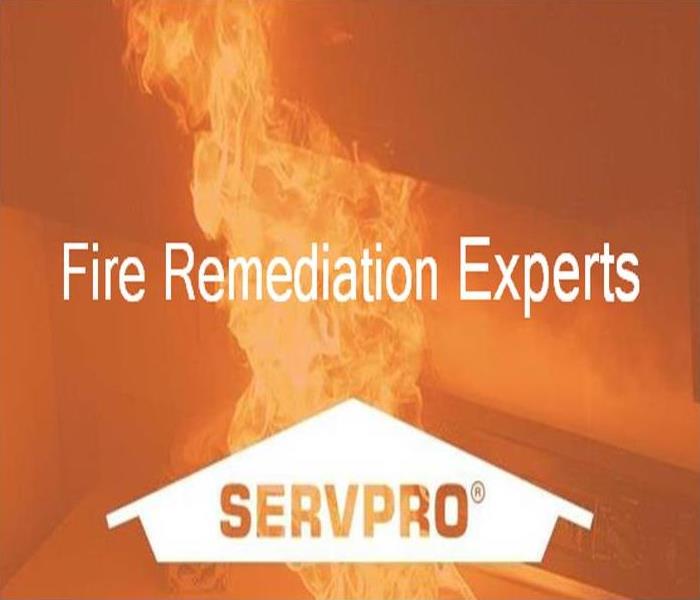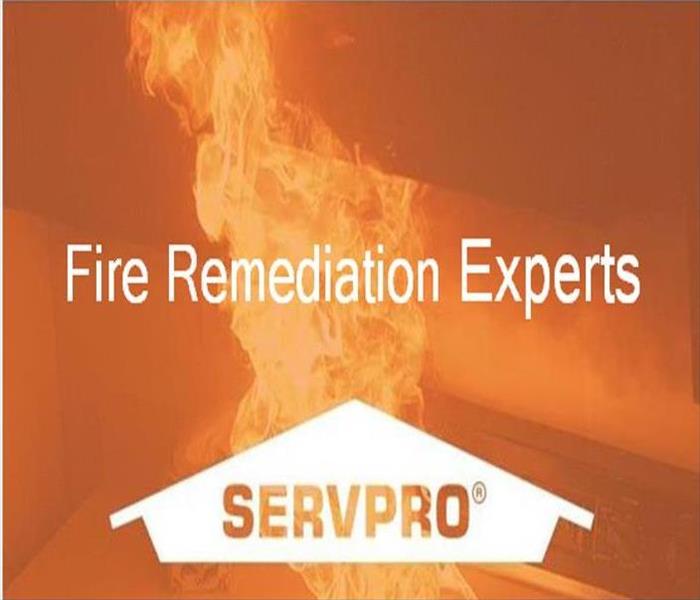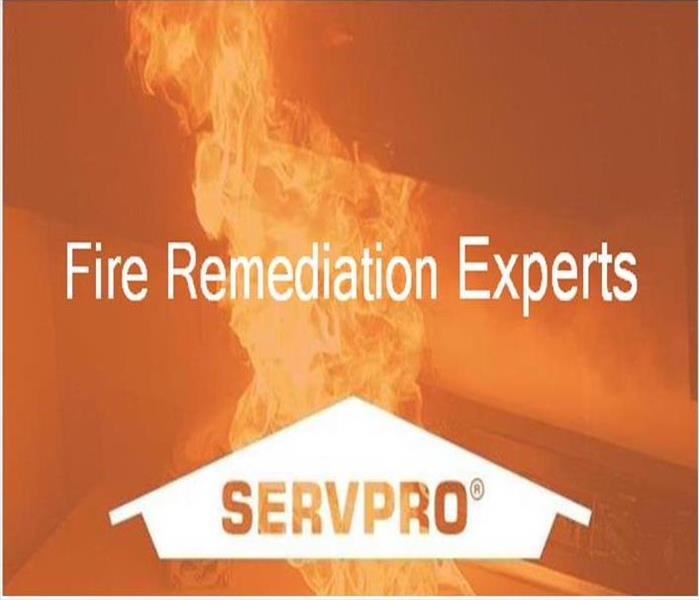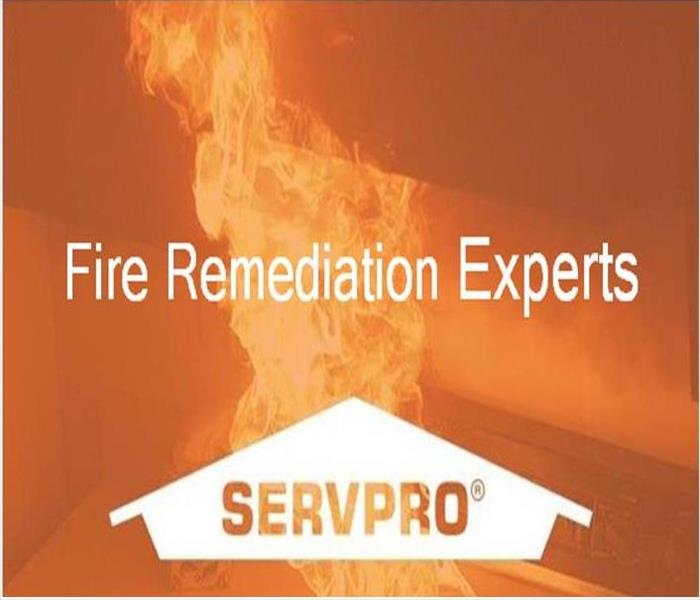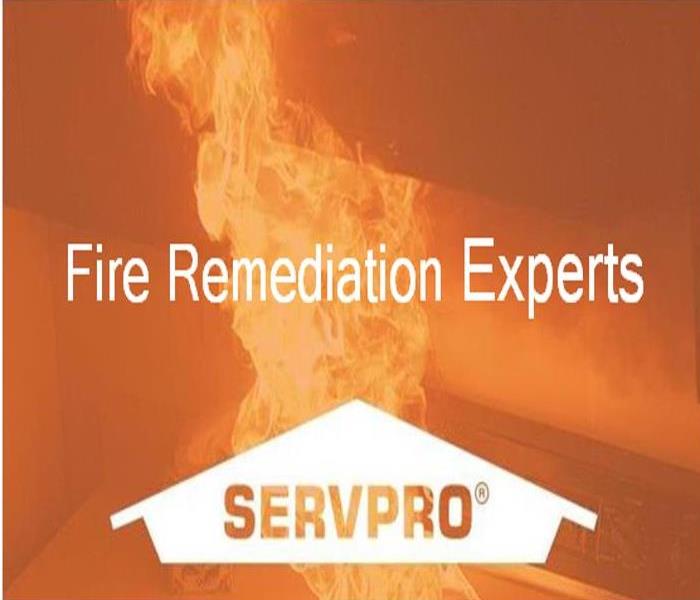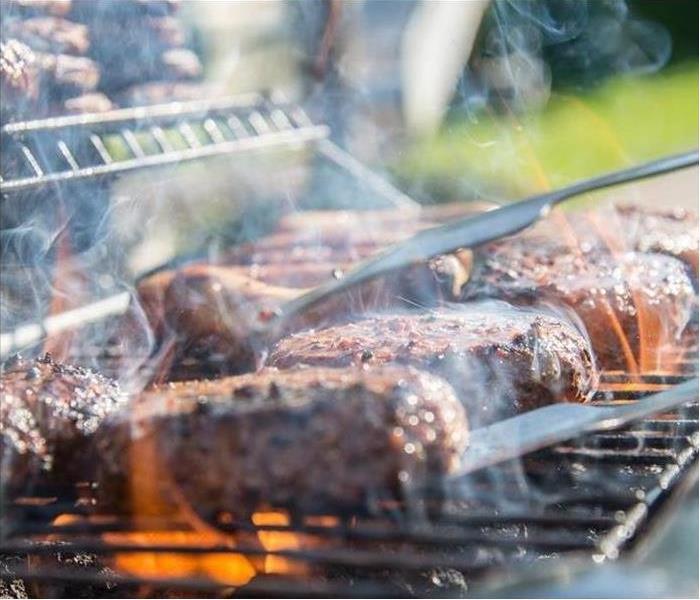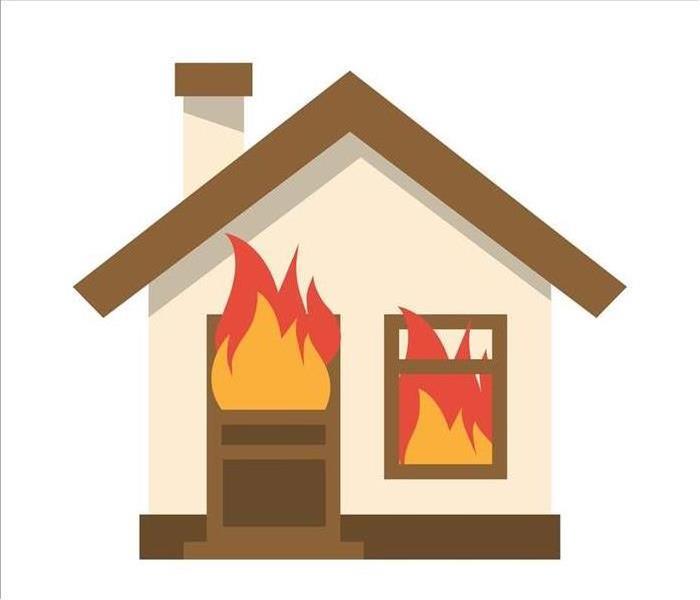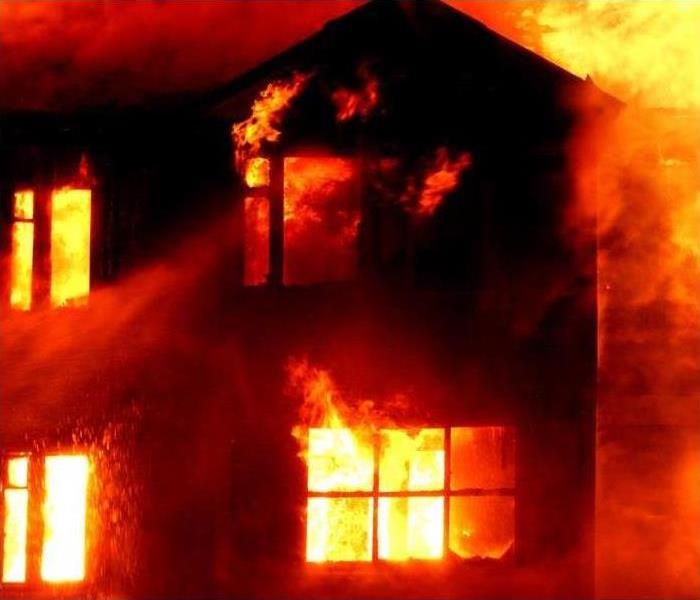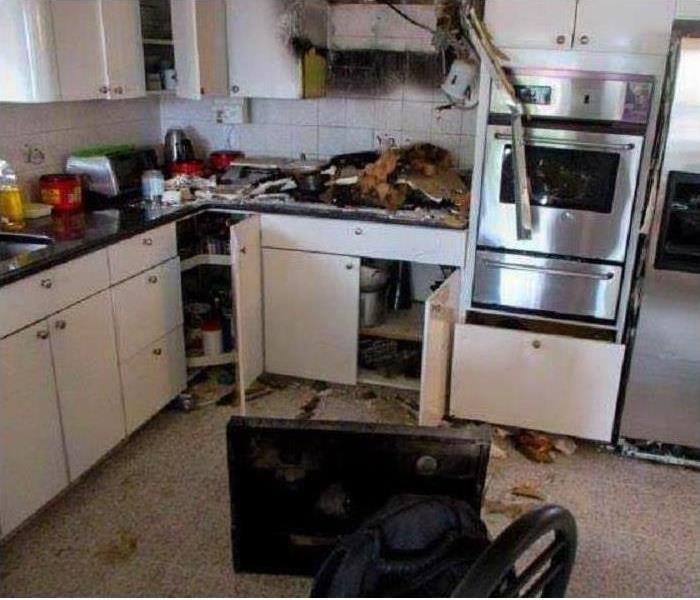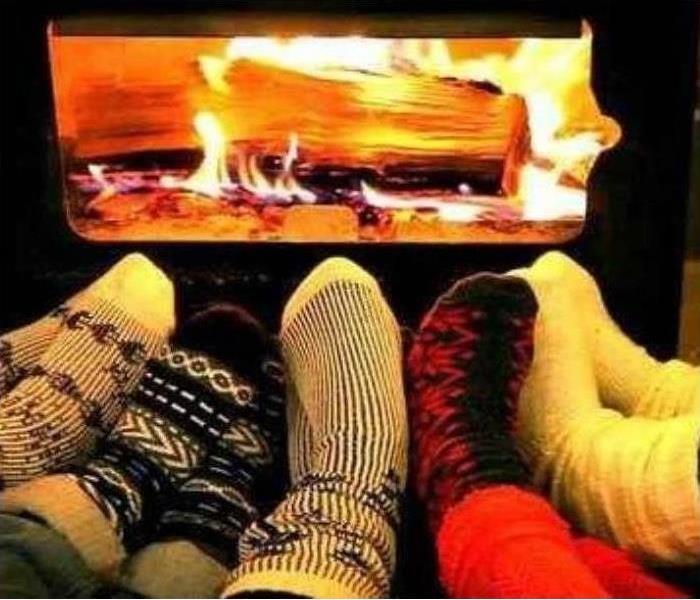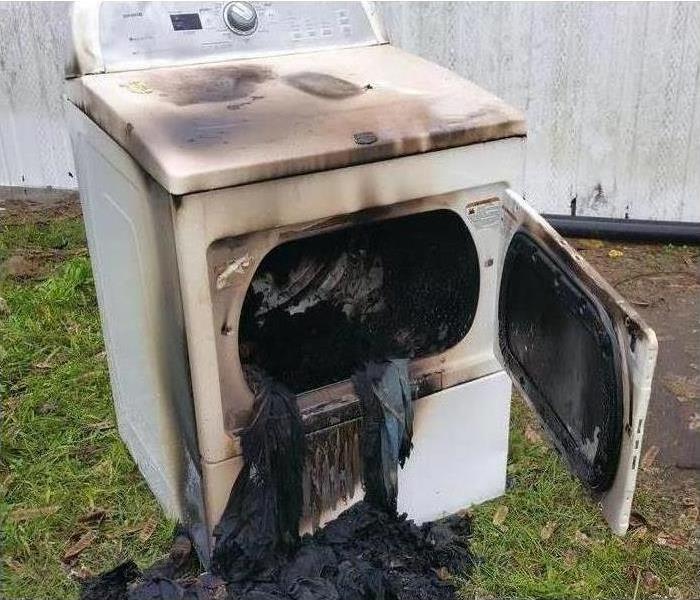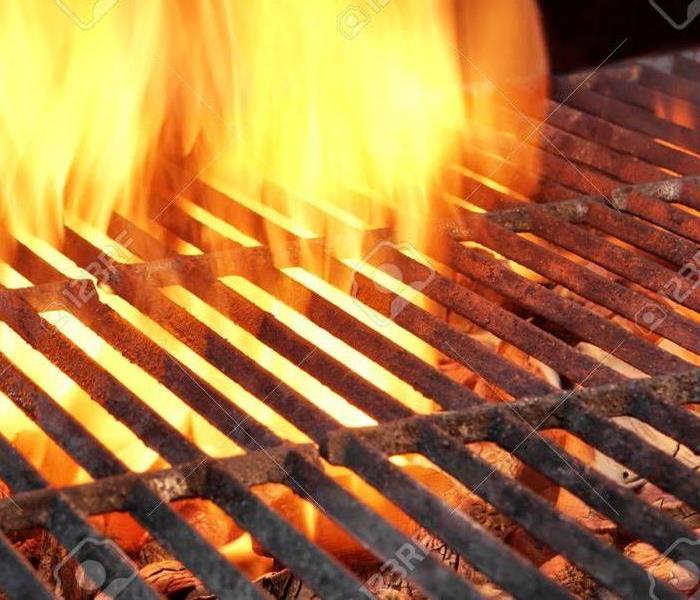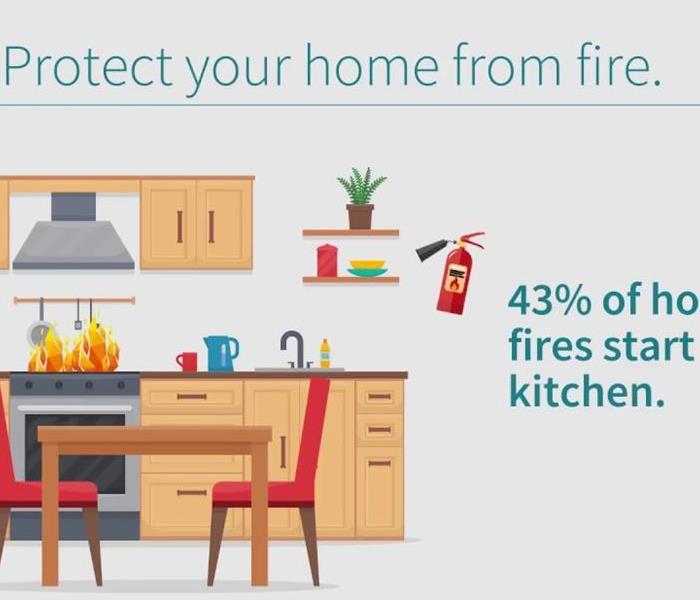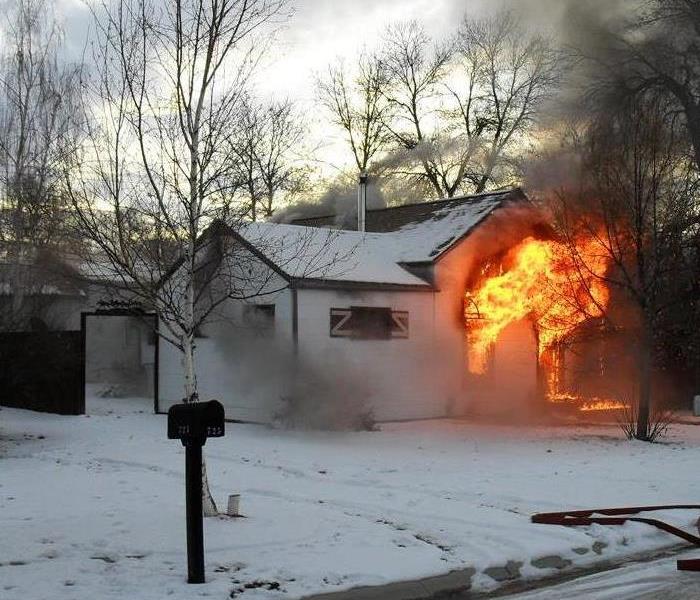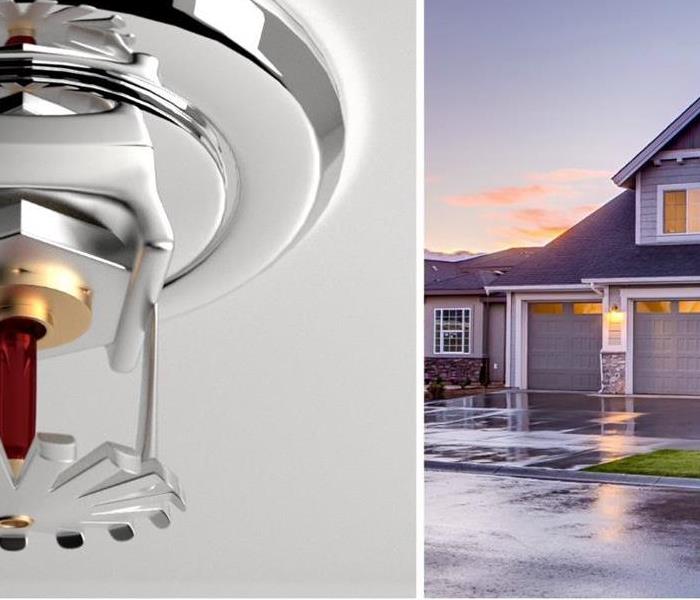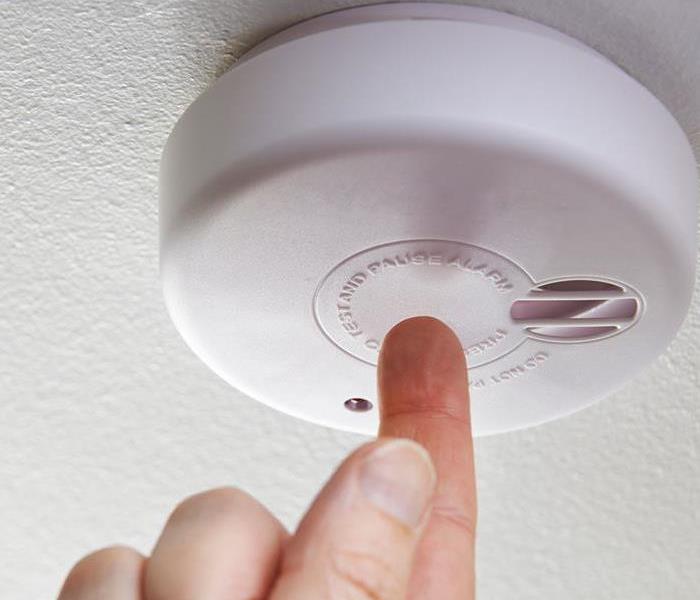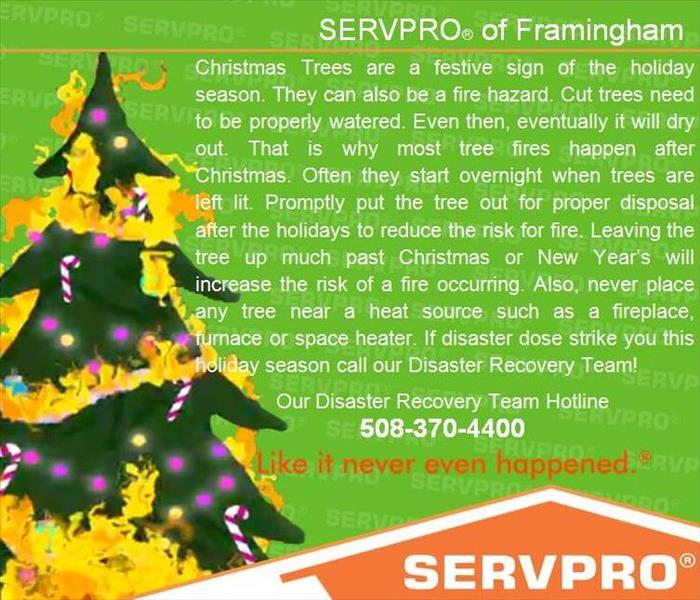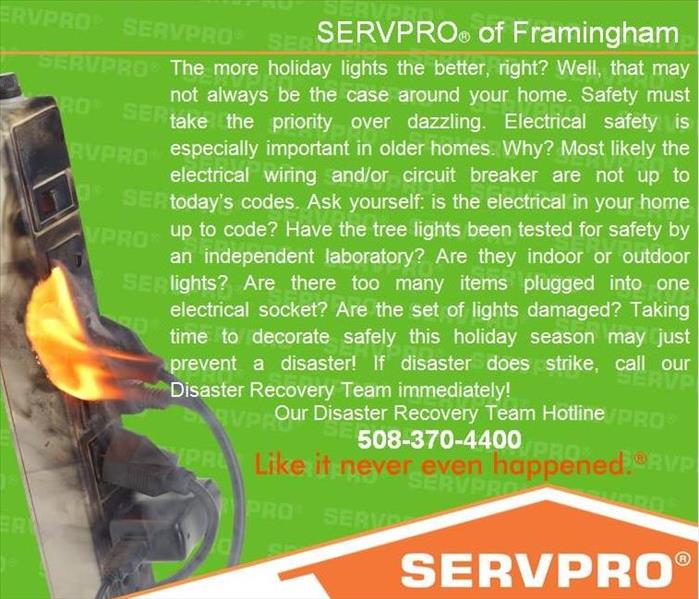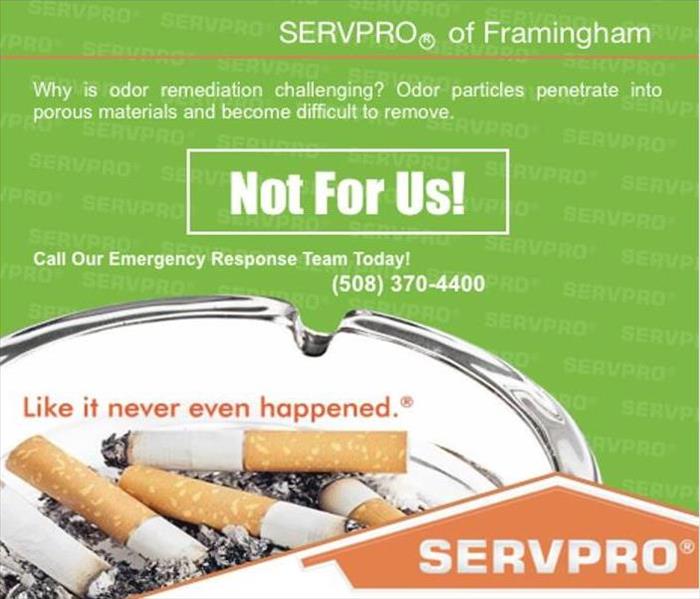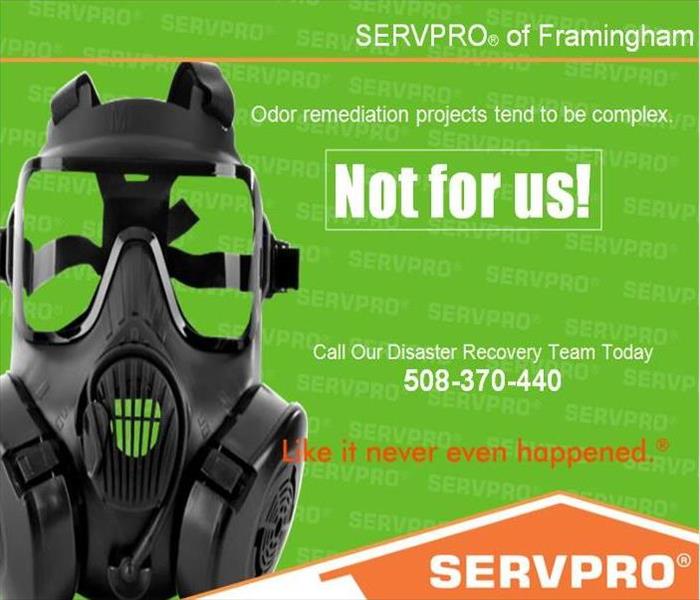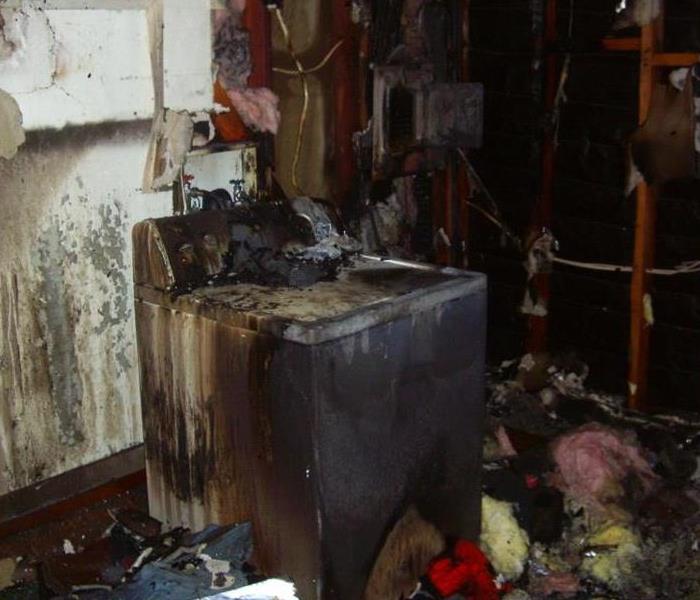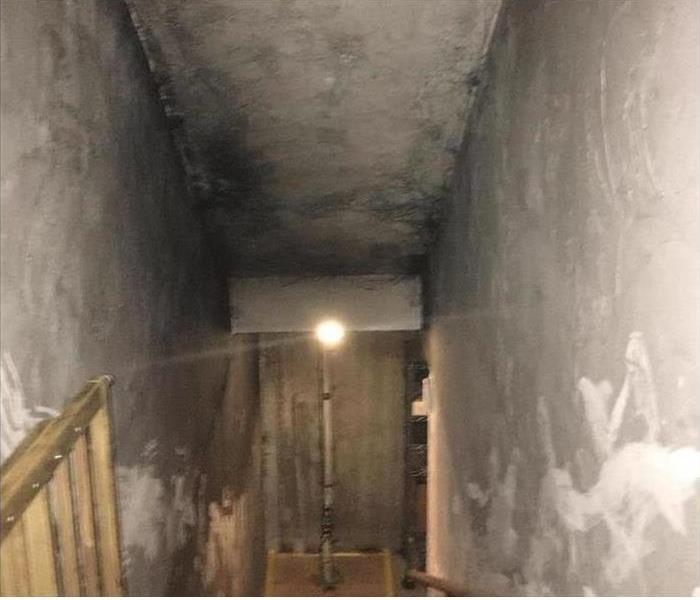Recent Fire Damage Posts
Celebrating Fire Prevention Tips for Homes and Businesses
2/20/2025 (Permalink)
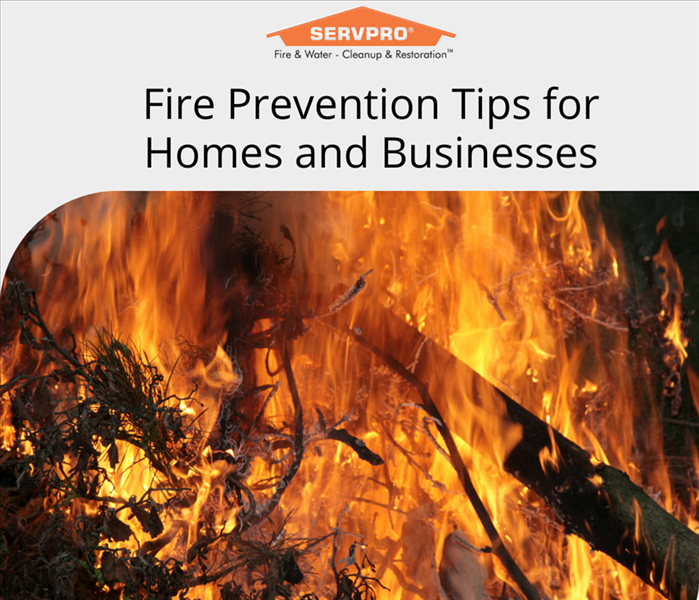 We understand the devastating impact of fires and are committed to helping you take proactive steps to prevent them.
We understand the devastating impact of fires and are committed to helping you take proactive steps to prevent them.
Whether you’re a homeowner or a business owner, fire prevention is essential to keeping your property and loved ones safe.
We understand the devastating impact of fires and are committed to helping you take proactive steps to prevent them. Here are some key fire prevention tips to help safeguard your home or business.
1. Install and Maintain Smoke Alarms
Why It Matters: Smoke alarms provide early warnings that can save lives and minimize property damage.
- For Homes: Install smoke alarms in every bedroom, outside sleeping areas, and on every level of your home.
- For Businesses: Place smoke alarms in areas with high fire risks, such as kitchens, break rooms, and storage areas.
- Test Regularly: Test alarms monthly and replace batteries at least once a year. Replace the entire unit every 10 years.
2. Practice Safe Cooking Habits
Why It Matters: Cooking is a leading cause of home fires and injuries.
- Never leave cooking food unattended.
- Keep flammable items like towels, curtains, and paper away from stovetops.
- For businesses with kitchens, ensure staff are trained on fire safety and proper equipment use.
3. Use Electrical Systems Safely
Why It Matters: Faulty wiring and overloaded circuits are common fire hazards.
- Avoid overloading outlets and power strips.
- Inspect cords for damage, and replace any that are frayed or worn.
- Hire licensed professionals to inspect and repair your electrical systems regularly.
4. Store Flammable Materials Properly
Why It Matters: Flammable liquids and materials can ignite easily if not stored correctly.
- Store flammable materials in their original containers, away from heat sources.
- Businesses should follow OSHA guidelines for handling and storing flammable substances.
5. Create and Practice a Fire Escape Plan
Why It Matters: Knowing what to do during a fire can save lives.
- For Homes: Develop an escape plan that includes two exits from every room and a designated meeting spot. Practice the plan with your family.
- For Businesses: Create an emergency action plan, conduct regular fire drills, and post clear evacuation routes.
6. Use Heating Equipment Safely
Why It Matters: Space heaters and fireplaces are common culprits of winter fires.
- Keep space heaters at least three feet away from flammable objects.
- Ensure chimneys and fireplaces are cleaned and inspected annually.
7. Install Fire Suppression Systems
Why It Matters: Fire extinguishers and sprinklers can stop small fires before they spread.
- Place fire extinguishers in easily accessible locations throughout your property.
- Businesses should invest in automatic sprinkler systems for added protection.
Even with the best prevention measures, fires can still happen. That’s why it’s crucial to have a plan for restoration and recovery. Our highly trained professionals specialize in fire damage restoration, including:
- Smoke and Soot Cleanup
- Odor Removal
- Structural Repairs
As a trusted leader in the restoration industry, SERVPRO of Framingham has the advanced training and equipment needed to restore your home and business.
Fire Damage: What to Do Before Help Arrives
1/16/2025 (Permalink)
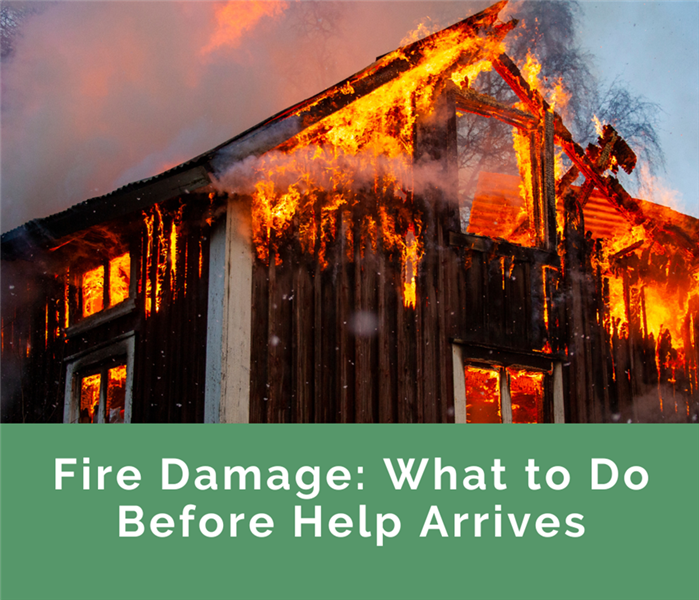 A fire can be devastating, but knowing what to do in the aftermath can make a huge difference.
A fire can be devastating, but knowing what to do in the aftermath can make a huge difference.
A fire can be devastating, but knowing what to do in the aftermath can make a huge difference. Here’s a guide to managing fire damage safely until our team arrives.
1. Prioritize Safety
Your safety comes first. Avoid re-entering the property until it’s declared safe by the fire department. Structural instability, smoke inhalation, and electrical hazards can pose serious risks.
2. Document Damage for Insurance
Take photos and videos of the damage as soon as it’s safe. Documenting the extent of the fire damage helps with insurance claims and ensures proper compensation.
3. Avoid DIY Cleaning
Smoke and soot damage require specialized cleaning methods. Attempting to clean affected areas yourself can spread contaminants or cause further damage. Leave the restoration to experts.
4. Fire and Smoke Restoration Expertise
Once on-site, we will assess the damage, create a restoration plan, and begin cleaning, deodorizing, and repairing your property. Their team is equipped to handle even the most severe fire damage.
As a trusted leader in the restoration industry, SERVPRO of Framingham has the advanced training and equipment needed to restore your home and business.
Home Restoration 101: Recovering from Holiday Cooking Mishaps and Kitchen Fires
12/4/2024 (Permalink)
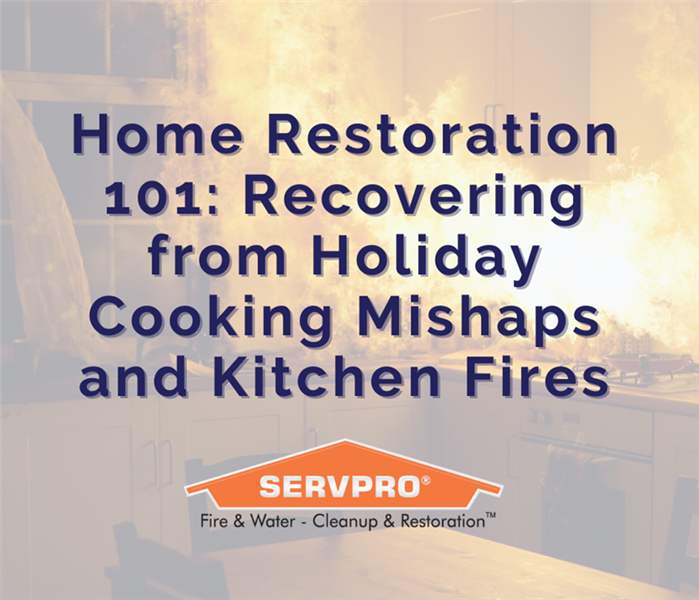 As a trusted leader in the restoration industry, SERVPRO of Framingham has the advanced training and equipment needed to restore your home.
As a trusted leader in the restoration industry, SERVPRO of Framingham has the advanced training and equipment needed to restore your home.
The holiday season is a time for family gatherings, feasts, and, unfortunately, an increase in cooking-related fires. With the kitchen bustling more than usual, accidents can happen, from minor mishaps to small kitchen fires. Knowing how to prevent and respond to these incidents—and how to recover from any damage—can save you time, stress, and money. Here’s your guide to preventing holiday cooking mishaps and restoring your kitchen if the unexpected happens.
Preventing Holiday Cooking Fires
Before diving into restoration tips, it’s essential to know how to minimize the risk of a cooking fire in the first place. Here are some key precautions:
- Stay Present and Alert in the Kitchen
With so many holiday activities going on, it’s easy to get distracted. Make it a rule to never leave a hot stovetop or oven unattended. If you need to step away, turn off the heat temporarily. - Avoid Cooking with Loose Clothing
Loose clothing or long sleeves can catch fire easily. Opt for snug, short-sleeved attire or roll up your sleeves when cooking. - Keep Flammable Items Away from Heat Sources
Make sure that towels, paper towels, and wooden utensils are kept far from open flames or hot surfaces. A clear workspace can help prevent accidental fires. - Have a Fire Extinguisher on Hand
In the event of a small kitchen fire, a fire extinguisher within reach can quickly contain the flames. Make sure your extinguisher is rated for kitchen use and know how to operate it. - Be Cautious with Oil and Grease
Grease fires are one of the most common causes of kitchen fires. If you’re cooking with oil, watch it carefully, as it can quickly overheat. Remember: never use water on a grease fire, as it can make the flames spread.
Immediate Steps if a Cooking Fire Occurs
Even with precautions, cooking accidents can still happen. If a fire starts, here’s what to do:
- Turn Off the Heat Source
For a stovetop fire, immediately turn off the burner. If it’s an oven fire, turn off the heat and keep the door closed to starve the flames of oxygen. - Use a Lid or Baking Sheet
For small stovetop fires, cover the pan with a metal lid or baking sheet to suffocate the flames. Never use water or flour, as both can worsen the fire. - Use a Fire Extinguisher if Needed
If the flames are too large to handle with a lid, use a fire extinguisher to put it out. Call emergency services if the fire gets out of control. - Ventilate the Area
After putting out the fire, open windows or use fans to clear out any smoke and lingering fumes. Avoid turning on your kitchen vent hood until it’s been checked for damage.
Recovering from Fire or Smoke Damage in Your Kitchen
If a cooking mishap leaves you with fire or smoke damage, don’t worry—there are effective steps you can take to restore your kitchen to its former glory.
1. Assess the Extent of the Damage
Start by examining the affected areas closely. Soot and smoke stains can sometimes look worse than they are, so determine if the damage is superficial or if deeper cleaning and repairs are necessary.
2. Clear Out Soot and Smoke Residue
Soot on Surfaces: Use a vacuum with a brush attachment to remove loose soot from surfaces. Avoid wiping, as it can smear the soot and make it harder to clean.
Smoke Residue: For counters, walls, and cabinets, mix a solution of water, vinegar, and a mild detergent. Apply it with a sponge or cloth, using gentle, circular motions. Rinse the surfaces with clean water to remove residue, and repeat if necessary.
3. Address Lingering Smoke Odors
Ventilation: Open all windows and use fans to create cross-ventilation. Let fresh air circulate as much as possible.
Baking Soda and Vinegar: Sprinkle baking soda on soft surfaces like upholstery or carpets to absorb odors. For cabinets and walls, wipe down with a vinegar solution.
Activated Charcoal or Air Purifiers: Place activated charcoal or use air purifiers with HEPA filters in the kitchen. Both can help neutralize smoke odors over time.
4. Deep Clean Kitchen Appliances
Oven and Stovetop: If the fire started in your oven, follow your appliance’s manual for deep cleaning recommendations. Avoid harsh chemicals that can release fumes when heated again.
Vent Hood and Filters: Smoke and grease can accumulate in the range hood, creating lingering smells. Remove and clean the vent filters, replacing them if necessary.
5. Consider Professional Help for Extensive Damage
If smoke damage extends beyond the kitchen or has penetrated walls and ceilings, calling in a professional restoration service might be necessary. Restoration professionals can effectively remove stubborn smoke residues and lingering odors with specialized equipment and techniques.
6. Repairing Damaged Areas
Cabinet and Counter Repairs: If your cabinets or counters sustained burns or stains that won’t come out, you may need to sand, repaint, or replace them. Simple cabinet repairs can often restore them to a nearly new look.
Replacing Flooring: Fire and water can cause flooring to warp or stain. If minor scrubbing doesn’t help, consider patching or replacing damaged sections to fully restore your kitchen.
Preventing Future Kitchen Mishaps
To keep your kitchen safe year-round, establish a few safety routines:
- Regularly clean your oven, stovetop, and vent hood to reduce grease buildup.
- Test your smoke detectors every month to ensure they’re functioning.
- Review kitchen fire safety steps with your family so everyone knows what to do if an accident happens.
Cooking-related fires are common during the holiday season, but a few preventative measures and a solid restoration plan can make a huge difference. With these tips, you’ll be ready to handle any kitchen mishaps that come your way, ensuring a safe, festive season for you and your family.
As a trusted leader in the restoration industry, SERVPRO of Framingham has the advanced training and equipment needed to restore your home and business. Give us a call today!
Holiday Cooking Safety: Tips to Prevent Kitchen Fires
11/15/2024 (Permalink)
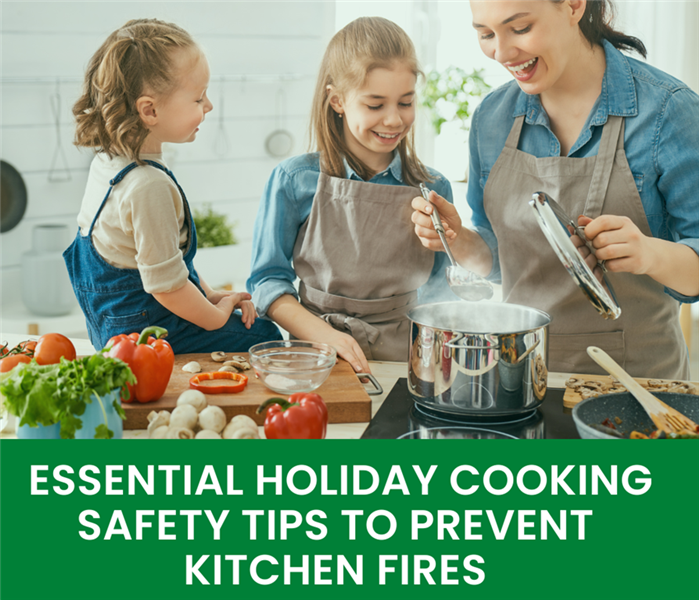 The holiday season is a time for family, friends, and feasting, but it’s also a time when kitchen fires can become a real threat.
The holiday season is a time for family, friends, and feasting, but it’s also a time when kitchen fires can become a real threat.
The holiday season is a time for family, friends, and feasting, but it’s also a time when kitchen fires can become a real threat. With all the hustle and bustle in the kitchen, it’s essential to prioritize safety while preparing delicious meals. Here are some vital tips to help you prevent kitchen fires this holiday season.
1. Stay Alert While Cooking
One of the leading causes of kitchen fires is unattended cooking. Whether you’re frying, grilling, or simmering, always stay in the kitchen when using the stove. If you must leave for any reason, turn off the heat. Additionally, keep flammable items like oven mitts, towels, and paper products away from heat sources to minimize fire risks.
2. Check Your Smoke Alarms
Before you start cooking up a storm, ensure your smoke alarms are in good working order. Test them by pressing the test button, and replace batteries if necessary. Working smoke alarms are your first line of defense against potential fires, giving you valuable time to react in case of an emergency.
3. Avoid Overloading Outlets
With holiday lights, cooking appliances, and other electrical devices running, it’s easy to overload your outlets. Overloading can lead to overheating and electrical fires. Be mindful of your outlet use, and consider using surge protectors to safely distribute power.
4. Monitor Candles
Candles can add a warm, festive glow to your holiday décor, but they also pose fire hazards. Always place candles away from flammable materials like curtains, decorations, or wrapping paper. Never leave them burning unattended, and extinguish them before leaving the room or going to bed.
5. Deep Frying Turkey?
If you plan to deep fry a turkey this holiday season, exercise extreme caution. Always perform this task outdoors on a flat, non-flammable surface to avoid accidents. Ensure your turkey is fully thawed before frying to prevent dangerous oil splatters that can lead to flare-ups.
6. Clean Your Oven and Stove Vents
Grease buildup in your oven and stove vents can significantly increase the risk of fires. Regularly clean these areas to prevent grease fires from interrupting your holiday meal. Make it a habit to check and clean your oven and stove hood filters to ensure they are free from grease and debris.
By following these tips, you can enjoy a festive and safe holiday cooking experience. Remember, prevention is key to ensuring that your holiday celebrations are filled with joy rather than disaster. Stay safe, and happy holidays!
As a trusted leader in the restoration industry, SERVPRO of Framingham has the advanced training and equipment needed to restore your home and business. Give us a call at (508) 370-4400
Fire Prevention in Commercial Buildings: How to Protect Your Business During Heating Season
11/6/2024 (Permalink)
 Heating equipment, space heaters, and electrical malfunctions are common causes of commercial fires
Heating equipment, space heaters, and electrical malfunctions are common causes of commercial fires
As temperatures drop and heating systems power up, the risk of fire in commercial buildings increases significantly. Heating equipment, space heaters, and electrical malfunctions are common causes of commercial fires, especially during the colder months. For business owners, it’s essential to take proactive steps to minimize these risks and protect both property and employees. Let’s cover the fire hazards associated with heating season and provide actionable fire prevention tips to help keep your business safe.
Common Fire Risks During Heating Season
Understanding the fire risks associated with heating season can help you better prepare your building. Here are the most common culprits:
- Heating Systems
While necessary for keeping your business warm, heating systems can pose a fire hazard if not properly maintained. Malfunctioning furnaces, boilers, and heat pumps can lead to overheating, gas leaks, and electrical fires. Dust accumulation on heating elements and clogged vents can also contribute to fire risks. - Space Heaters
Space heaters are a convenient way to supplement heat, especially in areas where central heating doesn’t reach. However, they are responsible for a significant number of workplace fires each year. Space heaters can easily overheat, tip over, or ignite nearby combustible materials like paper, curtains, or furniture. - Electrical Malfunctions
Electrical fires are another major concern during heating season, especially when heating systems and appliances strain your building’s electrical load. Faulty wiring, overloaded circuits, and damaged electrical cords can all lead to sparks and fires. Older buildings are especially at risk if their electrical systems haven’t been updated to handle modern power demands. - Flammable Materials Near Heat Sources
Storing flammable materials like cleaning supplies, paper, or chemicals too close to heating systems, furnaces, or space heaters can quickly turn a small spark into a major fire. Even something as simple as a piece of furniture placed too close to a space heater can catch fire and spread rapidly.
Fire Prevention Tips for Business Owners
Preventing fires in your commercial property requires a combination of regular maintenance, employee awareness, and safety protocols. Follow these actionable tips to reduce fire risks during heating season:
1. Schedule Regular Heating System Inspections
Your building’s heating system should be inspected and serviced annually by a licensed HVAC professional. This ensures that your system is running efficiently and safely. During the inspection, the technician will check for any issues such as gas leaks, faulty wiring, or clogged vents that could pose a fire risk. Regular maintenance can prevent small problems from turning into dangerous malfunctions.
- Clean Filters and Vents: Clogged filters and vents can restrict airflow, causing the system to overheat. Regularly clean or replace filters to maintain proper airflow and reduce the risk of fire.
- Test Smoke and Carbon Monoxide Detectors: Make sure all smoke detectors and carbon monoxide detectors are working properly, especially near heating equipment. These devices can provide early warnings of a fire or gas leak.
2. Set Space Heater Safety Guidelines
If your employees use space heaters, it’s critical to establish clear safety rules to prevent accidents:
- Only Use Certified Heaters: Make sure all space heaters are certified by a recognized testing laboratory (e.g., UL or ETL) and have safety features like automatic shut-off if tipped over.
- Keep Heaters Away from Combustibles: Ensure that space heaters are placed at least three feet away from any flammable materials, including paper, furniture, or curtains.
- Turn Off When Unattended: Space heaters should be turned off when no one is in the room or at the end of the workday. Consider using space heaters with automatic timers to ensure they don’t accidentally remain on overnight.
- Use Proper Outlets: Avoid plugging space heaters into power strips or extension cords, as this can overload circuits and lead to an electrical fire. Instead, plug space heaters directly into wall outlets.
3. Conduct Electrical Safety Checks
Electrical systems are often under more strain during heating season, so it’s important to ensure your building’s wiring can handle the increased load:
- Inspect Electrical Outlets and Cords: Check for frayed or damaged cords, loose outlets, or any signs of electrical wear and tear. Replace damaged cords immediately, and avoid running cords under carpets or across doorways, where they can be pinched or damaged.
- Monitor Electrical Load: Ensure that your building’s electrical circuits are not being overloaded, especially with the increased use of heating equipment. Consider having an electrician perform an electrical load test to ensure your system is up to code.
- Install Ground Fault Circuit Interrupters (GFCIs): GFCIs protect against electrical shocks and fires, especially in wet or damp areas like kitchens and bathrooms. Make sure your building has GFCI outlets installed in these areas.
4. Create a Fire-Safe Workspace
Keep your workspace free of potential fire hazards by following these fire safety practices:
- Clear Combustible Clutter: Avoid storing flammable materials near heat sources. This includes keeping cleaning chemicals, paper, and boxes away from furnaces, heaters, and electrical outlets.
- Designate a Smoking Area: If your business allows smoking, make sure there is a designated smoking area outside, far from the building. Provide proper disposal containers for cigarettes to prevent fires from improperly discarded butts.
- Ensure Fire Extinguishers Are Accessible: Place fire extinguishers in easily accessible locations throughout the building, especially near high-risk areas like kitchens, mechanical rooms, and employee break rooms. Make sure employees are trained in how to use them properly.
5. Train Employees on Fire Safety
Regular fire safety training is essential to ensuring that all employees know how to prevent and respond to a fire. Include the following topics in your fire safety training:
- How to Use a Fire Extinguisher: Ensure that employees are familiar with the PASS method—Pull, Aim, Squeeze, and Sweep—for using a fire extinguisher.
- Evacuation Procedures: Develop and communicate a clear fire evacuation plan, including the location of exits and assembly points. Hold regular fire drills to practice the procedure.
- Reporting Hazards: Encourage employees to report any potential fire hazards, such as damaged electrical cords or malfunctioning heating equipment, to the appropriate personnel immediately.
As heating season ramps up, so does the risk of fires in commercial buildings. By taking proactive steps like scheduling heating system inspections, establishing space heater safety guidelines, conducting electrical safety checks, and creating a fire-safe workspace, you can significantly reduce the risk of fire at your business.
Fire prevention is about being prepared. Regular maintenance, employee awareness, and adherence to safety protocols can help protect your business from the devastating effects of a fire. Don’t wait until disaster strikes—start implementing these fire prevention tips today to ensure a safe and productive heating season.
If you need assistance preparing your commercial property for fire safety this winter, our team of experts is here to help with fire risk assessments, inspections, and preventive maintenance. Contact us to learn more about how we can keep your business safe during the colder months.
As a trusted leader in the restoration industry, SERVPRO of Framingham has the advanced training and equipment needed to restore your home and business. Give us a call at (508) 370-4400
How Candles Can Cause Fires and How to Prevent Them
10/18/2024 (Permalink)
 Candles add a touch of elegance and warmth to any environment, but they come with inherent risks.
Candles add a touch of elegance and warmth to any environment, but they come with inherent risks.
Candles create a warm, inviting atmosphere, making them a popular choice for lighting, decoration, and relaxation. However, despite their beauty and charm, candles can also pose serious fire hazards if not used properly. Understanding the risks and learning how to use candles safely is crucial for preventing potential fires. Here’s a comprehensive look at how candles can cause fires and how you can mitigate these risks.
1. How Candles Can Cause Fires
Candles are a common source of residential fires. Here are some of the main ways they can become dangerous:
- Unattended Flames: One of the most common causes of candle-related fires is leaving candles unattended. A candle’s flame can easily ignite nearby flammable materials if not watched closely.
- Improper Placement: Placing candles near combustible materials like curtains, paper, or furniture can lead to a fire. Candles should always be placed on a stable, heat-resistant surface away from anything that could catch fire.
- Overuse of Decorative Candles: Candles with decorative elements like leaves, feathers, or ribbons can catch fire if they get too close to the flame. These decorations can be highly flammable and should be avoided or used with caution.
- Failure to Trim Wicks: A wick that’s too long can cause a candle to burn too hot and lead to excessive flame height. This increases the risk of the candle catching nearby materials on fire. It’s essential to trim the wick to about ¼ inch before each use.
- Old or Damaged Candles: Candles that are old or have been improperly stored can become unstable. Cracked or damaged candles can cause uneven burning and increase the risk of fire.
2. Safety Tips for Using Candles
To enjoy the ambiance of candles without compromising safety, follow these important tips:
- Never Leave a Candle Unattended: Always keep an eye on burning candles. Extinguish them before leaving the room or going to sleep.
- Use Candle Holders: Place candles in sturdy, heat-resistant holders that are designed to catch wax drips and contain the flame. Ensure the holder is on a stable, non-flammable surface.
- Keep Candles Away from Flammable Items: Ensure that candles are placed away from curtains, paper, bedding, and other flammable materials. Avoid placing candles in areas where they can be easily knocked over.
- Keep Out of Reach of Children and Pets: Children and pets can accidentally knock over candles or get too close to the flame. Keep candles in locations that are out of their reach.
- Trim Wicks Regularly: Before lighting a candle, trim the wick to about ¼ inch. This helps to control the size of the flame and reduces the risk of a large, uncontrolled fire.
- Extinguish Candles Safely: Use a candle snuffer to extinguish the flame rather than blowing it out, which can spread hot wax. Make sure the candle is completely out and the wick is no longer glowing before leaving it unattended.
3. Alternative Options
If you’re concerned about the risks of traditional candles, consider these safer alternatives:
- Battery-Operated Candles: LED candles offer the appearance of real candles without the fire risk. They can be used safely in many settings and often come with timers and remote controls.
- Electric Wax Warmers: These devices melt wax without a flame, providing the pleasant scent of a candle without the fire risk.
- Scented Oil Diffusers: For a fragrance boost, consider using an oil diffuser. These devices disperse essential oils into the air and are generally safer than burning candles.
4. What to Do in Case of a Candle-Related Fire
In the event of a candle-related fire, act quickly:
- Evacuate Immediately: If a fire occurs, get out of the building as quickly and safely as possible.
- Call 911: Once you are in a safe location, call emergency services to report the fire.
- Do Not Try to Extinguish Large Fires: Leave the firefighting to professionals. Focus on getting yourself and others to safety.
Candles add a touch of elegance and warmth to any environment, but they come with inherent risks. By following safety guidelines and considering alternative products, you can enjoy the beauty of candles while minimizing the risk of fire.
SERVPRO of Framingham is your comprehensive solution for residential and commercial restoration and cleaning services. Our highly trained technicians are available 24/7 to address any water, fire, or storm damage in Framingham, Sudbury, Hopkinton, Ashland, and surrounding areas.
Fire Safety Week: Essential Tips to Keep Your Home and Family Safe
9/27/2024 (Permalink)
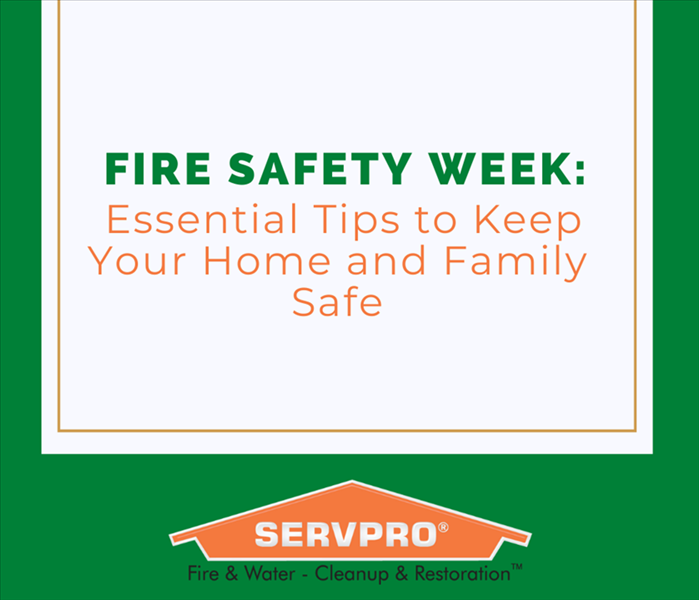 Fire Prevention Week is a perfect opportunity to focus on fire safety, but these habits should be practiced year-round.
Fire Prevention Week is a perfect opportunity to focus on fire safety, but these habits should be practiced year-round.
Fire Safety Week is an annual campaign dedicated to educating families and communities about fire hazards and how to prevent them. This year’s theme emphasizes the importance of preparation and being proactive regarding fire safety. By understanding the risks and implementing key safety measures, you can protect your loved ones and home from potential disasters in Framingham MA. Here’s how you can take action this Fire Safety Week.
1. Check Your Smoke Alarms
Smoke alarms are your first defense against a fire, providing early warnings that give you and your family crucial time to escape. Here’s what you need to do:
- Test alarms regularly: Test all smoke alarms in your home once a month to ensure they function correctly.
- Change the batteries: Replace the batteries in your smoke alarms at least once a year. A good rule of thumb is to change them when you change your clocks for daylight saving time.
- Install alarms in key areas: Every bedroom, hallway, and level of your home should have a smoke alarm.
2. Create a Family Fire Escape Plan
In a fire, every second counts. Having a clear escape plan can save lives. Take time to:
- Identify two exits per room: If one exit is blocked, having a second way out is essential.
- Designate a meeting spot: Choose a safe place outside, away from the house, where everyone should meet in case of a fire.
- Practice regularly: Conduct fire drills with your family at least twice a year so everyone knows what to do in an emergency.
3. Stay Safe in the Kitchen
Cooking is the leading cause of home fires. Here are some simple precautions to prevent kitchen fires:
- Never leave cooking unattended: If you must leave the kitchen, turn off the stove or have someone watch over the cooking.
- Keep flammable objects away from the stove: This includes dish towels, paper towels, and oven mitts.
- Have a fire extinguisher nearby: Know how to use it properly in case of a small fire.
4. Practice Space Heater Safety
As colder weather approaches, space heaters become a common fire risk. Follow these tips to stay warm safely:
- Keep space heaters at least 3 feet away from anything flammable. This includes furniture, curtains, and bedding.
- Turn off heaters when you leave the room or go to bed. Never leave them unattended.
5. Stop Fires Before They Start
While we can't predict when or where a fire will break out, we can reduce the chances by taking proactive steps:
- Keep your home clutter-free: Especially around areas that are prone to fires, like the kitchen and around electrical outlets.
- Check electrical cords: Damaged or frayed wires can cause sparks and lead to fires. Replace cords immediately if you see wear and tear.
- Store flammable materials safely: Items like gasoline, cleaning supplies, and aerosol cans should be kept in well-ventilated areas, away from heat sources.
6. Use Candles Responsibly
While candles can create a cozy atmosphere, they’re also a common fire hazard. If you use candles, be sure to:
- Blow them out before leaving the room. Never leave a candle unattended, especially if children or pets are present.
- Use sturdy candle holders. Make sure the holder is on a flat, stable surface, and away from flammable objects.
Fire Prevention Week is a perfect opportunity to focus on fire safety, but these habits should be practiced year-round. By taking the time to check alarms, create a fire escape plan, and follow these safety tips, you can make your home, in Framingham, a safer place for you and your loved ones.
SERVPRO of Framingham is your comprehensive solution for residential and commercial restoration and cleaning services. Our highly trained technicians are available 24/7 to address any water, fire, or storm damage in Framingham, Sudbury, Hopkinton, Ashland, and surrounding areas.
The Do’s and Don’ts of Fall Leaf Burning
9/7/2024 (Permalink)
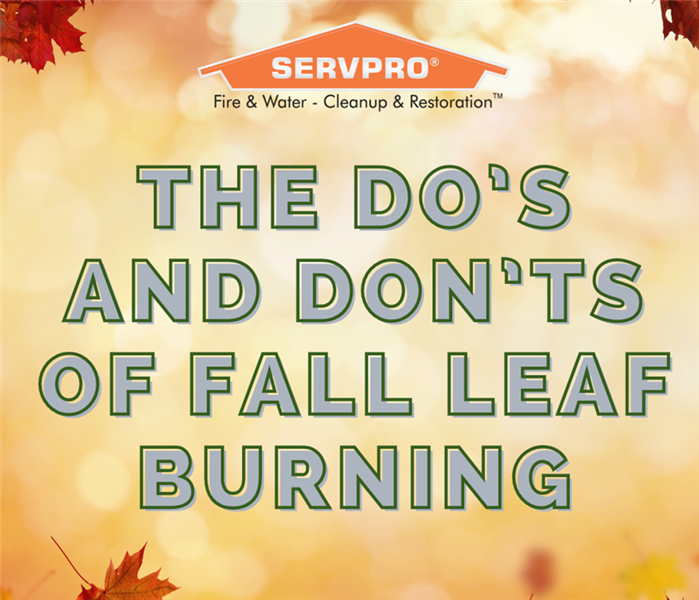 If you’re considering burning your leaves this fall, it’s crucial to do so safely. Improper leaf burning can lead to wildfires and air pollution.
If you’re considering burning your leaves this fall, it’s crucial to do so safely. Improper leaf burning can lead to wildfires and air pollution.
As the leaves begin to change color and fall, many homeowners find themselves with an abundance of leaves in their yards. While some opt for composting or mulching, others choose to burn their leaves. If you’re considering burning your leaves this fall, it’s crucial to do so safely. Improper leaf burning can lead to wildfires, air pollution. Here’s a guide to help you burn your leaves safely and responsibly in Framingham.
The Do’s of Leaf Burning
- Check Local Regulations: Before you even consider burning leaves, it’s important to check your local laws and regulations. Some municipalities have strict rules or outright bans on leaf burning due to environmental concerns or fire risks. Always verify if a permit is needed and understand the guidelines you must follow.
- Choose a Safe Location: Pick a location that’s far from your home, sheds, fences, trees, or any other structures. Ensure there’s at least a 50-foot distance between the burning area and any buildings or flammable materials. A flat, open area with little wind is ideal.
- Create a Firebreak: A firebreak is a barrier that prevents the spread of fire. Surround your burn area with a firebreak made of bare soil or non-flammable materials, such as gravel. This helps contain the fire and keeps it from spreading to unintended areas.
- Burn on a Calm, Dry Day: Wind can cause embers to spread quickly, so only burn on a day with little to no wind. Additionally, wet leaves don’t burn well and can create excessive smoke, so choose a dry day for burning.
- Have Water and Tools Ready: Always have a hose, buckets of water, or a fire extinguisher nearby in case the fire gets out of control. A rake or shovel can also help you manage the fire by spreading out the leaves or smothering any rogue flames.
The Don’ts of Leaf Burning
- Don’t Burn Large Piles: Burning a large pile of leaves can be difficult to control. Instead, burn small piles, adding more leaves as the previous ones burn down. This will make it easier to manage the fire and reduce the risk of it spreading.
- Don’t Burn Near Vegetation or Wooded Areas: Burning leaves too close to trees, bushes, or other vegetation can cause the fire to spread quickly. Always maintain a safe distance from any vegetation to prevent accidental wildfires.
- Don’t Leave the Fire Unattended: Never leave a burning pile of leaves unattended. Stay with the fire at all times, and only burn as much as you can monitor. If you need to step away, extinguish the fire completely before doing so.
- Don’t Burn in High Winds or During a Drought: Wind can carry embers far beyond your burn area, potentially igniting other areas. Similarly, dry conditions during a drought increase the likelihood of wildfires. Avoid burning leaves under these conditions to prevent accidental fires.
- Don’t Use Accelerants: Using gasoline, lighter fluid, or other accelerants to start or maintain your fire is dangerous. These substances can cause the fire to become uncontrollable, leading to serious accidents or injuries. Stick to natural methods, such as matches or a lighter, to start your fire.
Alternative Leaf Disposal Methods
If burning leaves seems too risky, consider these safer alternatives:
- Composting: Turn your leaves into nutrient-rich compost for your garden. Over time, they’ll break down and create a valuable soil amendment.
- Mulching: Shred the leaves and use them as mulch around your plants and trees. This not only recycles the leaves but also helps retain moisture in the soil and suppresses weeds.
- Municipal Collection: Many towns offer curbside leaf collection services. Check with your local government to see if this is an option for you.
Burning leaves can be a convenient way to deal with autumn’s bounty, but it comes with risks. By following these safety tips and considering alternative disposal methods, you can enjoy the fall season without putting yourself, your property, or your community in danger.
SERVPRO of Framingham is your comprehensive solution for residential and commercial restoration and cleaning services. Our highly trained technicians are available 24/7 to address any water, fire, or storm damage in Framingham, Sudbury, Hopkinton, Ashland, and surrounding areas.
Fire Safety During Summer Storms: Tips to Protect Your Property in Hopkinton
8/2/2024 (Permalink)
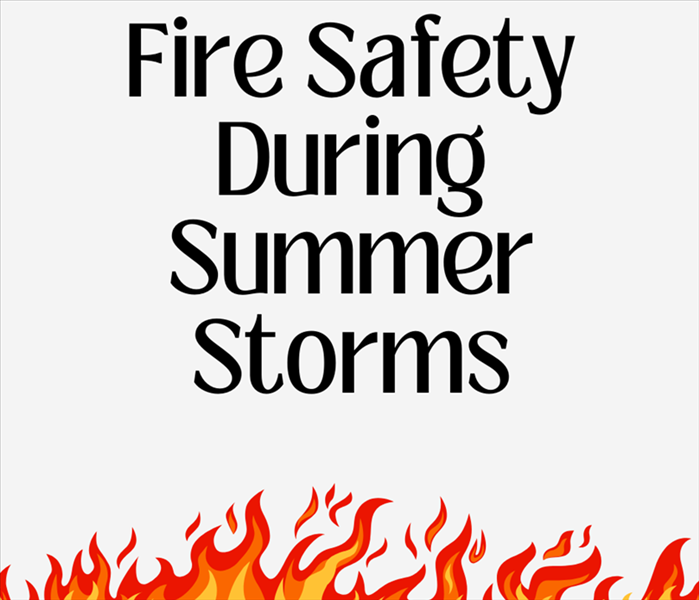 Summer storms bring unique fire hazards that can pose significant risks to your property.
Summer storms bring unique fire hazards that can pose significant risks to your property.
Summer storms bring unique fire hazards that can pose significant risks to your property.
Lightning strikes, downed power lines, and other storm-related issues can ignite fires, making it crucial to take proactive measures to safeguard your home. Here are some essential tips to protect your property from fire hazards during summer storms in Hopkinton
Understand Fire Hazards Related to Summer Storms
Lightning Strikes: Lightning is a common cause of fires during summer storms. It can strike trees, power lines, and buildings, sparking fires that spread quickly.
Downed Power Lines: Strong winds and heavy rain can cause power lines to fall, creating sparks that can ignite nearby vegetation or structures.
Power Surges: Electrical storms can cause power surges, potentially leading to fires if your home’s electrical system is not adequately protected.
Tips to Protect Your Property
Use Surge Protectors: Protecting your home’s electrical system from power surges is crucial during summer storms. Here’s how:
- Install Whole-House Surge Protectors: A whole-house surge protector can safeguard your home’s electrical system by diverting excess voltage away from your appliances and wiring.
- Use Point-of-Use Surge Protectors: Plug sensitive electronics, such as computers, televisions, and kitchen appliances, into surge protector power strips.
- Unplug Electronics During Storms: If a severe storm is forecasted, unplug non-essential electronics to prevent damage from potential power surges.
Keep Dry Vegetation Trimmed: Dry vegetation around your home can easily ignite and fuel a fire. Maintaining your landscape is a crucial step in fire prevention:
- Trim Trees and Shrubs: Regularly trim trees and shrubs, especially those near your home and power lines, to prevent them from catching fire if struck by lightning.
- Remove Dead Plants: Clear away dead plants, leaves, and other debris that can act as kindling.
- Maintain a Defensible Space: Create a defensible space around your home by keeping at least a 30-foot radius clear of flammable vegetation and materials.
Maintain Clear Evacuation Routes: In the event of a fire, having clear and accessible evacuation routes is vital for the safety of your family:
- Plan and Practice: Develop an evacuation plan and practice it regularly with all household members. Ensure everyone knows at least two ways to exit each room.
- Keep Exits Clear: Ensure that windows, doors, and pathways are free from obstructions and can be easily accessed in an emergency.
- Emergency Supplies: Prepare an emergency kit with essentials such as water, non-perishable food, medications, and important documents. Keep it in a location that’s easy to grab quickly.
Additional Fire Safety Tips
- Install Smoke Alarms: Ensure smoke alarms are installed on every level of your home and outside sleeping areas. Test them monthly and replace batteries at least once a year.
- Use Fire-Resistant Building Materials: If you’re building or renovating, consider using fire-resistant materials for your roof, siding, and deck to reduce the risk of ignition.
- Stay Informed: Keep an eye on weather forecasts and be aware of any fire weather warnings in your area. Sign up for local emergency alerts to stay informed about potential fire risks.
By understanding the fire hazards associated with summer storms and taking these preventative measures, you can significantly reduce the risk of fire damage to your property. Stay vigilant and proactive to ensure your home and family remain safe during stormy weather.
SERVPRO of Framingham is your comprehensive solution for residential and commercial restoration and cleaning services. Our highly trained technicians are available 24/7 to address any water, fire, or storm damage in Framingham, Sudbury, Hopkinton, Ashland, and surrounding areas.
Sparkling Celebrations: A Guide to Fireworks Safety
7/3/2024 (Permalink)
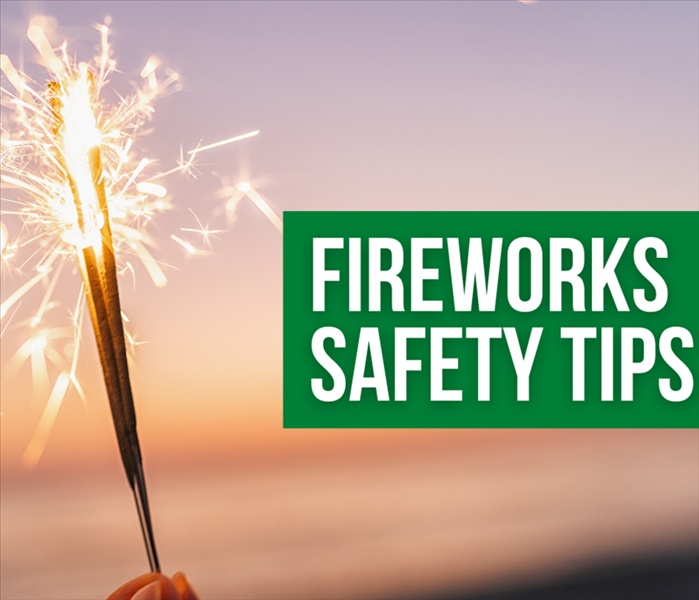 Remember, safety should always be the top priority when handling fireworks.
Remember, safety should always be the top priority when handling fireworks.
Fireworks are synonymous with celebrations, adding a touch of magic to any event.
However, the beauty of fireworks comes with inherent risks. To ensure that your festivities are both enjoyable and safe, it's crucial to follow proper fireworks safety guidelines. Here are some essential tips to keep in mind in Hopkinton MA:
- Buy from Reliable Sources: Purchase fireworks only from licensed and reputable sellers. Avoid homemade or illegal fireworks, as they can be extremely dangerous.
- Read the Instructions: Before igniting any fireworks, carefully read and understand the instructions. Pay attention to the recommended safety distances and methods of use.
- Designate a Shooter: Assign a responsible adult to handle the fireworks. This person should not consume alcohol or any impairing substances during the event.
- Keep a Safe Distance: Maintain a safe distance between the fireworks and the audience. Follow the recommended safety distances provided on the fireworks packaging.
- Protective Gear: Wear safety glasses and ear protection when handling fireworks. Cotton clothing is preferable to synthetic materials, which can melt if a spark lands on them.
- Lighting Instructions: Use a flashlight to read the labels and fuses in the dark. Light the fireworks at arm's length, and then quickly move away to a safe distance.
- Keep Water Handy: Have a bucket of water or a hose nearby to extinguish any fires or mishaps. Soak used fireworks in water before disposing of them.
- No Relighting: If a firework fails to ignite, do not attempt to relight it. Wait at least 20 minutes, then soak it in water before disposal.
- Pet Safety: Keep pets indoors during fireworks displays. The loud noises can frighten them, leading to unpredictable behavior.
- Follow Local Laws: Familiarize yourself with local laws and regulations regarding fireworks. Respect any bans or restrictions in your area.
- Stay Sober: Never handle fireworks if you have consumed alcohol or drugs. Your judgment and coordination may be impaired, increasing the risk of accidents.
- Dispose Properly: After the show, clean up the area. Dispose of fireworks debris in a metal container, as they can still be hot and pose a fire risk.
By following these safety guidelines, you can enjoy a dazzling fireworks display while ensuring the well-being of yourself and those around you. Remember, safety should always be the top priority when handling fireworks.
Choose the #1 Experts in Cleanup and Restoration for Residential and Commercial Fire, Mold, Water, and Storm Damage. Contact us today! We can assist with your damage and restoration needs in Hopkinton MA.
Keep Your Grill Sessions Safe and Fun This Season!
6/21/2024 (Permalink)
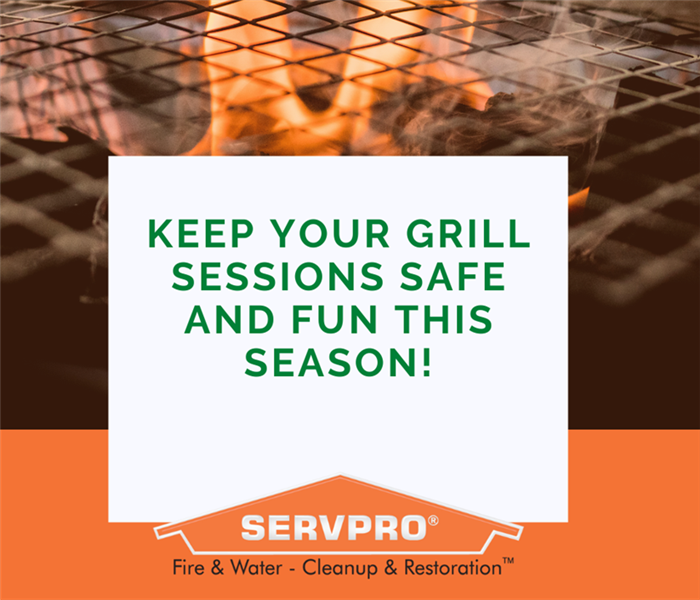 As the weather warms up, it's the perfect time to fire up the grill and enjoy some delicious outdoor cooking with family and friends.
As the weather warms up, it's the perfect time to fire up the grill and enjoy some delicious outdoor cooking with family and friends.
As the weather warms up, it's the perfect time to fire up the grill and enjoy some delicious outdoor cooking with family and friends. However, ensuring safety while grilling is crucial to prevent any fire hazards. Follow these simple tips to keep your grilling sessions safe and fun this season!
- Position Your Grill Safely
- Distance Matters: Place your grill at least 10 feet away from your house, deck railings, and overhanging branches.
- Stable Surface: Ensure your grill is on a stable, non-flammable surface to avoid tipping over.
- Maintain Your Grill
- Clean Regularly: Grease buildup can cause flare-ups. Clean your grill grates and drip trays before and after each use.
- Check for Leaks: Inspect gas grills for leaks by applying a light soap and water solution to the hose. If bubbles appear, there's a leak.
- Safe Lighting Practices
- Open Lid First: Always open the lid before lighting your gas grill to prevent gas buildup.
- Use Long Matches or Lighters: For charcoal grills, use long matches or lighters to ignite safely.
- Supervise and Protect
- Never Leave Unattended: Stay close by when grilling to monitor and manage any potential hazards.
- Keep Kids and Pets Away: Maintain a safe zone of at least 3 feet around the grill.
- Be Prepared for Emergencies
- Fire Extinguisher: Keep a fire extinguisher nearby and know how to use it.
- Baking Soda and Sand: Have baking soda for grease fires and sand or a bucket of water for charcoal fires.
Remember These Important No-No’s:
- No Flammable Liquids: Never use gasoline or other flammable liquids to start your grill.
- No Grilling Indoors: Grilling indoors or in an enclosed area can lead to carbon monoxide poisoning.
- Stay safe, have fun, and enjoy those summer cookouts!
Choose the #1 Experts in Cleanup and Restoration for Residential and Commercial Fire, Mold, Water, and Storm Damage. Contact us today! We can assist with your damage and restoration needs in Hopkinton MA.
Understanding Commercial Fires in Hopkinton, MA
4/24/2024 (Permalink)
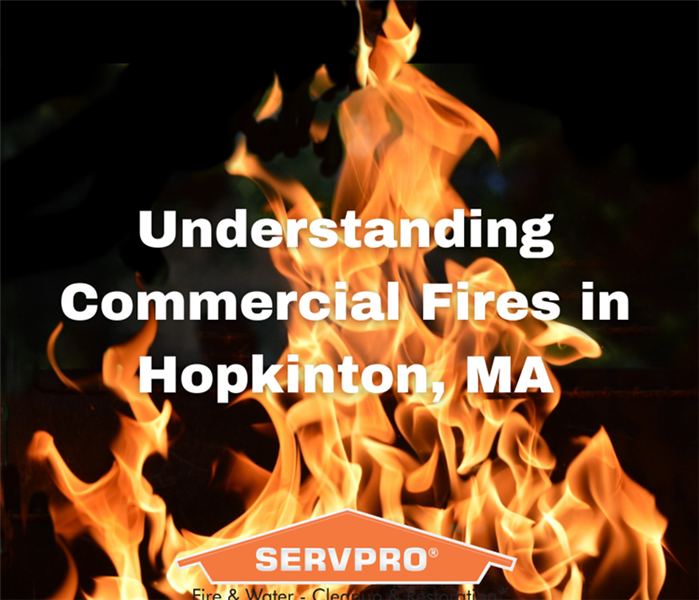 Understanding Commercial Fires in Hopkinton, MA
Understanding Commercial Fires in Hopkinton, MA
Commercial fires are devastating events that can have a profound impact on businesses, employees, and communities.
Understanding the causes of commercial fires, implementing prevention strategies, and knowing how to recover from a fire are crucial for business owners and managers. Here are the key aspects of commercial fires to help you protect your business and assets.
Causes of Commercial Fires
Commercial fires can be caused by various factors, including:
- Electrical Malfunctions: Faulty wiring, overloaded circuits, and malfunctioning electrical equipment can lead to electrical fires.
- Human Error: Accidents such as leaving cooking equipment unattended, improper use of flammable materials, and smoking near combustible materials can cause fires.
- Heating Systems: Malfunctioning heating systems, including furnaces and space heaters, can ignite fires if not properly maintained.
- Flammable Materials: Improper storage or handling of flammable liquids, gases, or materials can lead to fires.
- Arson: Intentional fires set by individuals for malicious purposes.
Prevention Strategies
To reduce the risk of commercial fires, consider implementing the following prevention strategies:
- Regular Maintenance: Ensure that electrical systems, heating systems, and other equipment are regularly inspected and maintained by qualified professionals.
- Fire Safety Training: Provide fire safety training to employees, including proper use of fire extinguishers and evacuation procedures.
- Proper Storage: Store flammable materials in designated areas away from ignition sources and ensure they are properly labeled and stored.
- Smoking Policies: Implement strict smoking policies and provide designated smoking areas away from combustible materials.
- Fire Detection and Suppression Systems: Install and maintain fire detection and suppression systems, such as smoke detectors, fire alarms, and sprinkler systems.
Recovery from a Commercial Fire
If your business has experienced a fire, the recovery process can be challenging. Here are some steps to help you recover:
- Assess the Damage: Conduct a thorough assessment of the damage to your property and inventory.
- Contact Your Insurance Provider: Notify your insurance provider immediately to start the claims process.
- Secure the Property: Secure the property to prevent further damage or unauthorized access.
- Cleanup and Restoration: Work with a professional fire restoration company to clean up the damage and restore your property.
- Rebuilding and Reopening: Develop a plan to rebuild and reopen your business, including securing financing if needed.
Commercial fires can have serious consequences, but with proper prevention strategies and knowledge of recovery processes, businesses can mitigate risks and protect their assets. By understanding the causes of commercial fires, implementing prevention measures, and knowing how to recover from a fire, businesses can better prepare themselves for these unfortunate events.
In the face of disaster, be it fire, mold, water, or storm damage, SERVPRO of Framingham stands as the premier choice for comprehensive cleanup and restoration services. Our team of highly skilled professionals responds with unparalleled swiftness, armed with unmatched expertise to restore your residential or commercial property to its preloss condition. With meticulous attention to detail and a commitment to quality and reliability, SERVPRO of Framingham is the trusted go-to solution, ensuring your home or business is brought back to its former glory, no matter the challenge.
Service Areas
Framingham, MA | Sudbury, MA | Hopkinton, MA | Ashland, MA | Holliston, MA | Nobscot, MA | Framingham Centre, MA | Saxonville, MA
Common Challenges Homeowners May Encounter After A Fire in Saxonville, MA
4/2/2024 (Permalink)
 Common Challenges Homeowners May Encounter After A Fire in Saxonville, MA
Common Challenges Homeowners May Encounter After A Fire in Saxonville, MA
Recovering from a residential fire can be a long and challenging process.
Beyond the physical damage, homeowners often face numerous challenges when rebuilding their homes and lives. Here are some of the common challenges homeowners may encounter after a fire.
- Dealing with Insurance Companies: One of the first challenges homeowners face is dealing with insurance companies. Understanding your policy, documenting the damage, and negotiating with the insurance adjuster can be overwhelming. It's essential to keep detailed records and seek assistance from a public adjuster if needed.
- Finding Reputable Contractors: Finding reputable contractors to repair the damage can be challenging, especially in areas with high demand. It's crucial to research contractors thoroughly, check references, and get multiple quotes. Working with a contractor who specializes in fire damage restoration can streamline the process.
- Coping with the Emotional Toll: The emotional toll of losing your home and belongings in a fire can be immense. It's normal to feel grief, anger, and frustration. Seeking support from friends, family, or a counselor can help you cope with these emotions and navigate the rebuilding process.
- Navigating Building Codes and Permits: Rebuilding after a fire often requires navigating complex building codes and obtaining permits. It's essential to work with a contractor who is familiar with local regulations and can ensure that your home is rebuilt to code.
- Managing Financial Strain: Rebuilding after a fire can be financially challenging, especially if you're not fully covered by insurance. Consider exploring government assistance programs, crowdfunding, or loans to help cover the costs of rebuilding.
Despite the challenges, rebuilding after a fire is possible with patience, perseverance, and support. By seeking assistance from professionals, staying organized, and taking care of your emotional well-being, you can successfully rebuild your home and move forward after a fire.
When disaster strikes your home or business, trust SERVPRO of Framingham as the premier choice for comprehensive cleanup and restoration services. With unparalleled expertise, our professionals swiftly respond to any fire, mold, water, or storm-related damage, ensuring your property is restored to its preloss condition with meticulous attention to detail. Whether it's a residential or commercial property, SERVPRO of Framingham delivers unmatched quality and reliability, making us the go-to solution for all your cleanup and restoration needs.
Service Areas
Framingham, MA | Sudbury, MA | Hopkinton, MA | Ashland, MA | Holliston, MA | Nobscot, MA | Framingham Centre, MA | Saxonville, MA
Flames Extinguished, Hopes Rekindled: Top-notch Fire Restoration Services in Framingham
2/5/2024 (Permalink)
 When faced with the aftermath of a fire, trust in the capabilities of fire restoration professionals to guide the way .
When faced with the aftermath of a fire, trust in the capabilities of fire restoration professionals to guide the way .
A fire can be a devastating event, leaving behind destruction and despair.
When flames are finally extinguished, the process of rebuilding begins. In the aftermath of a fire, the importance of top-notch fire restoration services cannot be overstated. Explore the vital role that professional fire restoration experts play in helping individuals and businesses recover from the ashes and rekindle their hopes.
- Immediate Response for Damage Control: The aftermath of a fire requires immediate attention to prevent further damage. Professional fire restoration services understand the urgency and respond promptly. Their swift actions not only mitigate existing damage but also prevent secondary issues such as water damage from firefighting efforts.
- Thorough Assessment of Fire Damage: Fire damage is multifaceted, affecting structures, belongings, and the overall safety of the property. Expert fire restoration teams conduct a thorough assessment to identify the extent of the damage. This evaluation guides the development of a comprehensive restoration plan tailored to the unique needs of each case.
- Smoke and Soot Removal: Beyond visible fire damage, smoke and soot residues can permeate every corner of a property. Professional restoration services utilize specialized equipment and techniques to remove smoke and soot, ensuring a clean and safe environment for restoration efforts.
- Structural Repairs and Reconstruction: Fires can compromise the structural integrity of buildings. Skilled restoration experts are equipped to handle structural repairs and reconstruction, ensuring that the property is not only restored aesthetically but also meets safety standards.
- Content Restoration and Cleaning: Belongings affected by fire and smoke require careful restoration. Fire restoration professionals employ advanced cleaning and restoration techniques for salvaging personal items, furniture, and valuables. This can significantly reduce the emotional toll on individuals who have lost cherished possessions.
- Odor Elimination: Lingering odors from smoke and fire can persist long after the flames are extinguished. Fire restoration services utilize specialized deodorization methods to eliminate odors effectively, providing a fresh and clean living or working space.
- Insurance Coordination and Documentation: Navigating insurance claims after a fire can be complex. Fire restoration experts often assist in coordinating with insurance providers, documenting the damage, and providing accurate assessments. This streamlined process helps expedite the insurance claims process for a faster recovery.
- Emotional Support and Guidance: Recovering from a fire is not just about physical restoration; it's also about emotional recovery. Professional fire restoration teams offer support and guidance, helping individuals and families navigate the challenges of rebuilding and rekindling hopes for the future.
In the face of fire, the path to recovery may seem daunting, but with top-notch fire restoration services, flames can be extinguished, and hopes can be rekindled. The expertise, efficiency, and compassion of professional fire restoration experts play a pivotal role in helping individuals and businesses rise from the ashes and rebuild their lives. When faced with the aftermath of a fire, trust in the capabilities of fire restoration professionals to guide the way to a brighter and restored future in Framingham.
SERVPRO Of Framingham is The #1 Choice in Cleanup and Restoration for residential and commercial buildings’ fire, mold, water, and storm damage.
Smoke Signals: Professional Restoration for a Smoke-Free Environment in Framingham
2/5/2024 (Permalink)
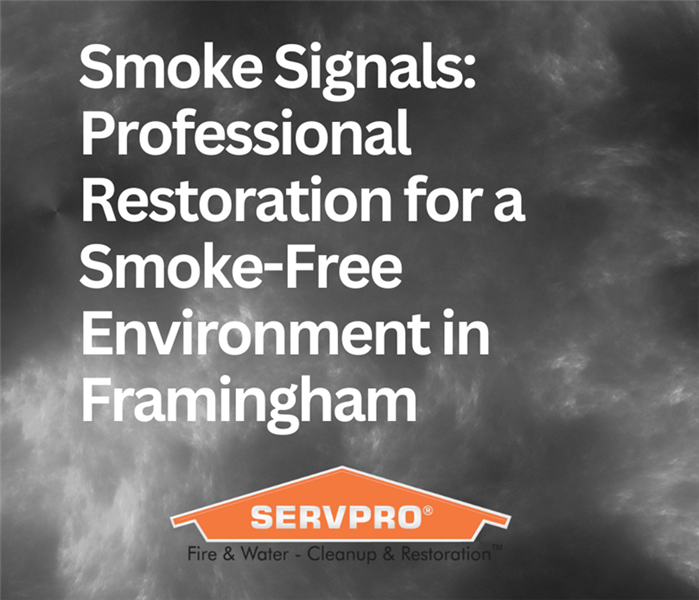 When smoke signals trouble, trust in the expertise of smoke restoration professionals to restore the clarity and purity of your indoor spaces.
When smoke signals trouble, trust in the expertise of smoke restoration professionals to restore the clarity and purity of your indoor spaces.
Smoke damage can permeate every corner of a property, leaving behind not only visible stains but also lingering odors. Whether it's from a fire, tobacco smoke, or other sources, the impact of smoke on indoor environments can be significant. Learn the importance of professional smoke restoration services in creating a smoke-free environment and restoring the quality of indoor spaces in Framingham.
- Understanding the Complex Nature of Smoke Damage: Smoke damage is more than just surface stains; it involves complex interactions between various particles and surfaces. Professional smoke restoration services have a deep understanding of the science behind smoke damage, allowing them to address not only visible signs but also hidden issues such as odor penetration and residue accumulation.
- Thorough Assessment of Smoke Damage: Before initiating restoration efforts, experts conduct a thorough assessment of the extent of smoke damage. This includes identifying affected surfaces, materials, and the specific type of smoke residue present. This comprehensive evaluation serves as the foundation for a targeted and effective restoration plan.
- Specialized Cleaning Techniques: Smoke restoration professionals employ specialized cleaning techniques to remove smoke residues from surfaces. This may involve dry cleaning, wet cleaning, or abrasive cleaning methods tailored to the type of materials affected. The goal is to restore surfaces to their pre-damage condition without causing further harm.
- Odor Elimination Strategies: Lingering smoke odors can persist long after visible damage is addressed. Professional restoration services utilize advanced odor elimination strategies, including ozone treatments, thermal fogging, and specialized deodorizers. These methods neutralize and eliminate odors at the molecular level, ensuring a truly smoke-free environment.
- HVAC System Cleaning: Smoke particles can infiltrate HVAC systems, spreading odors and contaminants throughout a property. Smoke restoration experts extend their services to include thorough cleaning of ventilation systems, ductwork, and HVAC components. This ensures that the entire indoor environment is free from smoke-related residues.
- Preventing Cross-Contamination: During the restoration process, professionals take measures to prevent cross-contamination to unaffected areas. This involves isolating damaged areas, using containment barriers, and employing air filtration systems to capture and remove airborne smoke particles. These precautions are crucial for preventing the spread of residues to other parts of the property.
- Restoring Indoor Air Quality: A key aspect of creating a smoke-free environment is restoring indoor air quality. Professional restoration services focus not only on visible damage but also on improving air quality by removing airborne contaminants and ensuring proper ventilation.
- Post-Restoration Inspection and Testing: To guarantee the effectiveness of restoration efforts, professionals conduct post-restoration inspections and testing. This involves evaluating surfaces, conducting air quality tests, and ensuring that all smoke-related issues have been successfully addressed. The final step is to provide clients with the assurance of a thoroughly restored and smoke-free environment.
For individuals and businesses grappling with the aftermath of smoke damage, professional smoke restoration services offer a beacon of hope. By addressing the complex nature of smoke damage, employing specialized cleaning techniques, and implementing comprehensive odor-elimination strategies, these experts play a crucial role in creating a truly smoke-free indoor environment. When smoke signals trouble, trust in the expertise of smoke restoration professionals to restore the clarity and purity of your indoor spaces in Framingham.
SERVPRO Of Framingham is The #1 Choice in Cleanup and Restoration for residential and commercial buildings’ fire, mold, water, and storm damage.
Understanding the Different Types of Fire and Smoke Damage In Framingham MA.
1/22/2024 (Permalink)
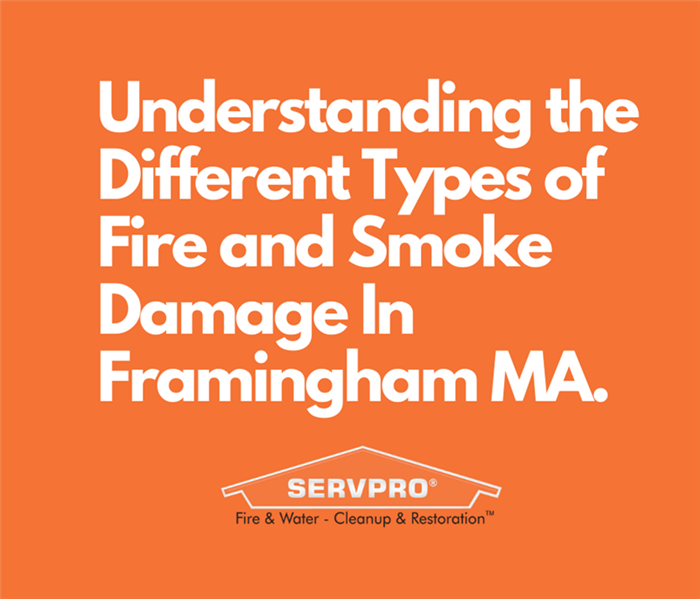 Restoration professionals play a crucial role in assessing and mitigating damages In Framingham MA.
Restoration professionals play a crucial role in assessing and mitigating damages In Framingham MA.
Facing a fire is a devastating experience, and the aftermath involves not only the visible destruction caused by flames but also the pervasive impact of smoke.
Fire and smoke damage can vary widely, and understanding the different types is crucial for effective restoration and recovery. Here we will explore the various types of fire and smoke damage and the challenges associated with each.
Structural Damage:
- Description: Structural damage is the most apparent consequence of a fire, affecting walls, floors, ceilings, and other building components.
- Causes: Direct exposure to flames, high temperatures, and the structural integrity of materials being compromised during a fire.
- Challenges: Assessing and repairing structural damage often requires collaboration between structural engineers, contractors, and restoration specialists.
Soot Damage:
- Description: Soot is a fine, black residue composed of carbon particles produced by incomplete combustion. It can cover surfaces and belongings, leaving behind a distinct odor and staining.
- Causes: Incomplete combustion of organic materials during a fire, releasing fine particles that settle on surfaces.
- Challenges: Cleaning soot requires specialized techniques and equipment to prevent smearing and further damage.
Smoke Damage:
- Description: Smoke damage encompasses the impact of smoke on surfaces, belongings, and indoor air quality. It often manifests as discoloration, odors, and corrosive residues.
- Causes: The complex mixture of gases, chemicals, and particles released during a fire that adhere to surfaces and materials.
- Challenges: Proper ventilation, air purification, and targeted cleaning are essential to address smoke damage comprehensively.
Water Damage:
- Description: Water damage is a secondary consequence of firefighting efforts, as water is used to extinguish flames. It can lead to issues such as mold growth and structural deterioration.
- Causes: Firefighters' efforts to extinguish the fire using water or other suppressants.
- Challenges: Swift water extraction, drying, and dehumidification are critical to prevent further damage and mitigate the risk of mold growth.
Corrosion Damage:
- Description: Corrosion occurs when acidic byproducts of combustion react with metals, leading to deterioration and discoloration.
- Causes: Interaction between acidic residues in smoke and metal surfaces.
- Challenges: Prompt cleaning and treatment of metal surfaces to prevent irreversible corrosion damage.
Odor Damage:
- Description: Lingering odors are a common issue after a fire, caused by the combustion of various materials.
- Causes: Absorption of smoke particles into porous surfaces, making odors difficult to eliminate.
- Challenges: Odor removal requires specialized techniques, such as ozone treatment or thermal fogging, to neutralize and eliminate persistent smells.
Dealing with the aftermath of a fire involves addressing various types of damage, each requiring specific expertise and techniques. Restoration professionals play a crucial role in assessing and mitigating these damages, helping individuals and businesses rebuild and recover from the devastating effects of fire and smoke. Understanding the nuances of different types of fire and smoke damage is a key step in the restoration process, ensuring a comprehensive and effective approach to recovery In Framingham MA.
Electrical Fire Safety: Protecting Your Home and Business In Framingham MA.
1/9/2024 (Permalink)
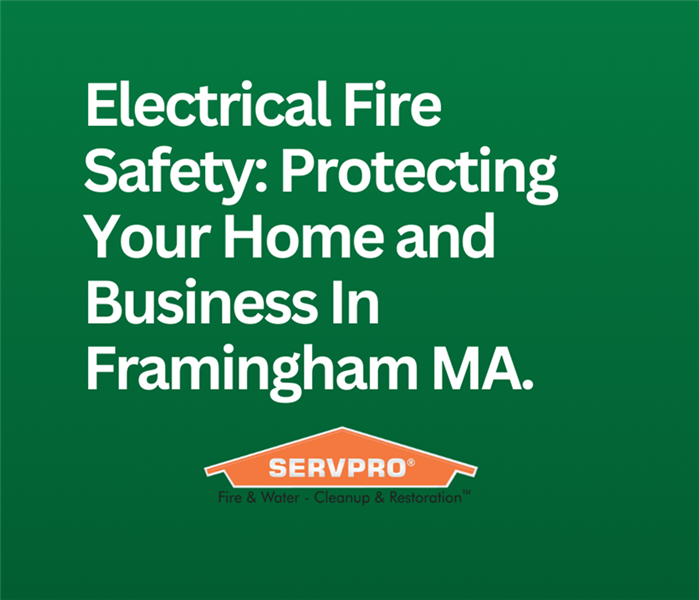 Stay informed, stay safe, and empower others with the knowledge needed to prevent electrical fires In Framingham MA.
Stay informed, stay safe, and empower others with the knowledge needed to prevent electrical fires In Framingham MA.
Electricity is an integral part of our daily lives, powering our homes and businesses. However, it comes with inherent risks, and electrical fires pose a serious threat to both life and property.
Understanding electrical fire safety is crucial for minimizing these risks and ensuring the well-being of occupants. Let’s explore key measures to enhance electrical fire safety at home and in the workplace.
Common Causes of Electrical Fires:
- Faulty Wiring: Aging or improperly installed wiring can lead to electrical fires. Regular inspections and maintenance are essential to identify and rectify potential issues.
- Overloaded Circuits: Plugging too many devices into a single outlet or overloading circuits can generate excessive heat, leading to sparks and fires. Distribute electrical loads evenly and avoid daisy-chaining multiple power strips.
- Malfunctioning Appliances: Appliances with damaged cords or internal components can become fire hazards. Regularly inspect and replace damaged cords, and follow manufacturer guidelines for maintenance.
- Electrical Equipment Issues: Faulty electrical equipment, such as circuit breakers or outlets, can contribute to electrical fires. Ensure that all electrical components are in good working condition and promptly address any malfunctions.
- Flammable Materials Near Outlets: Placing flammable materials, such as curtains or paper, near electrical outlets or equipment increases the risk of fire. Keep these areas clear to minimize potential hazards.
Electrical Fire Safety Tips for Homes and Businesses:
- Regular Inspections and Maintenance: Schedule regular inspections of your electrical system, especially in older homes or buildings. Look for signs of wear and tear, exposed wires, or scorch marks. Hire a qualified electrician to address any issues promptly.
- Avoid Overloading Circuits: Be mindful of the number of devices plugged into outlets, and avoid overloading circuits. Use power strips with built-in surge protection to safeguard against voltage spikes.
- Proper Use of Extension Cords: Extension cords should only be used temporarily. Avoid using them as permanent solutions, and never daisy-chain multiple extension cords together.
- Upgrade Wiring and Electrical Panels: If your home or business has outdated wiring or electrical panels, consider upgrading to meet current safety standards. This can significantly reduce the risk of electrical fires.
- Appliance Safety: Regularly check appliances for signs of damage and replace frayed or worn-out cords. Follow manufacturer guidelines for maintenance, and avoid leaving appliances unattended when in use.
- Install Smoke Alarms: Ensure that smoke alarms are installed in key areas of your home or business. Regularly test and replace batteries to guarantee their functionality.
- Emergency Response Plan: Develop and communicate an emergency response plan that includes procedures for dealing with electrical fires. Ensure that all occupants are aware of evacuation routes and the location of fire extinguishers.
Electrical fire safety is a shared responsibility that requires diligence and proactive measures. By staying vigilant, conducting regular inspections, and implementing safety measures, you can significantly reduce the risk of electrical fires at home and in the workplace. Remember, prioritizing electrical safety not only protects property but, more importantly, ensures the safety and well-being of the people in your care. Stay informed, stay safe, and empower others with the knowledge needed to prevent electrical fires In Framingham MA.
What to Do in the Event of a Fire in Framingham, MA
12/2/2023 (Permalink)
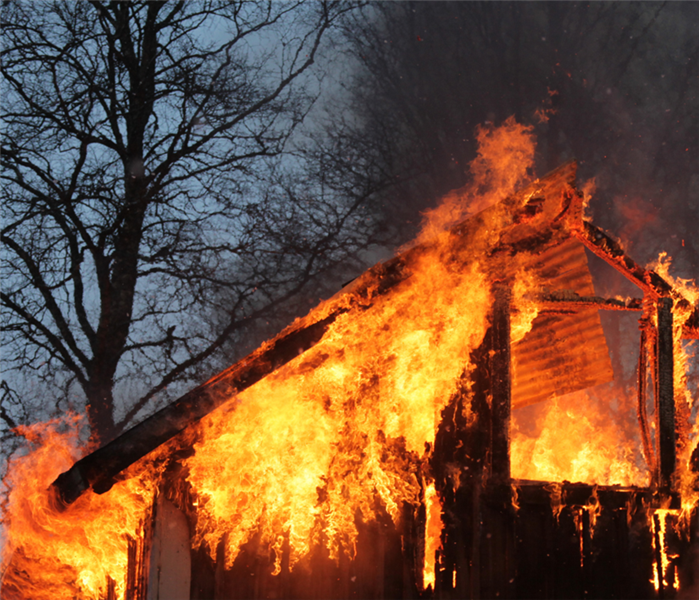 Being prepared for a fire emergency involves a combination of education, awareness, and practice.
Being prepared for a fire emergency involves a combination of education, awareness, and practice.
Fires are unpredictable and can escalate rapidly, posing a serious threat to life and property. Whether at home, work, or in public spaces, being prepared and knowing what to do in the event of a fire can make all the difference. Read for practical guidance on how to respond calmly and effectively when faced with a fire emergency in Framingham, MA
Stay Calm and Alert:
The first and most crucial step in any emergency situation is to stay calm. Panic can hinder clear thinking and swift decision-making. If you discover a fire or hear a fire alarm, remain calm, and alert those around you. Time is of the essence in fire emergencies, and a composed mindset can help you take the necessary actions quickly.
Evacuate Immediately:
Your safety and the safety of others should be the top priority. If the fire is small and manageable, use an appropriate fire extinguisher to try and control it. However, if the fire is spreading or you feel unsafe, leave the area immediately. Do not waste time gathering belongings; evacuate as quickly as possible.
Follow Exit Routes:
In public places or buildings, familiarize yourself with exit routes and emergency exits. During a fire, follow these routes calmly and assist others who may need help, especially those with mobility issues or disabilities. Avoid using elevators during a fire; use stairwells instead.
Crawl Low in Smoke:
Smoke inhalation is a major risk during a fire. If smoke is present, stay close to the ground where the air is clearer. Smoke rises, and by crawling low, you can reduce the risk of inhaling harmful gases and increase your chances of reaching safety.
Call for Help:
Once you are safely outside the building, call emergency services immediately. Provide them with accurate information about the location and nature of the fire. Avoid re-entering the building unless instructed by emergency personnel.
Assemble at a Designated Meeting Point:
In residential complexes or workplaces, establish a designated meeting point a safe distance from the building. This ensures that everyone can be quickly accounted for and that emergency responders have accurate information about who may still be inside.
Do Not Re-enter the Building:
Under no circumstances should you re-enter a building that is on fire. Let trained firefighters handle the situation. Re-entering a burning building is extremely dangerous and can lead to severe injuries or loss of life.
Follow Fire Prevention Measures:
Preventing fires is just as crucial as knowing how to respond to them. Regularly check smoke detectors, electrical systems, and heating appliances. Avoid overloading electrical outlets and practice safe cooking habits. Being proactive in fire prevention can significantly reduce the risk of a fire breaking out.
Being prepared for a fire emergency involves a combination of education, awareness, and practice. By staying calm, evacuating quickly, and following established safety procedures, you can protect yourself and others from the dangers of a fire. Regularly reviewing and practicing these steps ensures that you are ready to respond effectively in the event of a fire, making a significant contribution to overall community safety.
SERVPRO of Framingham is The #1 Choice in Cleanup and Restoration for residential and commercial buildings’ fire damage.
A Guide to Thanksgiving Fire Safety in Framingham MA
11/1/2023 (Permalink)
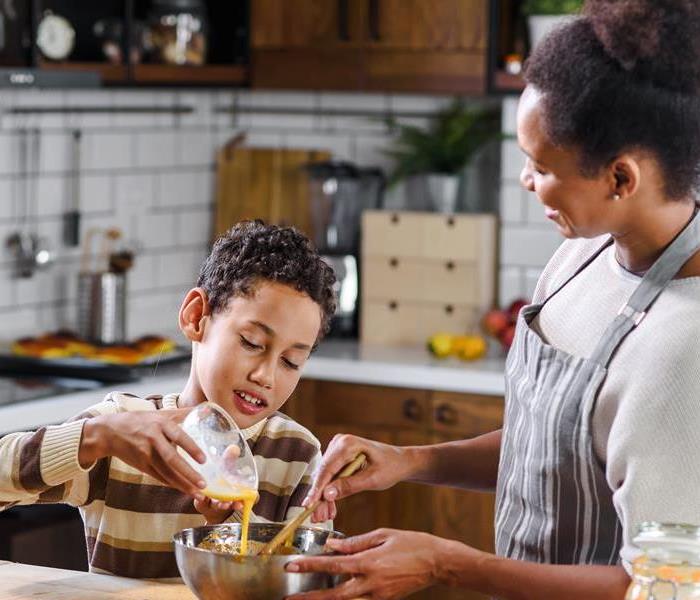 Prioritizing safety is paramount, particularly concerning potential fire hazards.
Prioritizing safety is paramount, particularly concerning potential fire hazards.
The aroma of roasted turkey, the warmth of pumpkin pie, and the gathering of loved ones create a festive atmosphere. However, amidst the celebration, it's crucial to prioritize safety, especially when it comes to potential fire hazards.
Read to find out Thanksgiving fire safety tips to ensure your holiday remains a time of gratitude and joy.
Kitchen Safety: The heart of Thanksgiving is undoubtedly the kitchen, where the magic of the feast unfolds.
- Never leave the stove unattended, especially when cooking with oils or frying.
- Keep flammable items, such as kitchen towels and oven mitts, away from the stovetop.
- Ensure that your smoke alarms are working correctly, and have a fire extinguisher within easy reach.
Turkey Fryer Safety: Deep-frying turkeys has become a popular Thanksgiving tradition, but it comes with inherent risks.
- Set up the fryer outdoors, away from the house, deck, or any flammable materials.
- Thaw the turkey completely before frying to avoid oil splatters.
- Monitor the temperature of the oil closely and never overfill the fryer.
Candle Caution: Candles can add a warm and cozy ambiance to your Thanksgiving dinner, but they also pose a fire risk.
- Keep candles away from flammable decorations and other items.
- Place candles in sturdy, non-tip candle holders.
- Never leave lit candles unattended, and extinguish them before leaving the room.
Electrical Safety: Thanksgiving often involves a multitude of electrical appliances and devices.
- Avoid overloading electrical outlets and use surge protectors when necessary.
- Inspect cords for any frays or damage and replace them if needed.
- Turn off appliances when not in use, and unplug them if possible.
Keep an Eye on Children: Children, while adding to the joy of the season, can be curious and unaware of potential dangers.
- Designating a kid-free zone in the kitchen.
- Educating children about fire safety and the importance of staying away from hot surfaces.
- Assigning a responsible adult to supervise young children during festivities.
Prioritizing safety is paramount, particularly concerning potential fire hazards. SERVPRO Of Framingham is The #1 Choice in Cleanup and Restoration for residential and commercial buildings’ fire damage. We are open 24-7, including all major holidays. Call us today (774) 540-6950
A Guide to Christmas Fire Safety in Framingham MA
11/1/2023 (Permalink)
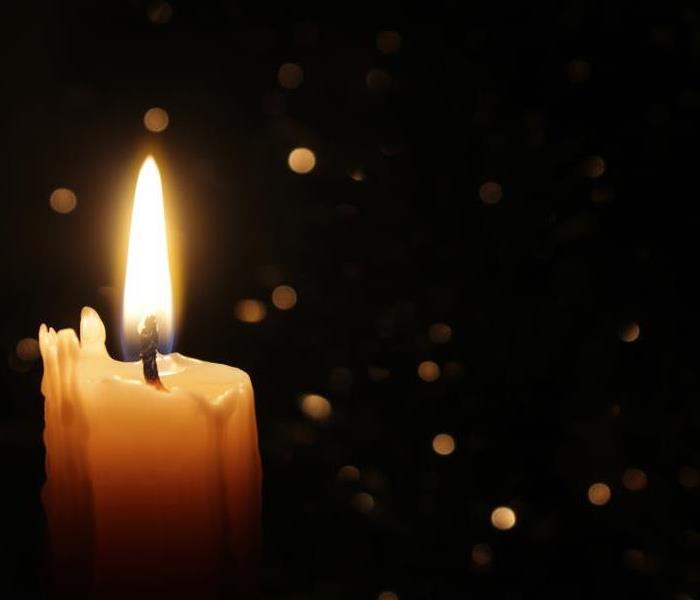 By taking simple precautions and being mindful of fire safety, you can ensure that the holiday season remains merry and bright for everyone.
By taking simple precautions and being mindful of fire safety, you can ensure that the holiday season remains merry and bright for everyone.
As the holiday season approaches, families gather, homes are adorned with twinkling lights and decorations, and the aroma of delicious meals fills the air. However, amidst the festivities, it's crucial to prioritize safety, especially when it comes to fire safety during the holidays.
Here are some essential tips to ensure a Merry and safe Christmas for you and your loved ones.
Mindful Decoration Placement:
Decking the halls with festive decorations is a cherished Christmas tradition. However, it's essential to be mindful of where and how you place them. Keep flammable materials such as curtains, tablecloths, and other decorations away from heat sources like candles and fireplaces. Opt for flame-resistant or flame-retardant decorations whenever possible.
Candle Safety:
Candles create a warm and cozy atmosphere, but they also pose a significant fire hazard. If you enjoy the glow of candlelight, consider using flameless LED candles as a safer alternative. If you do use traditional candles, never leave them unattended, keep them away from children and pets, and ensure they are placed in stable holders on a flat surface.
Inspect Christmas Lights:
Before hanging up your Christmas lights, inspect them for any signs of damage such as frayed wires, broken bulbs, or exposed wires. Discard and replace any damaged lights, and always follow the manufacturer's guidelines for usage. Consider using LED lights, as they generate less heat and are more energy-efficient than traditional incandescent lights.
Mindful Tree Care:
If you have a live Christmas tree, keeping it well-hydrated is crucial for fire prevention. Dry trees are highly flammable, so be sure to water your tree regularly and keep it away from heat sources. If you opt for an artificial tree, ensure that it is labeled as flame-resistant.
Cooking Safety:
The Christmas feast is a central part of the celebration, but it's also a time when kitchen fires are more common. Stay vigilant while cooking, use timers to avoid overcooking, and keep flammable items like kitchen towels and oven mitts away from the stove. If deep-frying, do so outside and away from structures.
Have an Escape Plan:
In the unfortunate event that a fire does occur, it's crucial to have a well-thought-out escape plan. Ensure that everyone in the household knows the plan, including designated meeting points outside the home. Practice fire drills regularly, especially if you have guests staying with you over the holidays.
Christmas is a time for joy, warmth, and togetherness. By taking simple precautions and being mindful of fire safety, you can ensure that the holiday season remains merry and bright for everyone. SERVPRO Of Framingham is The #1 Choice in Cleanup and Restoration for residential and commercial buildings’ fire damage. We are open 24-7, including all major holidays. Call us today (774) 540-6950
Protecting Your Home and Loved Ones: A Comprehensive Guide to Fire Prevention
10/4/2023 (Permalink)
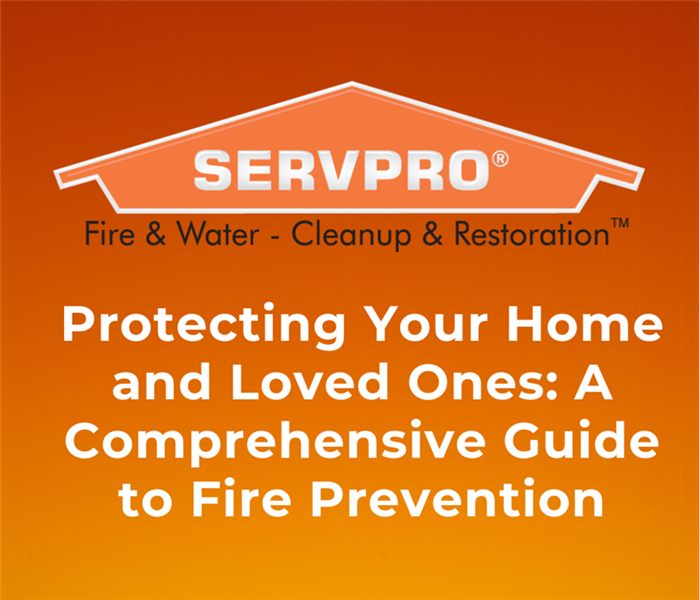 Preventing fires is a shared responsibility that requires diligence and awareness.
Preventing fires is a shared responsibility that requires diligence and awareness.
Fire is a powerful and destructive force that can devastate lives and property within seconds. Fortunately, many fires can be prevented with proper awareness, precautions, and responsible behavior. Here are essential tips and strategies for fire prevention, so you can safeguard your home and loved ones.
- Install Smoke Alarms: One of the most critical components of fire prevention is having functional smoke alarms in your home. These devices are your first line of defense against fires. Ensure you have smoke alarms installed in key areas like bedrooms, hallways, and the kitchen. Regularly test them to make sure they are working correctly and replace their batteries at least once a year.
- Create a Fire Escape Plan: Having a well-thought-out fire escape plan is essential for the safety of your family. Make sure everyone in your household knows the plan, including multiple escape routes, a designated meeting point outside, and how to call 911. Practice fire drills regularly to ensure everyone is familiar with the process.
- Fire-Resistant Building Materials: If you're building a new home or renovating, consider using fire-resistant materials like fire-resistant roofing, siding, and insulation. These materials can slow the spread of flames and increase the chances of containing a fire until help arrives.
- Properly Store Flammable Materials: Store flammable materials, such as gasoline, propane, and paints, in a well-ventilated area away from heat sources and open flames. Use appropriate containers and follow safety guidelines to prevent leaks or spills.
- Maintain Heating Equipment: Heating equipment, including fireplaces, wood stoves, and furnaces, should be regularly inspected and maintained by professionals. Keep flammable materials at a safe distance and use protective barriers like screens to prevent sparks from escaping.
- Safe Cooking Practices: Cooking is one of the leading causes of home fires. Never leave the kitchen unattended while cooking, and keep flammable objects like dish towels and curtains away from the stove. Install a fire extinguisher in or near the kitchen and know how to use it.
- Electrical Safety: Faulty electrical systems or appliances can trigger fires. Inspect electrical cords and outlets for damage and replace them if necessary. Avoid overloading electrical outlets and use surge protectors when needed.
- Candle Safety: Candles can create a cozy atmosphere, but they are also a fire hazard. Keep candles away from flammable materials and never leave them unattended. Consider using flameless LED candles as a safer alternative.
- Smoking Safety: If you smoke, do so outside and use a sturdy, deep ashtray. Ensure cigarettes are completely extinguished before disposing of them. Never smoke in bed, as falling asleep with a lit cigarette can lead to a deadly fire.
- Teach Fire Safety to Children: Children should be educated about fire safety from a young age. Teach them about the dangers of fire, how to respond in case of a fire, and the importance of not playing with matches or lighters.
Preventing fires is a shared responsibility that requires diligence and awareness. By following these fire prevention tips and fostering a culture of safety in your household, you can significantly reduce the risk of fires and protect your home and loved ones from this destructive force in Framingham. Remember, when it comes to fire prevention, an ounce of prevention is worth a pound of cure. Stay safe, and prepared, and prevent fires to your home in Hopkinton, MA.
SERVPRO® Of Framingham is The #1 Choice in Cleanup and Restoration for residential and commercial buildings’ fire, mold, water, and storm damage. Call us today (774) 540-6950
5 Things Not to Do After a Fire Damages Your Home in Framingham, MA.
8/23/2023 (Permalink)
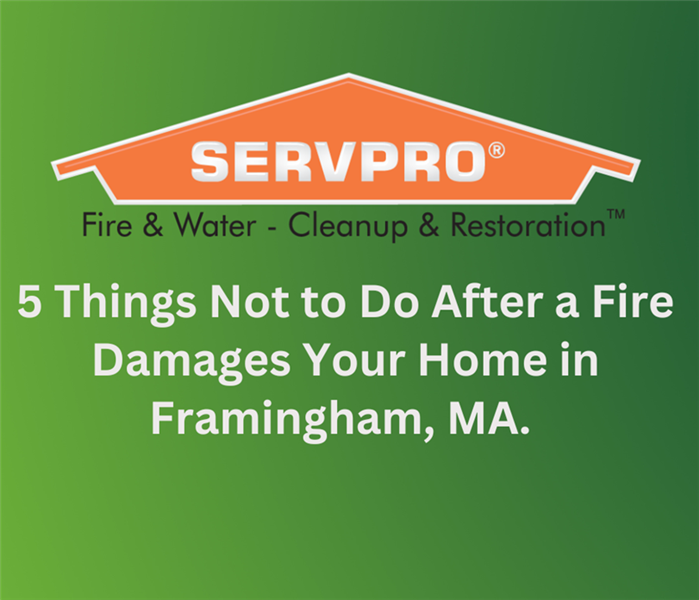 By following these five essential guidelines, you can navigate the post-fire period more smoothly, ensuring a faster and more effective recovery
By following these five essential guidelines, you can navigate the post-fire period more smoothly, ensuring a faster and more effective recovery
Experiencing a house fire is a devastating event that can leave you feeling overwhelmed and uncertain about what steps to take next. After the fire is extinguished and the immediate danger is over, it's essential to approach the situation with caution and a clear plan. While the desire to start restoring your home may be strong, there are several critical mistakes you should avoid to ensure a smoother recovery process. Here are five things not to do after a fire damages your home, helping you navigate this challenging time with greater ease and efficiency.
- Entering the Property Without Proper Clearance: After a fire, your instinct may be to rush back into your home to assess the damage and retrieve valuables. However, entering the property without proper clearance from the fire department or relevant authorities can be extremely dangerous. Structural instability, hidden pockets of fire, toxic fumes, and weakened support beams are just a few of the hazards that might be present. Always wait for the official go-ahead before reentering your home to ensure your safety and that of emergency responders.
- Attempting DIY Repairs: Restoring your home after a fire requires professional expertise due to the complexity of the damage. While it's natural to want to start cleaning up immediately, attempting DIY repairs without the necessary knowledge and equipment can lead to further damage and compromise the integrity of your home. Instead, consult with licensed contractors or restoration specialists experienced in fire damage recovery. They will have the expertise and tools needed to assess the situation correctly and carry out safe and effective restoration work.
- Ignoring Smoke and Soot Damage: The aftermath of a fire often leaves behind extensive smoke and soot damage that may not be immediately apparent. Ignoring these lingering issues can lead to long-term problems, including health hazards and deterioration of materials. Smoke and soot particles can seep into walls, upholstery, and ventilation systems, causing respiratory issues and unpleasant odors. Engage professional cleaning services equipped to handle fire-related residues to ensure that your home is thoroughly cleaned and deodorized.
- Failing to Notify Your Insurance Company Promptly: Your homeowner's insurance policy is there to help you during such challenging times, but to maximize your claim and coverage, it's crucial to notify your insurance company promptly. Delaying the reporting of the fire or providing incomplete information may lead to complications and delays in receiving the necessary funds for the restoration process. Reach out to your insurance provider as soon as possible, providing detailed documentation of the damage and any valuable items that were lost.
- Disposing of Damaged Items Prematurely: Amidst the chaos of a fire-damaged home, it's tempting to discard ruined items quickly. However, it's essential to document the damage thoroughly before disposing of anything. Take photographs and make a detailed inventory of damaged belongings as evidence for your insurance claim. Your insurance adjuster may need this information to process your claim accurately. Moreover, some items may be salvageable through professional restoration services, potentially saving you money in replacement costs.
Experiencing a fire and the aftermath of its damage is an emotional and challenging ordeal. While the desire to start rebuilding your life is natural, it's essential to approach the recovery process cautiously and avoid certain mistakes. Remember not to enter your property until it's deemed safe, enlist the help of professionals for restoration work, promptly inform your insurance company, and document the damage thoroughly. By following these five essential guidelines, you can navigate the post-fire period more smoothly, ensuring a faster and more effective recovery for your home and your life.
SERVPRO of Framingham stands as the ultimate choice for both residential and commercial buildings when it comes to cleanup and restoration services. Our unparalleled expertise covers a wide range of damages, including fire, mold, water, and storm-related incidents. Count on us for top-notch solutions to restore your property efficiently and effectively.
How to Deal with Fire and Smoke Damage in a Home or Business in Framingham
6/7/2023 (Permalink)
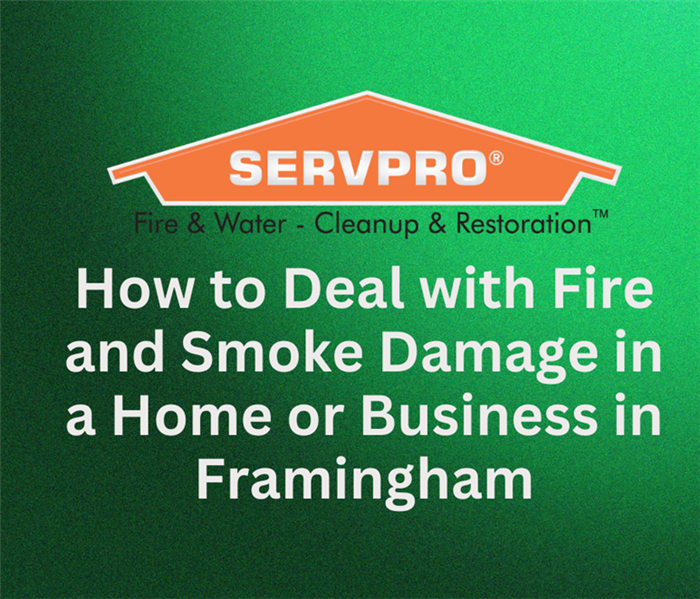 SERVPRO Of Framingham is The #1 Choice in Cleanup and Restoration for residential and commercial building damage.
SERVPRO Of Framingham is The #1 Choice in Cleanup and Restoration for residential and commercial building damage.
Experiencing a fire incident in your home or business can be a traumatic event. Aside from the immediate danger and destruction caused by flames, the aftermath of fire and smoke damage can present significant challenges. However, with the right knowledge and proactive approach, you can effectively deal with fire and smoke damage and restore your property to its preloss condition. Here are steps to help you navigate the recovery process successfully.
- Ensure Safety: Before entering the fire-damaged premises, it is crucial to wait for approval from the fire department or relevant authorities that the building is structurally safe. Always prioritize your safety and the safety of others. Wear appropriate protective gear, including masks, gloves, and eye protection, as smoke residues can contain harmful particles.
- Contact Professionals: Once the property is deemed safe to enter, contact a reputable fire damage restoration company as soon as possible, such as SERVPRO Of Framingham . These professionals have the expertise, experience, and specialized equipment to handle fire and smoke damage effectively. They will assess the extent of the damage, provide guidance, and develop a comprehensive restoration plan tailored to your specific situation.
- Document the Damage: Before any cleanup or repairs take place, document the damage thoroughly. Take photographs and make a detailed inventory of all affected items and structural damage. This documentation will be crucial for insurance claims and can help ensure that nothing is overlooked during the restoration process.
- Ventilate the Area: Open windows and doors to allow fresh air to circulate throughout the space. This helps to dissipate residual smoke and reduce odors. However, exercise caution if there is significant structural damage, as opening windows or doors could pose safety risks.
- Clean and Remove Soot: Soot and smoke residues can cause significant damage if left untreated. Begin by vacuuming loose soot particles using a high-efficiency particulate air (HEPA) vacuum cleaner. Avoid using regular household vacuums, as they may blow soot particles back into the air. Consider SERVPRO Of Framingham for thorough cleaning and restoration of delicate items such as textiles, electronics, and artwork.
- Assess and Repair Structural Damage: Evaluate the structural integrity of your property and address any immediate concerns. Seek assistance from a licensed contractor or structural engineer to determine the extent of the damage and develop a plan for repairs or rebuilding.
- Eliminate Odors: Smoke odor can be persistent and challenging to remove. Begin by airing out the space and using fans or dehumidifiers to promote air circulation. Deep clean carpets, upholstery, and curtains to eliminate embedded smoke particles. Ozone generators and thermal fogging are advanced techniques used by professionals to neutralize and remove lingering odors effectively.
Dealing with fire and smoke damage can be overwhelming, but with proper guidance and professional assistance, you can restore your home or business successfully. Prioritize safety, document the damage, engage with professionals, and follow the steps outlined in this blog post. Remember to remain patient and resilient throughout the recovery process, as restoring your property to its preloss condition may take time.
SERVPRO Of Framingham is The #1 Choice in Cleanup and Restoration for residential and commercial building damage.
What Causes Microwave Fires?
5/4/2023 (Permalink)
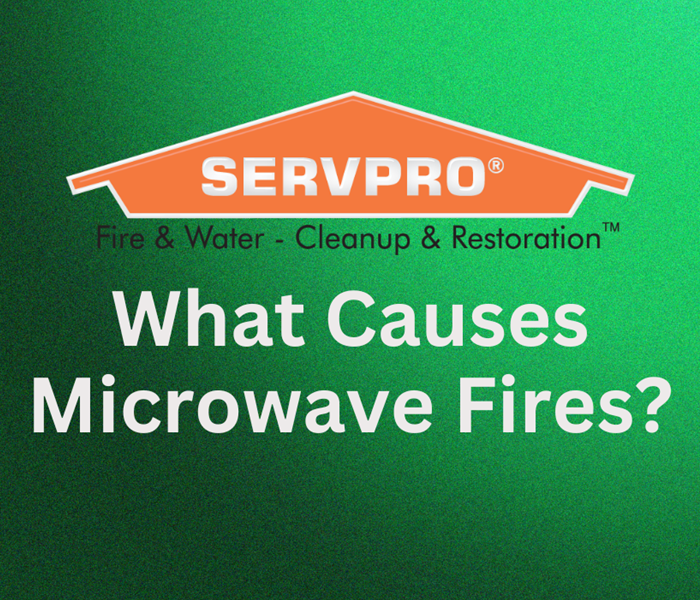 Microwaves can pose safety hazards if not used correctly. One of the most dangerous risks associated with microwaves is the possibility of a fire.
Microwaves can pose safety hazards if not used correctly. One of the most dangerous risks associated with microwaves is the possibility of a fire.
Microwaves have become an essential part of modern kitchens, allowing us to quickly heat up food and beverages. However, as with any appliance, microwaves can pose safety hazards if not used correctly. One of the most dangerous risks associated with microwaves is the possibility of a fire.
The leading cause of microwave fires is the use of inappropriate containers or dishes. Microwave-safe containers are designed to withstand the high heat generated by the microwave, while other containers may melt, warp, or even catch fire. Common materials that are not suitable for microwaving include aluminum foil, metal, plastic containers that are not labeled as microwave-safe, and dishes with metallic or gold paint. When using a microwave, it is crucial to ensure that the containers and dishes you use are labeled as microwave-safe.
Another factor that can cause microwave fires is the buildup of grease or food residue inside the appliance. When food particles accumulate on the walls or ceiling of the microwave, they can overheat and catch fire. It is essential to clean your microwave regularly, especially after cooking greasy or fatty foods. To clean your microwave, use a damp cloth or sponge to wipe the interior surfaces, and avoid using abrasive cleaning agents.
Furthermore, overheating food can also lead to microwave fires. When food is cooked for too long, or if the microwave's power settings are set too high, the food can overheat and ignite. It is vital to follow the cooking instructions carefully and to stop cooking the food once it has reached the recommended temperature. Additionally, never leave your microwave unattended while cooking, as this can lead to overheating and potential fire hazards.
Lastly, a faulty or malfunctioning microwave can also cause fires. If your microwave is making unusual noises, sparks, or emits smoke, it is essential to stop using it immediately and have it inspected by a professional. Do not attempt to repair the appliance yourself, as this can be dangerous.
Microwave fires can be dangerous and should be avoided at all costs. To prevent microwave fires, use only microwave-safe containers, keep your microwave clean, do not overheat food, and have any malfunctioning microwave inspected by a professional. By following these safety tips, you can enjoy the convenience of a microwave without putting yourself or your home at risk.
SERVPRO Of Framingham is The #1 Choice in Cleanup and Restoration for residential and commercial buildings’ fire, mold, water, and storm damage.
Can Cooking Grease Cause Fires?
5/4/2023 (Permalink)
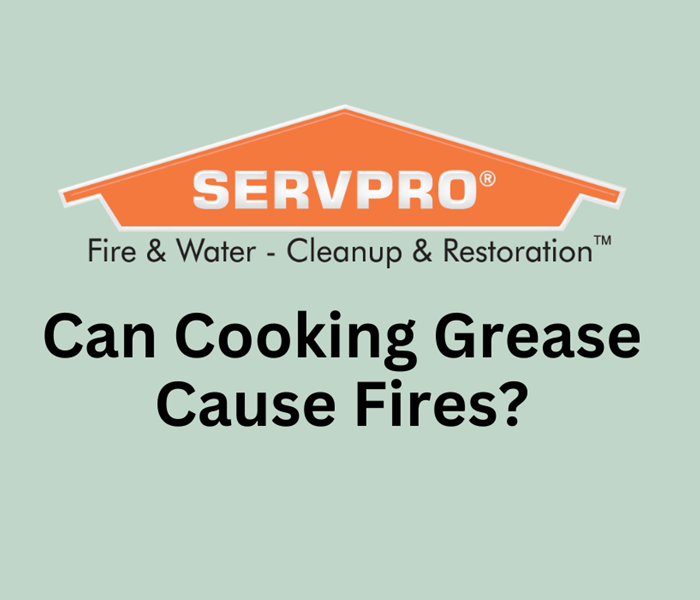 Cooking grease is the oil or fat that is left over after cooking, and it can be found in many different forms such as bacon grease, and butter.
Cooking grease is the oil or fat that is left over after cooking, and it can be found in many different forms such as bacon grease, and butter.
Cooking is a daily activity for many people, and while it can be a fun and satisfying experience, it can also be dangerous if proper safety measures are not taken. One common kitchen hazard is the risk of fires caused by cooking grease.
Cooking grease is the oil or fat that is left over after cooking, and it can be found in many different forms such as bacon grease, butter, vegetable oil, and more. It is a common ingredient in many recipes and can be very useful in the kitchen, but it can also be a serious fire hazard if not handled properly.
The reason why cooking grease is so dangerous is that it is highly flammable. If the grease becomes too hot, it can ignite and start a fire. This can happen if you leave a pan on the stove unattended or if you overheat the grease while cooking.
To prevent cooking grease fires, it is important to take a few simple precautions:
- Never leave hot grease unattended: When you are cooking with grease, it is important to stay in the kitchen and keep an eye on the pan at all times. If you need to step away, turn off the heat and remove the pan from the stove.
- Use a splatter guard: A splatter guard is a mesh screen that is placed over the top of a pan to prevent hot grease from splattering out. This can help reduce the risk of a fire.
- Keep a lid nearby: If a fire does break out, you should immediately cover the pan with a lid to smother the flames. This will help prevent the fire from spreading.
- Store grease properly: After cooking with grease, it is important to store it in a safe and secure container. This can be a metal can or a glass jar with a tight-fitting lid. Never pour grease down the drain, as this can clog pipes and cause other problems.
- Dispose of grease safely: When you are ready to dispose of the grease, wait for it to cool completely and then scrape it into a container that can be sealed. This can then be thrown away in the trash.
In addition to these precautions, it is also important to have a working fire extinguisher in the kitchen and to know how to use it. If a fire does break out, you should use the extinguisher to put out the flames. If the fire is too large or if you are not able to put it out, evacuate the building immediately and call 911.
SERVPRO Of Framingham is The #1 Choice in Cleanup and Restoration for residential and commercial buildings’ fire, mold, water, and storm damage.
Do you have a fire safety plan?
4/27/2023 (Permalink)
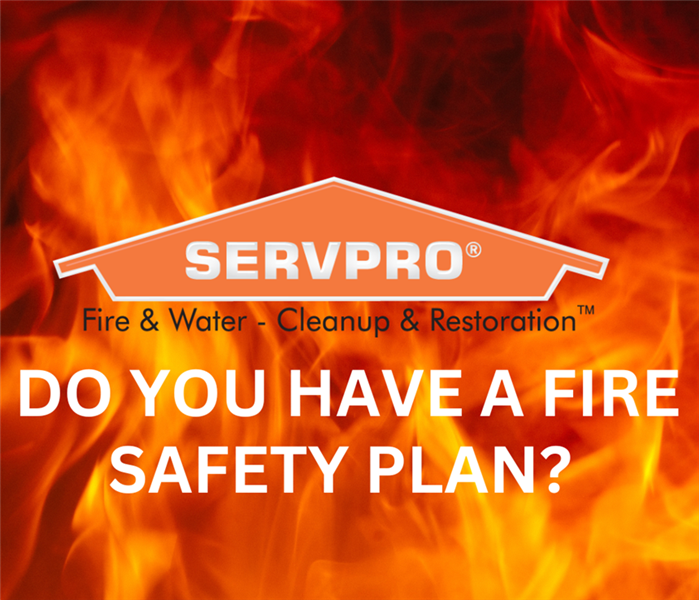 A fire safety plan is essential for keeping you and your loved ones safe during a fire.
A fire safety plan is essential for keeping you and your loved ones safe during a fire.
A fire safety plan is essential for keeping you and your loved ones safe in the event of a fire. Fires can happen suddenly and spread quickly, making it important to have a plan in place that everyone knows and can follow.
Why do you need a fire safety plan?
A fire safety plan can help you and your loved ones stay safe during a fire. It can also help prevent injuries and property damage by ensuring that everyone knows what to do in the event of a fire. Having a plan in place can reduce panic and confusion during an emergency and increase the chances of everyone getting out safely.
How to create a fire safety plan
- Draw a floor plan: Start by drawing a floor plan for your home or workplace. Identify all exits, including doors and windows, and ensure they are easily accessible.
- Determine a meeting place: Choose a safe meeting place outside of your home or workplace where everyone can gather after evacuating. This could be a neighbor's house, a street corner, or a nearby park.
- Assign responsibilities: Assign responsibilities to each person in your household or workplace. This could include tasks such as calling 911, grabbing important documents or belongings, or assisting others in evacuating.
- Practice evacuation drills: Regularly practice evacuation drills with everyone in your household or workplace. This will help ensure that everyone knows what to do in the event of a fire and can evacuate safely and quickly.
- Install smoke detectors: Install smoke detectors on every level of your home or workplace and test them regularly to make sure they are working correctly. Replace the batteries at least once a year.
- Know how to use a fire extinguisher: Make sure that everyone in your household or workplace knows how to use a fire extinguisher and where it is located.
- Review and update the plan: Regularly review and update your fire safety plan to ensure that it is still relevant and effective. Make changes as necessary, such as adding new exits or changing responsibilities.
A fire safety plan is essential for keeping you and your loved ones safe during a fire. By creating a plan and regularly practicing evacuation drills, you can increase your chances of getting out safely and prevent injuries and property damage.
We service Ashland, Framingham Centre, Framingham, Hopkinton, Nobscot, Saxonville, and Sudbury, MA
SERVPRO Of Framingham is The #1 Choice in Cleanup and Restoration for residential and commercial buildings’ fire, mold, water, and storm damage.
Grill Fire Safety Tips
4/24/2023 (Permalink)
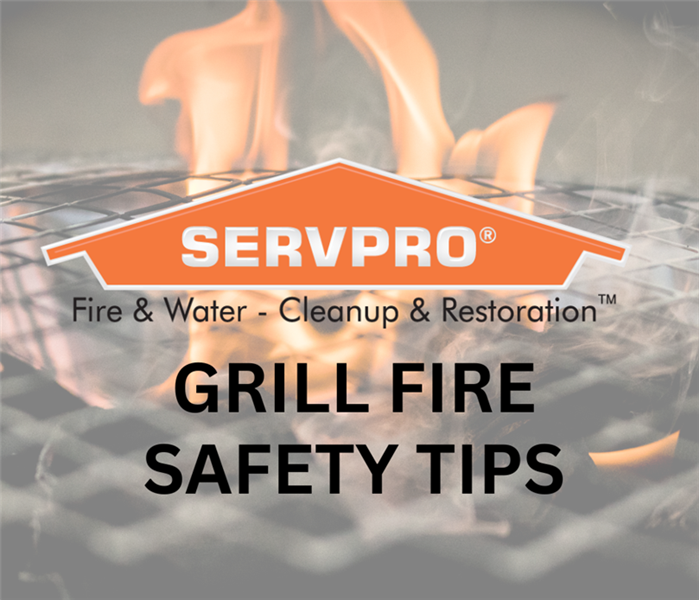 A grill fire can happen quickly and without warning, but there are steps you can take to prevent them from occurring.
A grill fire can happen quickly and without warning, but there are steps you can take to prevent them from occurring.
Grilling is a popular outdoor activity that many people enjoy during the warmer months. Whether you're cooking burgers, chicken, or vegetables, it's important to prioritize safety when using a grill. A grill fire can happen quickly and without warning, but there are steps you can take to prevent them from occurring.
Let’s discuss grill fire safety and tips to keep you and your family safe while enjoying your next cookout.
- Choose the right location for your grill: When choosing where to place your grill, ensure that it is at least 10 feet away from your home or any other combustible structures. Keep it away from overhanging branches, deck railings, and other potentially flammable objects.
- Clean your grill regularly: Cleaning your grill regularly can prevent grease buildup and reduce the risk of flare-ups. Grease fires can happen when grease and fat accumulate on the grates and drip pans. Make sure to clean your grill after every use, and occasionally deep clean it with a grill brush.
- Check for gas leaks: If you have a gas grill, make sure to check the hoses and connections for leaks before every use. A gas leak can cause an explosion or fire, so it's important to be vigilant.
- Keep a fire extinguisher nearby: In case of a fire, make sure to have a fire extinguisher nearby. Ensure that you know how to use it before you need it.
- Be mindful of what you're cooking: Some foods, like fatty meats or foods marinated in oil, are more likely to cause flare-ups. Be mindful of what you're cooking and how you're cooking it. Keep a close eye on the grill, and use a spray bottle of water to douse any small flames.
- Never leave the grill unattended: Never leave the grill unattended, especially if you have children or pets in the area. Accidents can happen quickly, and it's important to be present to address any issues that may arise.
- Shut off the grill properly: After you're finished cooking, make sure to shut off the grill properly. Turn off the burners and close the gas valve if you have a gas grill. For a charcoal grill, spread the coals out and let them cool down completely before disposing of them in a metal container.
Grilling can be an enjoyable activity, but it's important to prioritize safety to prevent a grill fire. By following these tips and being mindful of your surroundings, you can ensure that your next cookout is a safe and enjoyable experience for everyone involved.
We service Ashland, Framingham Centre, Framingham, Hopkinton, Nobscot, Saxonville, and Sudbury, MA
SERVPRO Of Framingham is The #1 Choice in Cleanup and Restoration for residential and commercial buildings’ fire, mold, water, and storm damage.
What should you do after a fire?
4/18/2023 (Permalink)
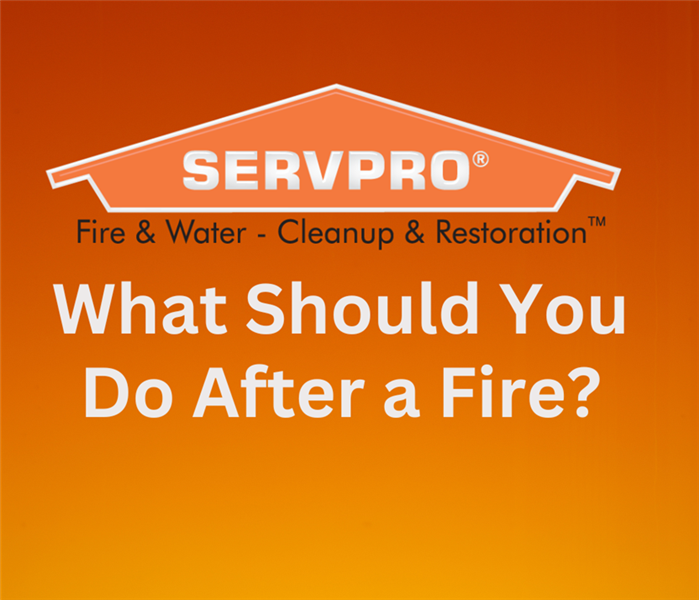 A fire can be a traumatic and devastating event, and the aftermath can be overwhelming.
A fire can be a traumatic and devastating event, and the aftermath can be overwhelming.
A fire can be a traumatic and devastating event, and the aftermath can be overwhelming. However, it's important to take immediate action to start the process of recovery and ensure the safety of your home and family.
Here are some steps you should take after a fire:
- Contact your insurance company: One of the first things you should do after a fire is to contact your insurance company. They can help you start the claims process and provide guidance on what steps to take next.
- Assess the damage: Once it is safe to do so, assess the damage to your home. Look for any visible damage, including structural damage, water damage, and smoke damage. Take photos of the damage to provide to your insurance company.
- Secure your property: If your home is severely damaged, you may need to board up windows and doors or cover damaged areas to prevent further damage from weather or vandalism.
- Contact restoration professionals: A professional restoration company can help you with the cleanup, salvage, and restoration of your home and belongings. They can also help you assess the extent of the damage and provide guidance on the best course of action.
- Salvage what you can: If it is safe to do so, try to salvage any belongings that were not damaged by the fire. You may be able to save some items with proper cleaning and restoration.
- Address smoke damage: Smoke can cause extensive damage to a home, even in areas not directly affected by the fire. Be sure to address smoke damage to prevent health hazards and further damage to your home.
- Ensure safety: Before returning to your home, ensure that it is safe to do so. Check for gas leaks, electrical hazards, and other safety concerns.
By contacting your insurance company, assessing the damage, securing your property, contacting restoration professionals, salvaging what you can, addressing smoke damage, and ensuring safety, you can begin to rebuild and move forward after a fire.
We service Ashland, Framingham Centre, Framingham, Hopkinton, Nobscot, Saxonville, and Sudbury, MA
SERVPRO Of Framingham is The #1 Choice in Cleanup and Restoration for residential and commercial buildings’ fire, mold, water, and storm damage.
What Are The Causes Of Fire?
2/15/2023 (Permalink)
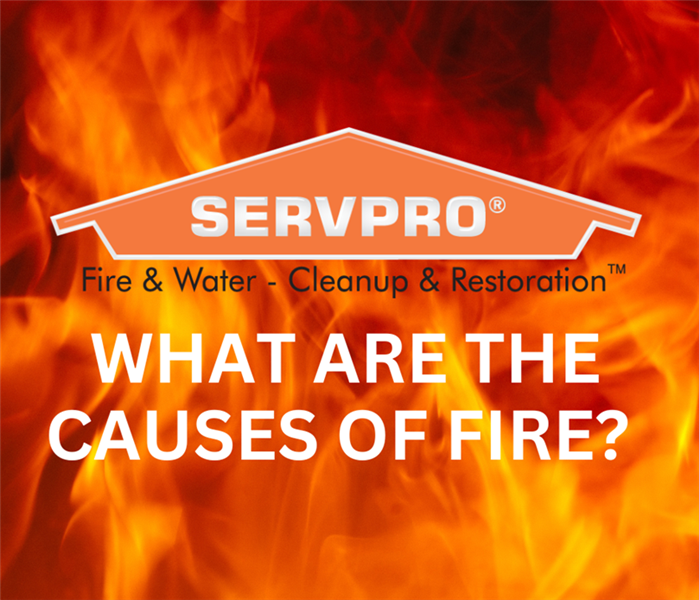 Fires are a natural disaster that can have significant impacts on people, animals, and the environment.
Fires are a natural disaster that can have significant impacts on people, animals, and the environment.
Fires are natural disaster that can occur in many different forms, from small brush fires to large-scale forest fires. They can happen at any time, and they can be devastating in terms of the damage they can cause to property, natural habitats, and human lives. In this blog post, we will explore some of the key aspects of fires, including their causes, impacts, and prevention.
Causes of Fires
Fires can be caused by a wide range of factors, including natural causes such as lightning strikes, as well as human activities such as campfires, cooking, and smoking. In some cases, fires can also be caused by electrical faults or mechanical failures, such as faulty wiring or overheated equipment. In recent years, climate change has been identified as a major contributor to the increased incidence and severity of fires, as rising temperatures and changing weather patterns have created more favorable conditions for fires to occur.
Impacts of Fires
The impacts of fires can be far-reaching and long-lasting, affecting everything from the immediate safety of people and animals to the long-term health of ecosystems. In the short term, fires can cause injury and death to people and animals, as well as damage to property and infrastructure. In the long term, fires can have significant impacts on natural habitats, including loss of vegetation, changes in soil composition, and loss of biodiversity. Fires can also have a significant impact on the climate, releasing large amounts of carbon dioxide and other greenhouse gases into the atmosphere.
Prevention of Fires
Preventing fires requires a multi-faceted approach, including education, awareness, and proactive measures. This includes educating people about the risks and causes of fires, as well as providing information on how to prevent them. Some of the key preventative measures include regular maintenance of electrical equipment, avoiding open fires in high-risk areas, and ensuring that campfires are extinguished completely before leaving the site. Other important steps include monitoring weather conditions and fire danger ratings, as well as being prepared to evacuate in the event of an emergency.
Fires are a natural disaster that can have significant impacts on people, animals, and the environment. While they can be difficult to prevent, there are many steps that can be taken to reduce the risk of fires and mitigate their impacts. By working together and taking a proactive approach to fire prevention, we can help to protect our communities, natural habitats, and the planet as a whole.
SERVPRO of Framingham is your premier choice for fire damage and restoration. Our teams are ready to respond 24 hours a week, any day of the year. When you bring us on the job our team of licensed contractors and certified technicians will work collaboratively with you throughout the duration of the project. They will keep you updated on the project's status and ensure that your expectations are met. We will help you to move forward and make it “Like it never even happened” for all of your fire damage.
SERVPRO of Framingham: How to Deal with Fire in the Workplace: Tips and Strategies"
2/5/2023 (Permalink)
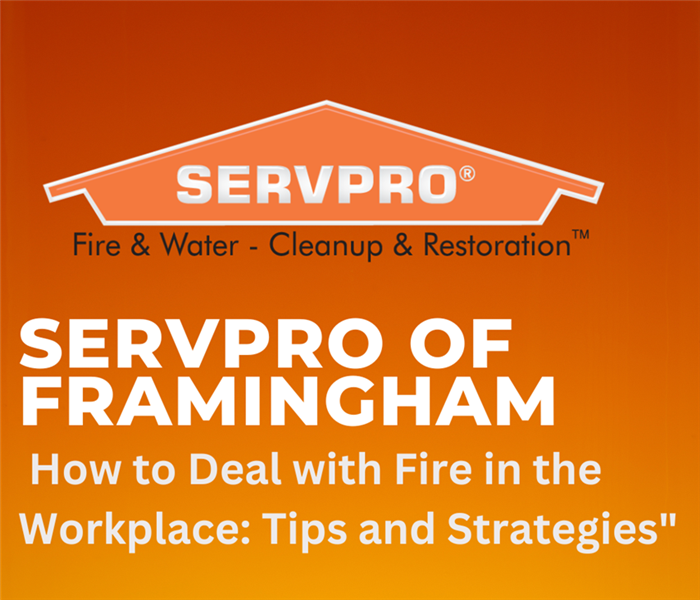 Having a fire response plan in place and understanding the proper procedures to follow can help prevent damage, minimize injury and ensure safety
Having a fire response plan in place and understanding the proper procedures to follow can help prevent damage, minimize injury and ensure safety
A fire can happen at any time and place, and it is crucial for businesses to be prepared. Having a fire response plan in place and understanding the proper procedures to follow can help prevent damage, minimize injury and ensure the safety of everyone in the workplace.
Here are some tips and strategies to help you deal with fire in your business:
- Establish a fire response plan: This should include the proper procedures to follow in case of a fire, such as evacuation procedures, and the designated meeting place for employees after evacuation.
- Install fire alarms and fire suppression systems: Fire alarms should be placed throughout the workplace, and fire suppression systems such as sprinklers should be installed to help put out the fire.
- Regularly inspect and maintain fire equipment: Regular inspections and maintenance of fire alarms, fire suppression systems and other fire equipment is essential to ensure they are functioning properly and can be used in the event of a fire.
- Conduct regular fire drills: Regular fire drills are important to help employees understand what to do in the event of a fire, and to ensure that everyone is prepared.
- Store flammable materials properly: Flammable materials should be stored in fireproof cabinets, away from heat sources and potential sources of ignition.
- Train employees: Employees should be trained on the proper procedures to follow in case of a fire, including how to evacuate the building, how to use fire extinguishers, and how to report the fire.
- Have an emergency evacuation plan: An emergency evacuation plan should be in place and clearly communicated to all employees. This should include the designated meeting place for employees after evacuation.
By following these tips and strategies, you can help prevent damage, minimize injury, and ensure the safety of everyone in your workplace in case of a fire. Remember, being prepared and knowing the proper procedures to follow can help you effectively deal with a fire and get back to business as soon as possible.
SERVPRO of Framingham is your premier choice for fire damage and restoration. Our teams are ready to respond 24 hours a week, any day of the year. When you bring us on the job our team of licensed contractors and certified technicians will work collaboratively with you throughout the duration of the project. They will keep you updated on the project's status and ensure that your expectations are met. We will help you to move forward and make it “Like it never even happened” for all of your fire damage.
SERVPRO of Framingham Shares How to Deal with Fire and Smoke Damage in a Home or Business
1/11/2023 (Permalink)
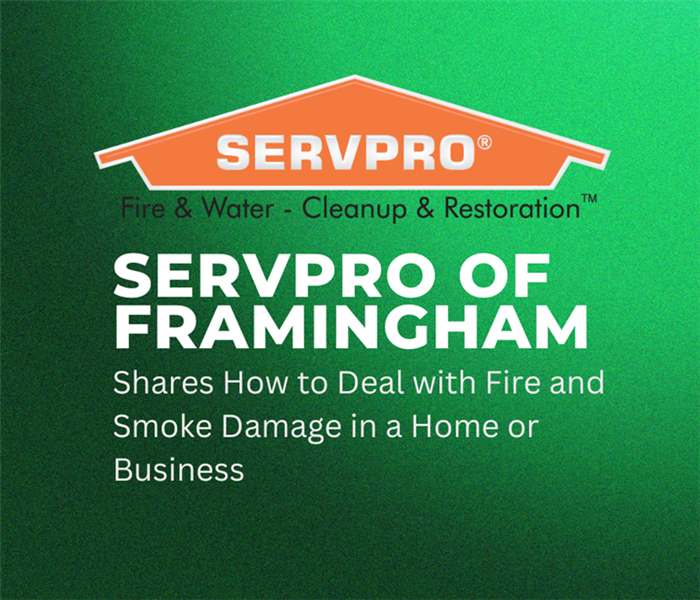 It is not common for fire loss, soot damage, or smoke damage problems to occur in any building.
It is not common for fire loss, soot damage, or smoke damage problems to occur in any building.
It is not common for fire loss, soot damage, or smoke damage problems to occur in any building. However, trying to get things back in order is daunting and traumatic.
Things can be gone in a matter of minutes without any preparation for fire loss.
When a firefighter enters a fire in a home or a fire a business property, their first defense is to use lots of water to extinguish the fire. The steps that firefighters take to control the fire will leave back ashes, fire loss, soot damage, smoke damage or air quality problems. You will need to hire a professional to get the remainder of the damage taken care of. SERVPRO of Framingham is trained in a variety of different related clean-up including the latest professional equipment, tools, and procedures.
With our fire cleanup efforts, the business can get back to business as soon as it is physically possible.
Smoke and fire damage situation is different for everyone, each situation requires a unique solution tailored to the specific conditions.
SERVPRO of Framingham is your premier choice for fire damage and restoration. Our teams are ready to respond 24 hours a week, any day of the year. When you bring us on the job our team of licensed contractors and certified technicians will work collaboratively with you throughout the duration of the project. They will keep you updated on the project's status and ensure that your expectations are met. We will help you to move forward and make it “Like it never even happened” for all of your fire damage.
SERVPRO of Framingham Gives Holiday Safety Advice
12/4/2022 (Permalink)
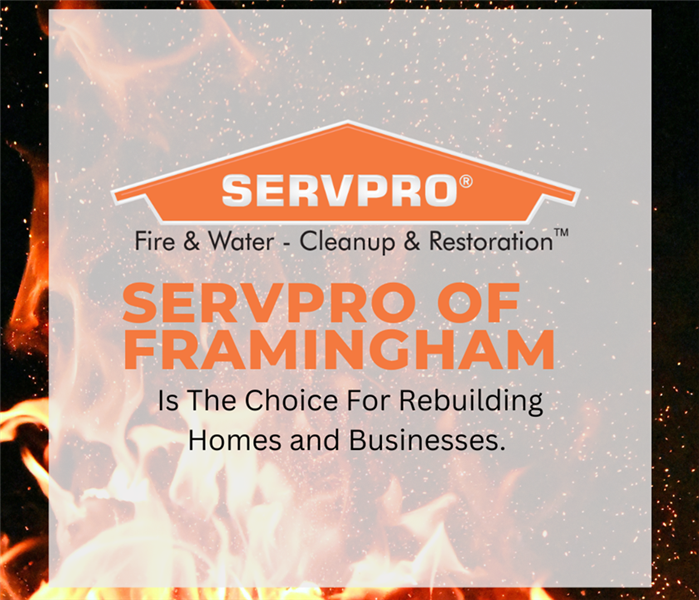 With Christmas, there can be more fires than normal. Christmas lights make the holiday season bright; we decorate trees and homes with lights.
With Christmas, there can be more fires than normal. Christmas lights make the holiday season bright; we decorate trees and homes with lights.
It is everyone’s favorite time of the year! With Christmas, there can be more fires than normal. Christmas lights make the holiday season bright; we decorate trees and homes with lights.
These decorations can have a risk though and electrocution is possible. With proper preparation and safe practices, you can avoid those dangerous situations while decorating.
Here are the safety tips you need to know.
- A missing or broken bulb can lead to shocks or even fires.
- Replace any broken bulbs before you string up your home or tree.
- If you decorate your home's exterior, make sure to use a ladder that isn’t metal.
- Make sure to use lights that are labeled as indoors for your indoor lights and ones labeled outdoors for your outdoor lights.
- Check to make sure your lights are labeled as waterproof, especially outdoors.
- Always use an extension cord that is rated for outdoor use.
- Keep your cords from sitting on the ground.
- Make sure your light cord and your extension cord stay out of puddles or snow.
- Keep your light strands off the ground.
- Don't make your lights a year-long attraction. Lights, including smart lights, should not be used for long terms.
- Leave cords out of doors and windows. The cord could become pinched. This can ruin the insulation around the wires and lead to a shock.
Should you experience a fire, call 911 immediately and call your local fire restoration company.
SERVPRO of Framingham is your premier choice for fire damage and restoration. Our teams are ready to respond 24 hours a week, any day of the year. When you bring us on the job our team of licensed contractors and certified technicians will work collaboratively with you throughout the duration of the project. They will keep you updated on the project's status and ensure that your expectations are met. We will help you to move forward and make it “Like it never even happened” for all of your fire damages.
Fall Safety From SERVPRO of Framingham
10/5/2022 (Permalink)
 Now that fall is here, it is a good idea for everyone in your home to refresh their fall fire safety tips.
Now that fall is here, it is a good idea for everyone in your home to refresh their fall fire safety tips.
Now that fall is here, it is a good idea for everyone in your home to refresh their fall fire safety tips.
These fire tips are especially important for children and families.
- Check Smoke Detectors & Fire Extinguishers.
- Change batteries in smoke detectors and carbon monoxide detectors.
- Verify that smoke detectors are working.
- Make sure that there are smoke detectors in your home.
- Make sure everyone knows how to use a fire extinguisher.
- Make Sure All Heating Sources Work Properly
- Verify that everything you need to keep your home warm throughout fall and winter is working.
- Make sure that any space heaters are surrounded by at least three feet of empty space.
- Never place clothing or any other objects on a space heater.
- Do not place space heaters near furniture or drapery.
If you aren’t sure about any of these tips, reach out to a local firefighter, they will be able to assist you and answer any questions. Help prevent a fire as best as you possibly can.
SERVPRO Framingham is your premier choice for restoration and rebuilding. Our teams are ready to respond 24 hours a week, any day of the year. When you bring us on the job our team of licensed contractors and certified technicians will work collaboratively with you throughout the duration of the project. They will keep you up to date on the status of the project and make sure that your expectations are met. We will help you to move forward and make it “Like it never even happened” for all of your storm damage.
SERVPRO of Framingham Talks About Campfire Safety
8/8/2022 (Permalink)
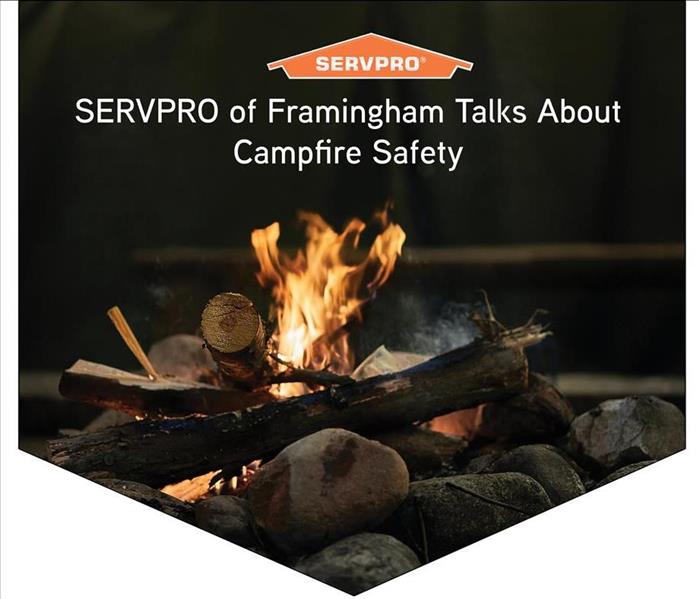 Enjoying a campfire is one of the most enjoyable parts of camping. A campfire that is not properly built, maintained and extinguished can cause damage
Enjoying a campfire is one of the most enjoyable parts of camping. A campfire that is not properly built, maintained and extinguished can cause damage
Enjoying a campfire is one of the most enjoyable parts of camping. A campfire that is not properly built, maintained, and extinguished can quickly become a hazard. It's important to understand how to safely enjoy your campfire.
- Know the rules: Before you strike a match, make sure you know the fire regulations of the campground or wilderness area.
- Use the pit: Most campgrounds provide a fire pit to build a campfire. If a pit is provided, this is the only place you should build a campfire. If not, dig a fire pit in an open area away from overhanging branches and power lines.
- Build a safe campfire: Start the fire with dried leaves or grass that will easily catch fire. Next, add small twigs and sticks that are less than an inch. As the fire builds, add the largest pieces of wood to the fire. This keeps the fire burning for a longer period of time.
Keep in mind that your fire does not have to be roaring. In fact, a small fire surrounded by rocks will do the job. Always make sure to take caution whenever you are creating a fire.
SERVPRO of Framingham is available 24/7 including holidays and weekends to assist you and help you with commercial damage. “Like it never even happened.”
SERVPRO of Framingham Shares Spring Fire Safety
4/15/2022 (Permalink)
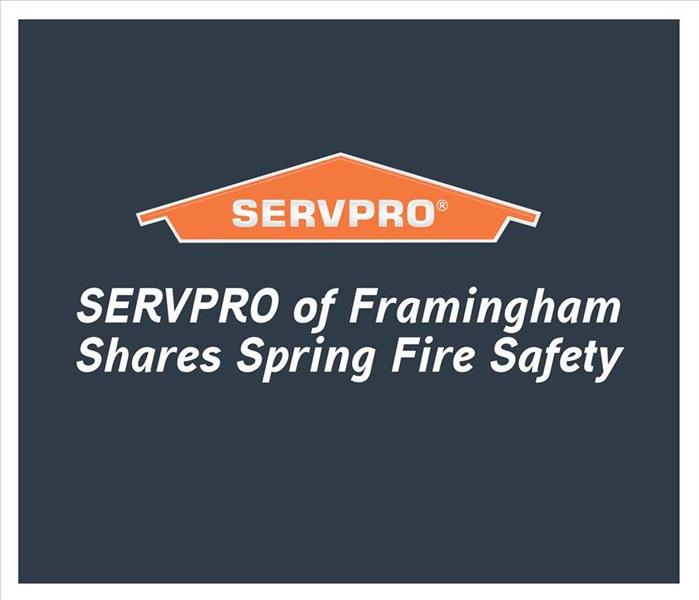 The last thing that anyone wants is for a fire to damage their home or office. Preventing a fire is possible.
The last thing that anyone wants is for a fire to damage their home or office. Preventing a fire is possible.
The last thing that anyone wants is for a fire to damage their home or office. Preventing a fire is possible.
Here are some tips to help you prevent fires:
- Ensure all your heating sources are working properly: Make sure to change air filters regularly.
- Clean your stove and oven: Food particles that accumulated at the bottom of the burner could culprit.
- Pay attention when cooking: Even if it’s just a pot of boiling noodles, never leave cooking unattended.
- Check your dryer’s airflow: Make sure your vents are not clogged.
- Store flammable products safely: Household cleaners are classified as flammable products. They can combust when placed too close to a large heat source.
- Use caution with candles: Always put the candles out if you’re leaving a room.
Losing everything to a fire is a devastating experience. This is why you should protect your building whenever possible. These simple tips might help you prevent a fire.
SERVPRO of Framingham is available 24/7 including holidays and weekends to assist you and help you with residential damage. “Like it never even happened.”
SERVPRO of Framingham Shares Spring Cleaning Tips
4/12/2022 (Permalink)
 Check Smoke and Carbon Monoxide Detectors to help prevent fires.
Check Smoke and Carbon Monoxide Detectors to help prevent fires.
It's spring season and that means it’s time to spring clean!
Most look at spring cleaning as a chance to remove dust from places and go through boxes stacked in their garage, it’s also important that you pay attention to fire safety.
Here are a few tips for you to follow:
- Check Smoke and Carbon Monoxide Detectors: Replace the batteries in your smoke alarms and carbon monoxide detectors. Make sure to also test each one.
- Make Your Kitchen Safe: Spills in your kitchen increase the likelihood of a fire breaking out. Clean up spills right away to keep grease from collecting on your counters.
- Inspect Electrical Cords: Electrical cords can become damaged and frayed over time. Check the cords in your house to see if there is any damage. If they are damaged, replace them immediately.
SERVPRO of Framingham is available 24/7 including holidays and weekends to assist you and help you with fire damage. “Like it never even happened.
SERVPRO of Framingham Shares Fire Safety Information
4/12/2022 (Permalink)
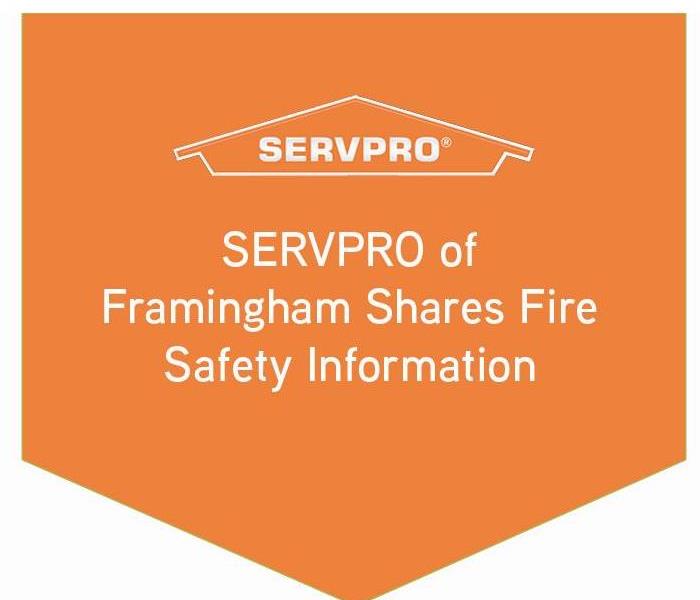 A fire disaster can cause damage to the structure of your home. Here are some tips for fire safety
A fire disaster can cause damage to the structure of your home. Here are some tips for fire safety
In your lifetime you hope to never experience fire damage to your home. A fire disaster can cause damage to the structure of your home.
Here are some tips for fire safety:
- Working smoke alarms give you early warning so you can get out.
- A closed-door may slow the spread of smoke, heat, and fire.
- Install smoke alarms in every sleeping room.
- Large homes may need extra smoke alarms.
- Test all smoke alarms at least once a month.
- A smoke alarm should be on the ceiling or high on a wall.
- Keep smoke alarms away from the kitchen; they should be at least 10 feet from the stove.
- Replace all smoke alarms when they are 10 years old.
Smoke alarms are an important part of a home fire escape plan, so make sure that you follow these few tips.
SERVPRO of Framingham is available 24/7 including holidays and weekends to assist you and help you with fire damage. “Like it never even happened.
SERVPRO of Framingham Shares Grill Safety Tips
4/12/2022 (Permalink)
 It’s important to follow a few safety tips before firing up the grill to help prevent fires.
It’s important to follow a few safety tips before firing up the grill to help prevent fires.
Springtime is here, and that means grilling is happening more. It’s important to follow a few safety tips before firing up the grill to help prevent fires.
- Only use your grill outside.
- Keep the grill at least 3 feet from siding, deck rails, and eaves.
- Open your gas grill before lighting.
- Keep an eye on your grill, fire pit or patio torches.
- Clean your grill after each use; this will remove grease that can start a fire.
We know that fires can happen, but it is important to take precautions whenever possible.
SERVPRO of Framingham is available 24/7 including holidays and weekends to assist you and help you with fire damage. “Like it never even happened.
SERVPRO of Framingham Talks About Fire Damage
2/6/2022 (Permalink)
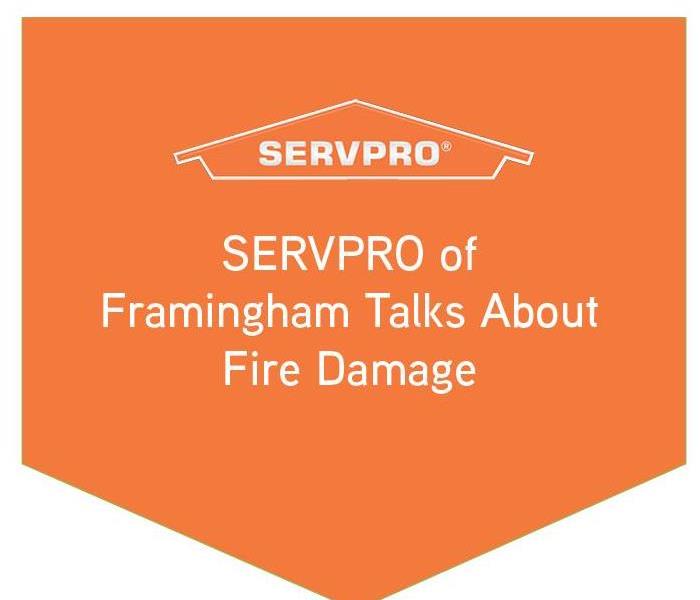 Our homes have more electricity than ever before. If things are not running properly a fire can break out.
Our homes have more electricity than ever before. If things are not running properly a fire can break out.
Electricity is essential and we rarely think twice about it when we flick a switch. Our homes have more electricity than ever before. If things are not running properly a fire can break out. Here are some tips to help prevent a fire.
- Check electrical outlets for loose-fitting plugs or exposed wires.
- Don’t force plugs into outlets and do not overload outlets with adapters.
- Make sure cords are not frayed or cracked.
- Extension cords are designed for temporary use only.
- Light bulbs should be the correct wattage for the fixture’s design, also make sure they are screwed in tightly.
- Install Ground Fault Circuit Interrupters anywhere water could be kitchens, bathrooms, laundry, workshop, garage, basement, and outside.
- Loose wires or fixtures are common flashpoints for fires.
Fires are a horrible disaster, it is important to know how to prevent one and share with others too.
SERVPRO of Framingham is available 24/7 including holidays and weekends to assist you and help you with fire damage. “Like it never even happened.”
SERVPRO of Framingham Shares The Top Eight Reasons For Fires
2/6/2022 (Permalink)
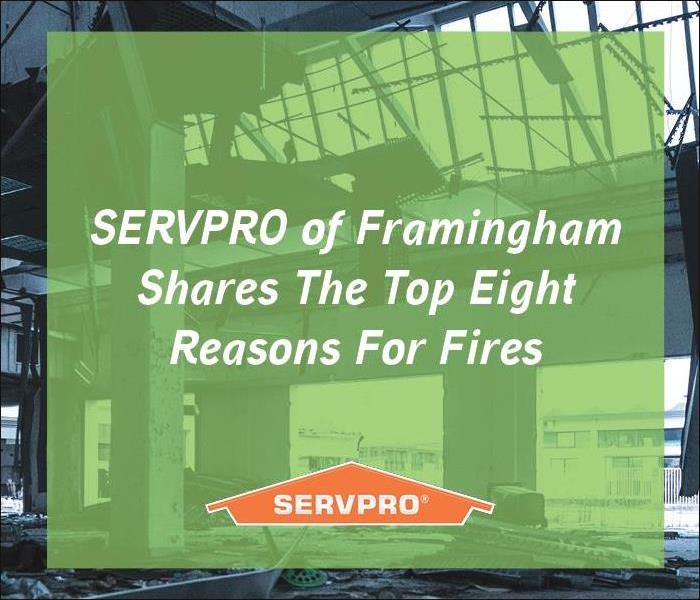 The key to fire prevention is knowing the most common causes, so you can help prevent it as best as you can.
The key to fire prevention is knowing the most common causes, so you can help prevent it as best as you can.
Fires can happen, though they can be impossible to prevent, there are still some important factors to understand. The key to fire prevention is knowing the most common causes, so you can help prevent it as best as you can.
Here are the top eight causes of fires:
- Cooking: Never leave a stove unattended. Make sure to keep a fire extinguisher nearby.
- Kids Playing with Fire: Parents should make sure that young children don’t have access to matches, lighters, and easily flammable liquids.
- Smoking: An unattended burning cigarette or even a few fallen ashes on a carpet can ignite a serious fire.
- Heating: Space heaters are extremely flammable; keep them away from furniture and flammable items.
- Electrical: A power cord or faulty extension cord, can have your home in flames in a short amount of time.
- Candles: Always ensure all candles are blown out before leaving the room.
- Fireplace: Unattended fires are the main cause of fireplace-centered house fires.
- Dryers: Dryers are loaded with debris, are highly flammable; this can lead to fires. Remove the lint screen after every use.
SERVPRO of Framingham is available 24/7 including holidays and weekends to assist you and help you with fire damage. “Like it never even happened.”
SERVPRO of Framingham Shares Fire Extinguisher Use And Safety
2/6/2022 (Permalink)
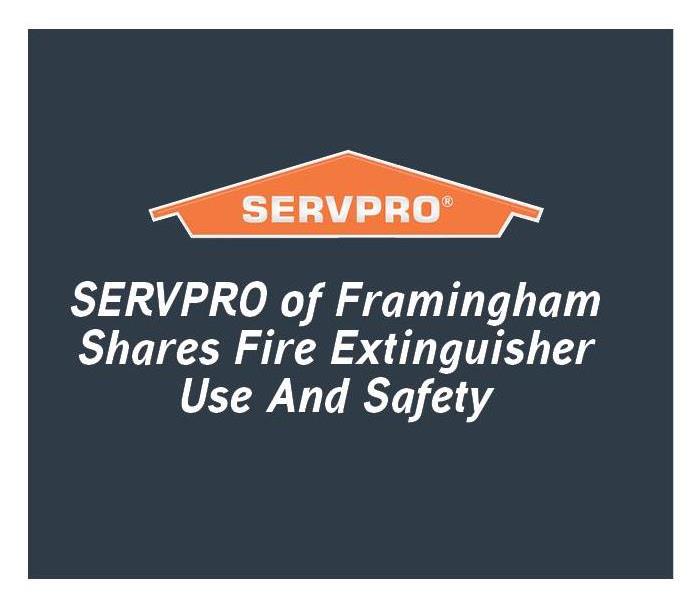 A portable fire extinguisher can be a saving tool. Here are some quick tips on how you can use a fire extinguisher correctly
A portable fire extinguisher can be a saving tool. Here are some quick tips on how you can use a fire extinguisher correctly
A portable fire extinguisher can be a saving tool. Here are some quick tips on how you can use a fire extinguisher correctly:
- Pull the pin, pointing away from you, and release the locking mechanism.
- Aim low, and then point at the base of the fire.
- Squeeze the lever slowly and evenly.
- Sweep from side to side.
Make sure to read the instructions on the fire extinguisher. You will want to become familiar with it before a fire breaks out. Also, it is important to encourage family members and coworkers to become familiar with it.
Remember, extinguishers do have their limitations! It is also important to ensure you have the correct type of extinguisher for your home or facility. Make sure you have the right one for your home or office.
SERVPRO of Framingham is available 24/7 including holidays and weekends to assist you and help you with fire damage. “Like it never even happened.”
Common Fire Causes
10/17/2021 (Permalink)
A fire can be a devastating loss to anyone. Here are some common causes of fire within your home or business:
Smoking Indoors
Many people smoke in their homes. A fire can be started from a simple ash falling to someone falling asleep with a light cigarette. Smoking in your home is not only dangerous but also damaging to the homes structure.
Unmaintained Dryer Vents
Lint accumulates quickly! Cleaning your dryer vents regularly is extremely important, preferably after or before every load. It only takes one small spark or too much heat for lint to burn.
Faulty Electrical Equipment
Always make sure the wires on your appliances are not stripped or exposed in any way.
Overloading Outlets
Another electrical hazard is overloading an outlet or extension cord. Never plug multiple power outlets into each other
Candles
Candles should always be put out when leaving the home. Always make sure they are on a level surface and away from any fabrics or fire starters.
Space Heaters
Space heaters have the potential to be very dangerous. Nothing should be left to close in front or back of a space heater. The unit itself can get very hot, not to mention the air it disperses.
Cooking
Always keep a fire extinguisher in your kitchen. Many things can go wrong while cooking. Especially with open flame, gas stoves.
If a fire causes damage to your commercial or residential property, please call SERVPRO of Framingham at (508) 370-4400
Fire Safety Tips for Fall in Framingham
8/29/2021 (Permalink)
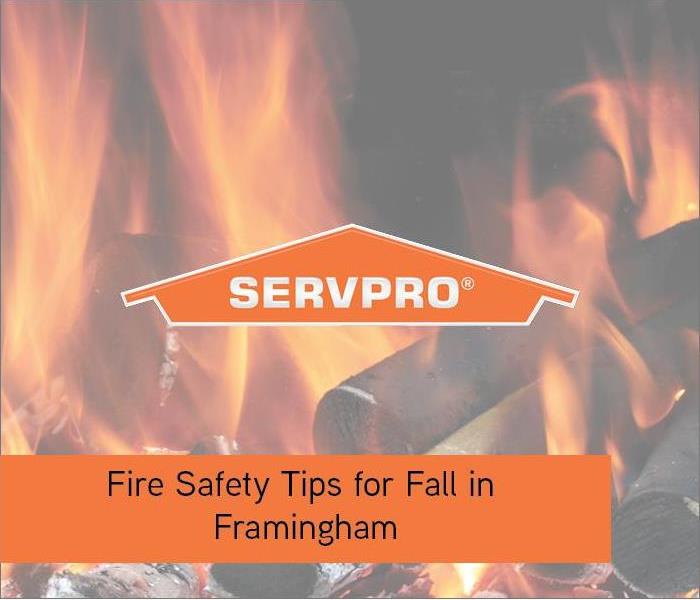 There’s nothing cozier than spending time with a fireplace or furnace to keep warm as the weather turns colder.
There’s nothing cozier than spending time with a fireplace or furnace to keep warm as the weather turns colder.
There’s nothing cozier than spending time with a fireplace or furnace to keep warm as the weather turns colder. However, there are also safety hazards.
Have Your Furnace Serviced: You will want to have your furnace inspected by your heating and cooling company. Ask them to check for leaks and ensure it is working properly.
Be Careful Using Your Fireplace: Screens are crucial so that it keeps flying sparks safely inside the fireplace.
Use Caution with Space Heaters: Space heaters are a great way to chill out of the air. Just make sure that you read the heater’s instructions before use and allow at least three feet of empty space around the heater.
Leaf Burning Could Be Dangerous: Burning leaves contain dangerous, make sure to wear a protective mask if you decide to do so. Never burn leaves on a windy day and burn them far away from your home.
Exercise Candle Safety: Candles give a wonderful ambiance to a room but can also pose a fire hazard; never leave candles unattended. Also, make sure to keep them away from pets and children.
SERVPRO of Framingham is available 24/7 including holidays and weekends to assist you and help you with residential fire damage. “Like it never even happened.”
After A Fire Fix Your Roof First
4/28/2021 (Permalink)
The aftermath of even a small or partial-loss fire at your Framingham, MA, commercial property can have lingering effects. While the first concern may be the fire cleanup, the potential for further issues to occur should also be a top priority if the roof was damaged. As you wait for the roof repair to take place, leaving it exposed means opening the building up to potential problems.
Roof Damage Woes
Fire cleanup doesn’t happen overnight. Calling a fire damage and restoration expert that is Faster to Any Size Disaster is the first step in ensuring speedy and professional repairs. In the interim, whether the hole was caused by the fire, or firefighters had to create an opening for ventilation, it leaves the structure vulnerable to non-fire losses or worries:
- Cost – The longer the roof is exposed, the higher the potential for further environmental damage that can quickly increase repair costs.
- Vandalism – While it depends on the extent of the roof destruction, the gap could create an access point for vandals or thieves.
- Pests – Animals and insects can easily find their way in through the smallest spaces.
- Safety – If the damage isn’t severe, you may be able to continue operating out of the business structure, but that could mean a potential safety hazard for anyone in the building.
Temporary Covering
Although not a permanent fix, using a tarp is an ideal way to minimize secondary damage or other issues. An expert will properly affix boards and tarps to keep debris and precipitation from entering through the ruined areas. Regardless of the type of roof, they will have the know-how to securely seal off entry points and create an insulation barrier to help minimize costly repairs while determining whether the roof needs to be fixed or replaced.
We Are Here For You
The Disaster Remediation Teams at SERVPRO of Framingham have specialized training and experience in fire restoration services. Call SERVPRO of Framingham at (508) 370-4400 if fire damage strikes your property. We will make it "Like it never even happened."
How To Safely Put Out A Grease Fire
4/28/2021 (Permalink)
While it's true that a fire can start anywhere in your home, the kitchen is one of the most common places. There are a lot of hazards in this room, so you need to be cautious when you're cooking on the stove or using the oven. A grease fire is one of the most concerning types of fires you could encounter at home. Extinguishing these fires is not the same as most kinds.
What Causes Grease Fires?
If you're like many people in Hopkinton, MA, you probably use your fair share of cooking oil on the stove. Whether it's frying up bacon or sausage for breakfast or grilling up something else delicious on the stove or griddle, you may frequently contend with grease. The common reasons a grease fire may start include:
- Putting too much oil in the pan
- Leaving the room while something is frying or grilling on the stove
- Leaving panhandles away from the stove where other people can bump into them
Smother It Quickly
If a grease fire starts in the kitchen, don't panic. Your first job is to smother the flames and remove the fire's oxygen source. You can do this by grabbing a metal lid and covering the pan or burner.
Remove The Heat
You need to next kill the heat source. Turn off the stove or unplug the electric griddle.
Try Some Baking Soda
If the fire is still going, dump a liberal amount of baking soda on the flames. This should do enough to smother the flames and control the fire. It may require some fire cleanup, but you can control the damage.
What NOT To Do
Your first reaction to putting out a fire may be to dump water on the source. With grease, this won't work; it will only spread the flames. Never put water on these types of fires.
By following these pointers, you can stay away from these disasters.
We Are Here For You
The Disaster Remediation Teams at SERVPRO of Framingham have specialized training and experience in fire restoration services. Call SERVPRO of Framingham at (508) 370-4400 if fire damage strikes your property. We will make it "Like it never even happened."
Fire Safety Tips for Framingham, MA
4/28/2021 (Permalink)
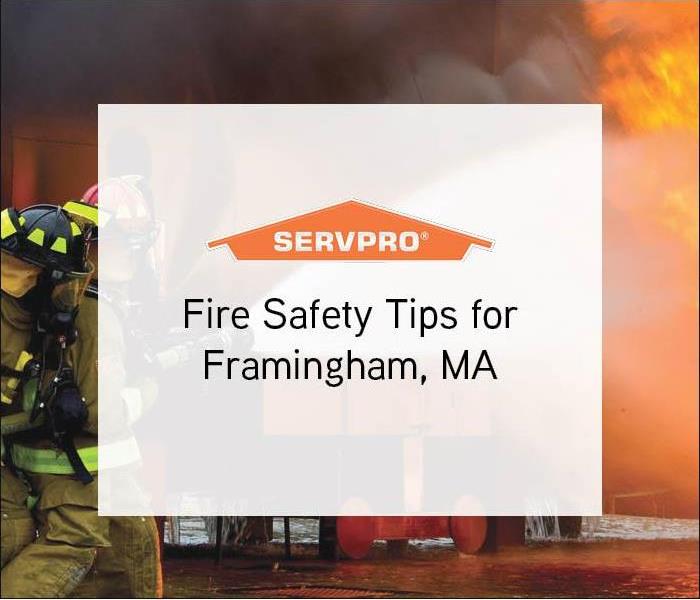 If you find yourself in need of fire restoration to your home or business, give SERVPRO Framingham, MA a call.
If you find yourself in need of fire restoration to your home or business, give SERVPRO Framingham, MA a call.
Fires are one of the worst things that can happen to anyone. It is hard to prevent a fire since it can happen at any time. However, there are a few simple quick tricks that you can do to prepare for a fire should it come.
- Install smoke alarms inside bedrooms and on all levels of your home.
- You should test smoke alarms every month. If they’re not working check the batteries, if it still doesn’t work, get a new smoke detector.
- You should talk with all family members about a fire escape plan. More importantly, you will want to practice the plan twice a year.
- It is important to educate children about what smoke alarms sound like, but also what to do if they hear one.
- Make sure to ensure that all household members know how to escape from every room of your home.
- Make sure to establish a family emergency communications plan.
- You want to make sure everyone knows how to call 9-1-1, especially children.
If you find yourself in need of fire restoration to your home or business, give SERVPRO Framingham, MA a call at (508) 370-4400, we respond faster to any size disaster.
Tips for if a fire starts in Framingham, MA
4/28/2021 (Permalink)
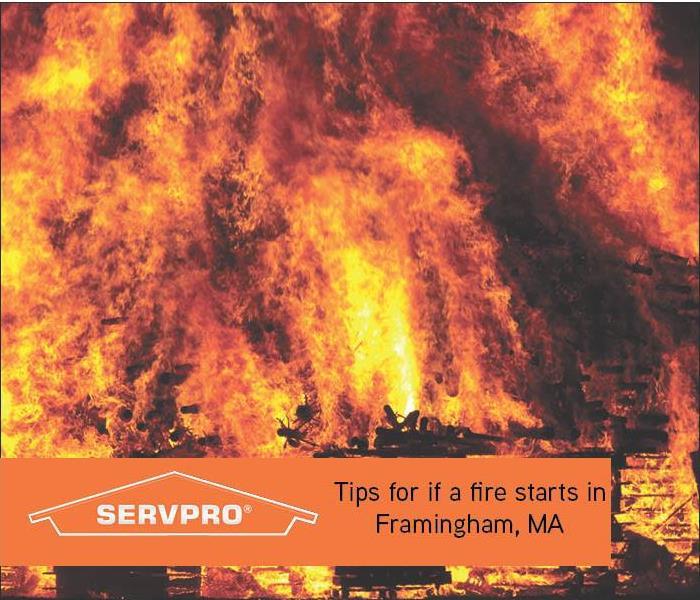 If you find yourself in need of fire restoration to your home or business, give SERVPRO Framingham, MA
If you find yourself in need of fire restoration to your home or business, give SERVPRO Framingham, MA
Fires can happen at any time, anywhere. It is one of those things no one can really prepare for, we can only understand what they are capable of doing and try to understand what to do if a fire happens.
However, it is great to know the basics of what to do if a fire starts for your own safety:
- Know how to safely operate a fire extinguisher. You should have a few in your home or business office that are easily accessible.
- GET OUT and STAY OUT. CALL 9-1-1 or your local emergency phone number. Do not go back in whatsoever.
- If you are in a building with elevators, use the stairs. Leave all your things where they are and get out. Make sure you are far enough away from the building once you are outside.
- If closed doors or handles are warm or smoke blocks your primary escape route, use the second way out. Do not open doors if they are warm or you can see the smoke.
- If you have to escape through smoke, get low. You will want to make sure to go under the smoke to your exit. Close any doors behind you.
- If smoke, heat, or flames are blocking your exit routes make sure to stay in the room with doors closed. If you are stuck in there, place a wet towel under the door and call the fire 9-1-1. In the meantime, open a window and wave a brightly colored cloth for help.
Don’t forget if you are a business owner and do not have an Emergency Readiness Plan, we suggest setting one up. It will help in times with this to ensure you have an emergency plan ready for your staff. We at SERVPRO Framingham, MA can help guide you and set it up.
If you find yourself in need of fire restoration to your home or business, give SERVPRO Framingham, MA a call at (508) 370-4400, we respond faster to any size disaster.
Fire Alarms
2/8/2021 (Permalink)
When a fire starts in your Holliston, Ma commercial or residential property time is not on your side. You only have so much time to leave the premises and call for help. Every second counts. If you encounter a fire, you will be thankful to have a fire alarm that gives you a head start. Your property should be outfitted with multiple alarms so that you are made immediately aware of the situation, no matter where the fire begins.
How Many Alarms Do You Need
There is no exact number of alarms to have on hand, as everything depends on the size and layout of your property. In general, it is recommended that you have at least one alarm on each floor. You are also advised to place alarms inside or nearby the following rooms:
Residential
- Bedrooms
- Basements
- Garages
- Attics
Commercial
- Inside office rooms
- In hallways
- On every floor
It is not possible to have too many alarms, and it is far better to ensure that your property is highly protected in order to avoid the devastating effects of fire. The sooner you know about a fire, the more quickly you can get assistance and avoid severe fire damage.
What Should I Do After a Fire
Though alarms are an important source of protection, they cannot always keep your property free of fire or smoke damage. If your commercial or residential property is severely damaged after a fire, then a professional fire restoration team can make repairs and even remove smoke smells from your carpet.
Having smoke and fire alarms is necessary, but the reality is, even after doing all of these things, a fire can still happen. If it does call the experts at SERVPRO of Framingham at (508) 370-4400. We will make it, "Like it never even happened."
Fire Preparedness
2/8/2021 (Permalink)
You probably remember being in school and going through periodic drills to get ready for the possibility of a fire. The information and practice are valuable. As a business leader, holding fire drills are a good idea. You hope to never experience a fire in your Framingham, Ma, workplace, but the knowledge and preparation can give you peace of mind.
Map Out The Building
Regardless of the size of your office, you and everyone at work need to be aware of the layout and design. Study the map and determine the most effective and the safest exit routes from every floor and from every portion of the facility during an emergency.
Assign Roles
A fire drill should definitely not be a free-for-all where everyone rushes out of the building without order. There are critical responsibilities that people should play in this scenario. These include the following:
- Team lead or floor warden, who is responsible for making sure everyone gets out safely
- Communication specialist, who can teach employees about the drill steps and what to do in an emergency
- Design specialist, who can come up with the physical or digital representation of the escape route and meeting place.
Talk About It
Before having a drill, it is essential that all employees in the organization understand what will take place and what they will do once it begins. In groups meetings or in a company gathering, discuss the critical components of your drill, including where to meet and the importance of leaving promptly but calmly.
Practice
Have a drill at least once a year. This will benefit newer employees and refresh the memories of more seasoned workers. Afterward, discuss with the group what went well and what improvements are necessary.
Practice makes perfect, but even after doing all of these things, a fire can still happen. If it does call the experts at SERVPRO of Framingham at (508) 370-4400. We will make it, "Like it never even happened."
Dryer Vent Safety
2/8/2021 (Permalink)
Cleaning your dryer vents isn’t just a nice thing-to-do as a homeowner in Hopkinton, Ma. It is one of the most important house projects that could save you from a potential dryer fire. In return, the appliance works efficiently and serves you for a long time without breaking.
Warning signs that tell it’s time to clean the dryer vent include:
- Clothes take longer to dry
- Burning smell
- Vent trap doesn’t open correctly
Clothes Take Longer to Dry
When a dryer vent is clogged, clothes take longer to dry as hot air and moisture cannot leave the drum freely. That translates to 2 or more cycles on top of your regular rounds for the clothes dry. This prolonged usage puts more wear and tear on the appliance and therefore cutting its lifetime by almost half.
Burning Smell
If you detect a burning smell from your dryer, please turn it off immediately. That could be a clog in the lint trap or the drum, and you are looking at a possible lint fire. Hot clothes and longer drying time accompany this symptom, and the best cause of action is to clear the clog before further usage. It is also a good idea to inform everyone who uses the machine about this issue.
The Vent Trap Doesn’t Open Properly
A stuck vent trap is also another sign of lint build-up. It could be the result of overdue maintenance, and it will kill your appliance eventually. However, this is an extreme case. So, you might want to check for debris or lint around the dryer hose to catch this problem before it causes a nasty clog or a lint fire.
Don’t wait till the appliance to malfunction so you can start troubleshooting. Regular maintenance will save you money and prevent a lint fire in the long run.
Safety first, but even after taking all of these necessary precautions a fire can still happen. If it does call the experts at SERVPRO of Framingham at (508) 370-4400. We will make it, "Like it never even happened."
Barbeque Fire Safety
8/10/2020 (Permalink)
This time of year most of us enjoy cooking outside. Weather you choose gas or charcoal to cook with, if not you are not careful, both both can cause fires. According to the National Fire Protection Association (NFPA), misuse of grills, hibachis and barbecues will cause an average of 8,900 home fires. The most common injury is thermal burns. According to the NFPA:
- Gas grills cause almost 9,000 structure and outdoor fires each year in the U.S.
- An average of more than 18,000 Americans are injured each year by grill fires.
- 97 percent of grill fires occur between May and August.
There is still plenty of time to enjoy a weekend barbecue or two! Follow the tips below to do so safely.
General Grill Safety
- Only use propane and charcoal grills outdoors. This will minimize the risk of fire and exposure to toxic gases and potential asphyxiation.
- Position the grill several feet away from house siding and deck railings. Don’t locate it under eaves and overhanging branches.
- Place the grill a safe distance from lawn games, play areas and foot traffic. Keep children and pets from the grill area by creating a three-foot safety zone around the grill.
- Use long-handled barbecue tools. Wear short sleeves or roll them up when cooking on the grill.
- Periodically clean out the grease or fat that has built up in trays below the grill.
- Keep a bucket of water near your grill.
Charcoal Grills
- Always make sure your grill is clean and free of ash and grease.
- Purchase the appropriate starter fluid and store it out of reach of children and away from heat sources.
- Never use any flammable or combustible liquid other than charcoal starter fluid.
- Never add charcoal starter fluid after coals or kindling have been ignited.
Propane Gas Grills
- Follow the manufacturer’s instructions on how to set up the grill and maintain it.
- At the start of grilling season, check the burners for clogs, make sure all hoses and connections are secure, and restock the propane if needed.
- Check the propane cylinder hose for leaks before using it for the first time each year. A soap and water solution applied to the hose will bubble up to reveal escaping propane. If you detect a leak, turn off the tank and grill. If you can stop the leak, don’t use the grill until you have it serviced by a professional. If the leak won’t stop, call the fire department.
- If you smell gas while cooking, get away from the grill and call the fire department. Do not attempt to move the grill.
- Use only propane cylinders manufactured after April 2002 with overfill protection devices (OPD).
- Never store propane cylinders in buildings or garages.
We Are Here For You
The Disaster Remediation Teams at SERVPRO of Framingham have specialized training and experience in fire restoration services. Call SERVPRO of Framingham at (508) 370-4400 if fire damage strikes your property. We will make it "Like it never even happened."
Fire Damage - Call Us
4/27/2020 (Permalink)
Fire damage in Hopkinton, MA can run the gamut from smoke and soot particles left on surfaces to charring, scorching, and other, direct, physical damage. Much of what our certified Disaster Remediation teams clean and restore after a fire is the structure and its components.
A residential or commercial structure is not just the walls, frame, and the roof. It also includes doors, windows, floor coverings, and more. Structural components include items such as the light fixtures, cabinets, and the heating and air system. Quickly cleaning off the soot and other particles left behind after the fire can reduce and even prevent damage. For cleaning, our teams have two methods: Washable and Non-Washable.
Washable
Washable involves using a water-based cleaner on materials that do not damage the surface, i.e., marble or stone countertops. The Non-Washable method is for materials that would suffer further damage if they get wet. That includes paper items and drywall.
With the Washable method, SERVPRO restoration teams can also use more intense cleaning actions like agitation. That means using stiff brushes and even power tools to force the cleaning agents into the surfaces strong enough to support the action.
Non-Washable
With the Non-Washable method, materials also require a less intensive method of removal. After applying a powdered cleaner to combine with the smoke and soot particles, team members use soft brushes, dry sponges, and cloths to wipe down the surfaces. Cloths and sponges are also very useful for wiping down kitchen cabinets and glass surfaces, especially light fixtures.
If your commercial or residential property has suffered damage from a fire call the experts at SERVPRO of Framingham. We are also available if you simply need questions answered - call us today at (508) 370-4400. We will make it, "Like it never even happened."
Fire Damage Experts
4/27/2020 (Permalink)
A fire incident is one of the most destructive mishaps that can affect your Bellingham, MA commercial or residential property. Fire incidents vary greatly depending on the source, intensity, and the duration of the combustion process. Therefore, you can expect a wide range of damages whenever such an incident affects your property. In most cases, you need help from certified experts like the Disaster Remediation teams at SERVPRO of Framingham.
Mountain of Debris
Piles of debris are a common outcome of fire damage incidents. As the flames consume different materials, the combustion process is rarely complete, so the fire only damages some materials partially. Apart from the flames, firefighting agents such as water also soak into materials causing irreparable damages. Ceiling and wall panel remnants are likely to produce a significant percentage of the debris. SERVPRO of Framingham technicians will remove ruined materials still attached to frames before beginning a thorough cleanup process.
Non-functional Utilities
When fires are intense enough, they reach the cavities in walls and ceilings where utility lines such as plumbing, power cables, and ducts pass, consuming or damaging them. Apart from the failure to function, some utility lines might also pose dangers. For example, damages power lines can cause electric shocks. Our technicians will turn off main supply lines and remove all the spoiled lines.
Soot Everywhere
As fires burn, smoke movements are almost indiscriminate since they follow convection currents and even closed doors or other similar barriers do not stop the smoke movement. It is common to get soot deposits almost everywhere in the house including on wall surfaces, closets and many other places. Soot bonds with surfaces, so removal requires a combination of both wet and dry cleaning methods. Soot also alters materials through corrosion or staining, so it is essential to respond fast to avoid permanent damage.
Recovering from fire damage in Bellingham, MA requires fast, expert help. Call SERVPRO of Framingham at (508) 370-4400 today! We will make it, "Like it never even happened."
Fire Safety In Your Home
2/11/2020 (Permalink)
Americans are hit with 350,000 house fires each year, which can uproot your family, destroy your home and personal items—and even be fatal! Here are some ways you can reduce the risk of fire in your Sudbury, MA home.
The Kitchen
Kitchens are filled with appliances that generate heat to cook food, so take basic precautions when using them—and keep a charged fire extinguisher nearby.
Oven and Stove Top
- Clean your oven and cooktop regularly, because baked-on grease and food residue easily become fuel for a fire.
- Never leave food cooking on a stovetop unattended.
- Keep fabric such as towels, dishcloths and clothing away from heat and open flames.
Dishwasher
- If you have an older dishwasher, have it inspected because older heating elements can overheat and cause a fire.
Microwave
- Don’t microwave flammable materials, such as aluminum foil, Styrofoam or some plastic containers (check the markings on the bottom of the container).
Toaster or Toaster Oven
- Consider replacing your older toaster, which can have faulty heating elements that may not turn off.
- Don’t leave your toaster running unattended.
- Clean the accumulated crumbs out of your toaster regularly.
The Bedroom
Filled with cozy bedding, mattresses, curtains and many other items, the bedroom is stocked with flammable objects. Here are a few ways to reduce your risk of a fire starting here—and increase your chances of escaping quickly if one does start.
Mattress
- If your mattress was manufactured before 2007, it may not be flame retardant. Consider purchasing a new one.
Smoke Alarm
- Every bedroom should have a smoke alarm installed and regularly tested.
Escape Plan
- Create and practice a fire escape plan. Include two ways to leave each room (typically a door and a window).
The Living/Family Room
Like bedrooms, living or family rooms typically house lots of flammable items, such as upholstered furniture, drapes and curtains, and electronics.
Fireplace
- Have your fireplace and chimney cleaned, inspected and maintained at least once a year. If you detect a quarter-inch buildup of creosote or soot, schedule a cleaning now.
- Clean the fireplace yourself regularly throughout the year, based on how often you use it.
- Always place a metal or glass screen in front of a burning fire to prevent sparks from flying out.
- Keep rugs and other fabrics away from the fireplace.
- After the fire is extinguished, store the ashes in a metal container with a lid, bring the container outside and place it at least three feet away from your home or garage.
Candles
- Keep candles away from flammable objects.
- Never leave a burning candle unattended, and always put the candle out completely when you are done burning it.
If you’ve suffered fire damage to your home or business, call SERVPRO of Framingham today 508-370-4400. We will make it, "Like it never even happened."
Safely Heat Your Home This Winter
2/11/2020 (Permalink)
Home fires caused by heating equipment make up about 15% of all reported home fires every year. And it’s no surprise that half of all these home heating fires occur in the prime heating months of December, January and February.
It’s hard to imagine your Sudbury, MA house catching on fire, imperiling your family’s lives and destroying your property, but it can happen if you aren’t careful with how you heat your home.
Stay safe this winter by being extra cautious when heating your home. These simple safety tips can help prevent heating fires while you and your family keep warm.
General Heating Safety
- Keep flammable items at least 3 feet from all heat sources, including fireplaces, space heaters, wood stoves, radiators and candles.
- Have your furnaces and chimneys inspected, cleaned and maintained every year.
- Don’t use your oven as a heating source.
Space Heater Safety
Space heaters are the most common source of home heating fires, so take extra caution when you use these convenient heaters.
- Buy a space heater that shuts off automatically in case it overheats or tips over.
- Plug the heater directly into a wall outlet, not an extension cord or power strip.
- Keep a 3-foot clear area around the space heater.
- Keep children and pets away from the heater.
- Turn the heater off before going to sleep or leaving the room.
- Always turn the heater off when you leave your home.
Fireplace Safety
- Place a metal screen or glass partition in front of your fireplace to prevent sparks from flying into the room.
- Put the fire out before you go to sleep or leave your home.
- After cleanup, store the ashes in a metal container with a lid. Bring them outside and place them at least three feet away from your home or garage.
Wood Stove Safety
- Place your stove on a noncombustible, fire-resistant base.
- Burn dry wood, not paper.
- Never use flammable fluids to start the fire.
- Put the fire out before you go to sleep or leave your home.
Disaster can strike at anytime. If your Sudbury, MA home or business suffers fire damage call the experts at SERVPRO of Framingham, 508-370-4400. We will make it, "Like it never even happened."
Hidden Fire Hazards
2/11/2020 (Permalink)
Clothes dryers account for thousands of home fires each year, according to the Consumer Product Safety Commission (CPSC). When lint builds up in a dryer or its exhaust duct, it can block the flow of air and cause excessive heat buildup—resulting in a fire.
Prevent a potentially deadly fire disaster in your Sudbury, MA home by following this advice:
Clean and inspect the lint screen/filter before or after each load of laundry
If your clothing is still damp at the end of a typical drying cycle or you notice drying times are longer than normal, the lint screen or the exhaust duct may be blocked.
Clean the dryer vent and exhaust duct periodically
Check the outside dryer vent while the dryer is running to make sure exhaust air is escaping. If not, the vent or exhaust duct may be blocked, and you may need to disconnect the duct to clear the blockage (reconnect the ducting before using the dryer again).
Have your dryer professionally inspected
Each year, hire a qualified technician to make sure your dryer is properly vented and that the vent and chassis are free from lint.
Keep the area around the dryer clean and free of clutter
Maintain a 36-inch clear space around the dryer. Clean behind the dryer, and keep the laundry area neat and clutter-free, with no combustible objects near the dryer.
Replace plastic or foil ducts
Exhaust ducts should be installed at least 6 inches from combustible materials. Use UL-listed rigid or corrugated metal duct or spiral-wound aluminum flex hose.
Properly vent gas-powered dryers
This will prevent a buildup of deadly carbon monoxide. The Federal Emergency Management Agency (FEMA) recommends having the gas line and connection inspected annually by a professional.
Cover your outside wall damper
Cover your damper to keep out rain, snow, dirt and to deter birds and small animals from nesting in your vent, but don’t use wire screen or cloth, which can collect lint and clog up the vent.
If you’ve suffered fire damage to your home or business, call SERVPRO of Framingham at 508-370-4400. We will make it, "Like it never even happened."
Before You Grill, Know the Drill
8/1/2019 (Permalink)
According to the National Fire Protection Association (NFPA), July is the peak month for grilling fires, followed by June, May, and August. Annually, U.S. fire departments respond to an average of 10,200 home fires each year involving grills, hibachis, or barbeques. With the summer season fast approaching, David Kurzontkowski of SERVPRO® of Framingham, a fire and water damage cleanup specialist in the Framingham area, urges homeowners to check the readiness of their outdoor cooking equipment – like grills and propane tanks – to help ensure summer cooking fires don’t become house fires.
“The NFPA reports that seven out of every 10 adults in the U.S. has a grill or a smoker,” said Kurzontkowski. “That statistic really highlights the risk that homeowners face of experiencing a home fire caused by grilling and other open flame cooking. It’s important to take some basic safety steps to help ensure you’ll spend your summer enjoying friends and family and not dealing with the aftermath of a grill-related house fire.”
Propane Grills
- Check for leaks in the gas tank hose before using your grill.
- Open gas grill top before lighting the grill.
- If the flame goes out, turn the grill and gas off and wait at least five minutes before re-lighting it.
Charcoal Grills
- Use only charcoal starter fluid or opt for a charcoal chimney or electric starter.
- Never add charcoal starter fluid, or any flammable fluid, to the fire.
- Dispose of coals in a metal container after the coals have cooled completely.
Home Ignition Zones and Wildfires
4/26/2019 (Permalink)
Last year was a devastating year for wildfires as it destroyed thousands of homes of the animals that inhabit the forest and the homes of celebrities that overlook such beauty, alike. As a growing number of people living in these at-risk areas, more than 25,000 structures were destroyed, including 18,137 residences and 229 commercial structures in 2018 alone. California accounted for the highest number of structures lost in one state due to the number of significant fires, including the Mendocino Complex, Carr, Camp and Woolsey fires.
According to National Fire Protection Association, home destruction vs. home survival in wildfires point to embers and small flames as the main way that the majority of homes ignite in wildfires.Embers are burning pieces of airborne wood and/or vegetation that can be carried more than a mile through the wind can cause spot fires and ignite homes, debris and other objects.
There are methods for homeowners to prepare their homes to withstand ember attacks and minimize the likelihood of flames or surface fire touching the home or any attachments. Experiments, models and post-fire studies have shown homes ignite due to the condition of the home and everything around it, up to 200’ from the foundation. This is called the Home Ignition Zone (HIZ). Within these three zones, Immediate Zone, Intermediate Zone, and Extended Zone, you the homeowner have the expectation to remove dead plant and tree materials, keep grass mowed to a height of 4”, clean roofs and gutters of dead leaves, debris and pine needles to name just a few! For more information please go to: https://www.nfpa.org/Public-Education/By-topic/Wildfire/Firewise-USA/Online-learning-opportunities/Online-courses
Safety in the Home
4/26/2019 (Permalink)
Keep your family safe from fire. Be aware of the hazards in your home. And, be sure to have an escape plan. Pull together everyone in your household and make a plan. Walk through your home and inspect all possible exits and escape routes
Burn awareness Most “fire-related injuries” are burns. Make sure kids stay more than 3 feet away from the stove. Most “fire-related injuries” are burns. In fact, approximately every 60 seconds someone in the U.S. sustains a burn injury serious enough to require treatment.*
Dryers and washing machines The leading cause of home clothes dryer and washer fires is failure to clean them.
- Clothes dryers accounted for 92% of the fires; washing machines 4%, and washer and dryer combinations accounted for 5%.
- The leading factor contributing to the ignition of home fires involving clothes dryers was failure to clean, accounting for one-third (33%) of dryer fires.
- A mechanical or electrical failure or malfunction was involved in the vast majority of home fires involving washing machines.
- Fires involving clothes dryers usually started with the ignition of something that was being dried or was a byproduct (such as lint) of drying, while washing machine fires usually involved the ignition of some part of the appliance.
Escape planning Learn the steps to create and practice a home fire escape plan. Fire can spread rapidly through your home, leaving you as little as one or two minutes to escape safely once the smoke alarm sounds. A closed door may slow the spread of smoke, heat and fire. Install smoke alarms in every sleeping room and outside each separate sleeping area. Install alarms on every level of the home. Pull together everyone in your household and make a plan. Walk through your home and inspect all possible exits and escape routes. Households with children should consider drawing a floor plan of your home, marking two ways out of each room, including windows and doors.
Gasoline & propane safety Always handle gasoline in the home or propane-powered equipment cautiously. Handle any propane-powered equipment cautiously and always follow the manufacturer's instructions.
- Cylinder tanks for equipment such as stoves and ovens must be located outside of the home.
- Keep gasoline out of children's sight and reach. Children should never handle gasoline.
- If fire does start while handling gasoline, do not attempt to extinguish the fire or stop the flow of gasoline. Leave the area immediately, and call for help.
- Do not use or store gasoline near possible ignition sources (i.e., electrical devices, oil- or gas-fired appliances, or any other device that contains a pilot flame or a spark).
Hoarding and fire safety Many fire departments are experiencing serious fires, injuries, and deaths as the result of compulsive hoarding behavior. The excessive accumulation of materials in homes poses a significant threat to firefighters fighting fires and responding to other emergencies in these homes and to residents and neighbors.
Winter is the most Common Season for House Fires
2/11/2019 (Permalink)
House fires occur during the coldest months out of the year, Winter, than in any other season. While you are enjoying being warm and cozy this winter season, please also be vigilant and smart about Fire Safety. The reason being is that heating equipment is responsible for 1 in every 7 reported home fires and 1 in every 5 home fire deaths. And although wood burning stoves give off that nice amber glow and the space heater emits warmth, be sure to keep anything that can burn at least 3 feet from any heat source like fireplaces, wood stoves, radiators or space heaters.
Many homeowners have invested in generators for those winter blizzards that threaten us to lose power. Generators are great at giving us light, keeping us warm and refrigerating our perishable food. However it is so important to keep portable generators outside, away from windows, and as far away as possible from your home. Carbon Monoxide detectors are just as important as your smoke detectors. Test your carbon monoxide alarms at least once a month. To avoid electrical fires, plug only 1 heat-producing appliance (such as a space heater) into an electrical outlet at a time. Always have a qualified professional clean and inspect your chimney and vents every year! And any remaining ashes that have been cooled should always be stored in tightly covered metal container, and kept outside at least 10 feet from your home and any nearby buildings.
By following these simple rules will help keep your loved ones and home safe and warm during the coldest days of the year.
Home Fire Sprinklers can Dramatically Reduce Heat, Flames and Smoke
2/11/2019 (Permalink)
When properly installed and maintained, fire sprinklers help save lives.
Fire sprinklers have been around for more than a century, protecting commercial and industrial properties and public buildings. What many people don't realize is that the same life-saving technology is also available for homes, where roughly 80 percent of all civilian fire deaths occur.
The National Fire Protection Association’s (NFPA) Fire Sprinkler Initiative outlines proven, effective ways that home fire sprinkler advocates can communicate the impact of sprinklers to their decision makers. NFPA’s Fire Sprinkler Initiative highlights key research underscoring how fire sprinklers can reduce the risk of death or injury from fire. According to NFPA's "U.S. Experience with Sprinklers" report:
- the civilian death rate was 81 percent lower in homes with fire sprinklers than in homes without them
- the average firefighter injury rate was nearly 80 percent lower when fire sprinklers were present during fires
- when sprinklers were present, fires were kept to the room of origin 97 percent of the time
- the home fire death rate was 90 percent lower when fire sprinklers and hardwired smoke alarms were present. By comparison, this death rate is only 18 percent lower when battery-powered smoke alarms are present but automatic extinguishing systems weren't
Smoke Alarms Save Lives.
2/11/2019 (Permalink)
Smoke alarms that are properly installed and maintained play a vital role in reducing fire deaths and injuries. If there is a fire in your home, smoke spreads fast and you need smoke alarms to give you time to get out.
WHAT YOU NEED TO KNOW!
- A closed door may slow the spread of smoke, heat and fire. Install smoke alarms in every sleeping room and outside each separate sleeping area. Install alarms on every level of the home.
- Smoke alarms should be interconnected. When one sounds, they all sound.
- Large homes may need extra smoke alarms.
- Test your smoke alarms at least once a month. Press the test button to be sure the alarm is working.
- Today’s smoke alarms will be more technologically advanced to respond to a multitude of fire conditions, yet mitigate false alarms.
- When a smoke alarm sounds, get outside and stay outside.
- Replace all smoke alarms in your home every 10 years.
Holiday Safety
12/11/2018 (Permalink)
According to the National Fire Protection Agency U.S. fire departments responded to an estimated annual average of 200 Christmas tree related home fires during the holiday season. In total, the average annual property damage is over $14 million dollars! While such fires are uncommon they are more likely to result in civilian death. A death occurs in 3% of reported Christmas tree fires. By comparison a fatality occurs in only ½% of all other reported home fires. The reason for this discrepancy, Christmas tree fires usually star overnight when trees are left lit. Remember to turn your tree lights off before going to bed and if your tree is natural make sure to water it regularly and dispose of it shortly after the holidays.
We at Framingham wish you and yours a happy and safe holiday season!
Holiday Fire Hazards
12/11/2018 (Permalink)
The more holiday lights the better, right? Weather we are talking about strands of our favorite Christmas lights or holiday scented candles, one quarter of reported Christmas tree fires the result of electrical problems or heat sources too close to the tree (according to the NFPA). Be sure not to overload outlets with multiple strands of lights and make sure that the electrical wiring is up to current electrical code standards. Also, check the wiring to ensure that there are no frays or loose connections.
If candles are the way you light up your holidays then follow these two important safety tips. Do not leave candles lit when going to bed or if no one is home. Additionally, keep them a safe distance from anything flammable.
We at SERVPRO Framingham wish you and yours a happy and safe holiday season!
Odor Penetration
10/12/2018 (Permalink)
Factors which Help Odors Penetrate
- Surface Porosity – The porous nature of building material varies – Hardwoods are less porous than soft wood. The types of paint used will change the porous nature of building materials. Flat paint does little to protect against odor penetration while paints with a high gloss finish may make a surface impervious to odor and moisture penetration. Items like carpet, drapes, and upholstery are all excellent vessels for odor retention.
- Heat - Heat causes porous surfaces to expand, allowing odors to penetrate even deeper. When heat is removed, the surfaces cool, contract, and trap the odor particles. This is why odors resulting from a fire are so pungent and challenging to neutralize.
- Heavy concentrations of residue - The more concentrated the residue from substances causing the odor, the greater the surface area of materials that it can impact.
- Exposure time - The longer a surface is exposed to odor particles, the greater the number of odor particles that will penetrate porous surfaces. The greater the number of odor particles that penetrate porous surface areas the stronger the odors are likely to be.
Environmental factors also influence our reception of odors. Odor molecules are very volatile; they vaporize easily. High humidity levels help dissolve and carry odor vapors to the nose. This makes odors in humid air seem stronger than those in dry air. Weather conditions thus impact how evident odors are to people; odors become more detectable by the nose as the humidity increases. Our technicians alert our clients about these potential environmental impacts. It is quite possible, even months later, for odors to reappear during times of increased humidity or temperature. That is not so say that the odor neutralization process was incomplete, but rather the environmental conditions have changed and become more conducive to odor reception. In some cases additional neutralization may be necessary.
Next Up - Deodorization methods and basic procedures
Odor Remediation
9/25/2018 (Permalink)
Odor remediation projects tend to be complex. Odors may be real or imaginary. Furthermore, interpretation of odor as good versus bad varies from client to client. As such every remediation project presents a unique set of challenges to our technicians. Over the coming weeks I would like to provide insight into some of these challenges and how to properly neutralize odor. To begin with we need to better understand how we as humans process odor, what odor is, why odor remains, and finally environmental conditions that may enhance our reception of odor.
Humans depend on their nose as the best “instrument” for detecting odor. Odors result from airborne chemicals, gases, or tiny particles. As we breathe, these substances are absorbed by the mucous membranes in our nose and mouth. Receptors in the nose send a message to the brain, where the odor sensation is interpreted. Each individual reacts to odors differently in detecting whether odors are present and how intense they are. Interestingly there are two types of odors — real and imagined.
- Real odor is the sensation of smell caused by a real substance. Odor molecules interact with olfactory nerve cells in the nose. The olfactory nerves send a message to the brain that is interpreted by the olfactory lobe.
- Imaginary or psychological odor is what people think they smell. They are stimulated by a given set of circumstances and strong impressions formed from similar circumstances before. Some people think they smell something because of the circumstances, not because of an odor actually being present. Imaginary odors are sometimes called heightened awareness odors, because circumstances have made the individual more aware of odor than he or she normally would be, and thus more likely to smell something that no one else smells.
Moreover, the term odor describes both good and bad smells. Whether an odor smells good or bad is in the mind of the individual. Some odors — such as putrefying flesh — are considered unpleasant by almost everyone. Other odors — such as gasoline or paint fumes— may be considered good odors by some people, but extremely offensive by others. The interpretation of whether a smell is good or bad differs from one individual to the next.
Odor particles are tiny. Tiny objects are measured in microns, and odor particles range in size from .1 (one tenth) of a micron to about four (4) microns. To put these sizes in perspective take a look at the period at the end of this sentence. That period is about 150 microns in size or 38 times bigger than the largest possible odor particle! The extremely small size of odor particles allows them to penetrate surfaces easily. It is this penetration into building materials and furniture which result in odors remaining in our environments. This is also what makes the odor neutralization process at times challenging.
NEXT - Factors which Help Odors Penetrate
Chemicals Released By Fires
4/30/2018 (Permalink)
Some of the biggest issues associatedwith fire damage don'tcome directly from the flames.The heat and water vapor from combustion can cause severe damage. There is also the smoke and soot from the fire that can cause lasting problems to your home. They contain toxic chemicals and also have a smell that lasts.
Plastics and other synthetic materials can leave behind harmful chemicals that are dangerous to inhale.Wood smoke is usually the largest contributor to smoke in the building. It contains methane, carbon monoxide, benzene, sulfur dioxide, formaldehyde, formic acid, acetic acid, and traces of heavy metals. This combination of chemicals is quite hazardous and can cause major problems for anyone who inhales or comes in contact with the smoke or residue left behind. The smoke and soot can cover almost every surface in the house even in places that were not directly adjacent to the fire, traveling either through air vents or wall cavities.
Removing smoke and sot requires the proper machinery and expertise.Here atSERVPRO of Framingham we have all of the machinery and expertise you would need. Our certified professionals have been working with people in need of help for years.
It may seem like life will never be the same following a disastrous fire. With the help of our technicians we can get you back on track. Let us make it "Like it never even happened."
Get Into The Habit of Closing Bedroom Door
4/30/2018 (Permalink)
Did you know that 40 years ago you had about 17 mins. to get out of your house during a fire?
Now you have have about 3 mins. This is due to the synthetic materials, furniture and construction materials that we use.
Fire spreads faster than ever. Having your door closed can save your life. It gives you more time to find a way out before the room fills with smoke or more time to be rescued.
Having the door closed slows down the smoke, hear and fire itself.
One concern that people had with having the door was that they wouldn't be able to hear the alarm. The difference, in one study, showed that there was only a 17 decimal difference between the door closed and opened. It was still loud enought to hear the alarm in the room with the door closed.
Along with the alarm, having the door closed can save your life.
Get inthe habit of closing the door.
How to Prevent a Dryer Fire
3/23/2018 (Permalink)
Very few people realize thedanger ofclothes dryer fires. However, according to the U.S. Consumer Product Safety Commission, there are an estimated annual 15,500 fires, 10 deaths and 10 injuries due to clothes dryer fires. Several hundred people a year are also subjected to carbon monoxide poisoning from improper dryervent setups. The financial costs come to nearly $100,000,000 per year. In some cases faulty appliances are to blame, but many fires can be prevented with proper dryer venting. Lint accumulation and reduced airflow feed on each other to provide conditions ripe for a fire. Lint is a highly combustible material, which, interestingly enough, is one of the ingredients in a recipe for home-made fire starters. A number of dryer vent problems contribute to this.
Here are several important steps you can take to keep this from happening to you
Clean your lint screen.Always clean your lint screen right before you push the start button forEVERY LOAD! Even if there is just a small amount of lint on the screen, clean it anyway. This is a good habit to get into.
Check your vent hose.Make sure your vent hose is in good shape. If you have the white plastic vent hose, replace it now! It is not safe and has been outlawed. Use the aluminum type vent hose and make sure the length is as short as possible and not crushed or kinked.
Clean your vent line regularly.It's very important that the vent line (from the wall behind the dryer to the outside flap) is not restricted or clogged up with lint. This greatly increases your chance of a dryer fire. If you are unable to clean out this line yourself, call a professional. Many Chimney Sweep companies offer this service.
Keep the area around the dryer clean.In the event that your dryer does have a lint fire, don't give it more fuel to destroy your home. Make sure there are no articles of clothing, boxes, cleaning supplies, or anything else behind or around the dryer. You should also keep things off the top of the dryer.
Clean the lint out of the inside of the dryer regularly.Your dryer needs to be opened up and vacuumed out periodically. Most dryers today are not easily accessible for the homeowner. Unless you know how to take your dryer apart and put it back together, you'll need a technician to do this. Any time you have your dryer repaired, ask the technician to vacuum it out for you. He should be doing this anyway as part of the service.
Make sure your gas line is in good shape.If you have a gas dryer you should check your gas line. If it looks old or questionable, you should replace it. Make sure when you push your dryer back into position, you don't kink the line.
The Risk of Using Heat Lamps
3/7/2018 (Permalink)
Heat lamps keeps our pets and livestock nice and warm but it is crucial to follow simple rules to protect their safety as well as your home from fire damage. The following will help to reduce the hazards posed by heat lamps for pets and livestock:
- Use UL-listed heat lamps and follow manufacturer’s instructions.
- Heat lamps with guards may provide some protection if the lamp falls into combustible bedding.
- Ensure heat lamps are installed in locations where they are far enough from any combustibles to preclude ignition. Remember that wooden construction elements will eventually dry out and ignite from a heat lamp too.
- Ensure the installation is secure and the light cannot be knocked down.
- Run cords in locations where animals cannot reach them.
- Make sure electrical circuits are not overloaded. Heat lamps use more amperage than regular lights.
- Keep all combustibles away from heat lamps and ensure kids doing chores are aware of the hazards.
- Check the lamp and mounting periodically to ensure it is secure.
If you’ve got concerns about your heat lamp, stop and check it out. That few minutes may save your pets, your livestock, your barn, or even your home.
Home Fire Preparedness - SERVPRO of Framingham
2/20/2018 (Permalink)
The (7) Ways to Prepare for a Home Fire:
- Install the right number of smoke alarms. Test them once a month and replace the batteries at least once a year.
- Teach children what smoke alarms sound like and what to do when they hear one.
- Ensure that all household members know (2) ways to escape from every room of your home and know the family meeting spot outside of your home.
- Establish a family emergency communications plan and ensure that all household members know who to contact if they cannot find one another.
- Practice escaping from your home at least twice a year. Press the smoke alarm test button or yell “Fire“ to alert everyone that they must get out.
- Make sure everyone knows how to call 9-1-1.
- Teach household members to STOP, DROP and ROLL if their clothes should catch on fire.
For additional information on how to stay prepared, follow the Red Cross link below:
http://www.redcross.org/get-help/prepare-for-emergencies/types-of-emergencies/fire/home-fire-preparedness
Contact our office at (508) 370-4400. The professionals at SERVPRO of Framingham are available 24/7/365 to assist you in the event your home or business experiences fire/smoke/soot damage. We are here to help you "Like it never even happened."
House Fire In Holliston Under Investigation
12/20/2017 (Permalink)
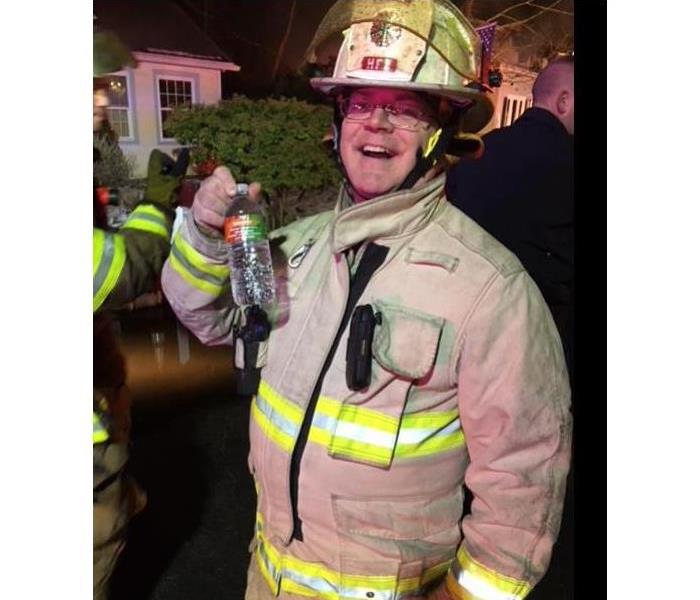 Chief Cassidy relieved fire has been contained, enjoys a refreshing bottle water donated by SERVPRO of Framingham.
Chief Cassidy relieved fire has been contained, enjoys a refreshing bottle water donated by SERVPRO of Framingham.
A vacant home in Holliston was destroyed by a fire the other night. No one was living in the house, but neighbors noticed the flames and called 911 around 8 p.m.
“Fortunately this happened early in the evening,” Fire Chief Michael Cassidy said, “when neighbors were awake, and able to call it in.... Had this been further in the night, it would have been even further developed when we arrived.”
Holliston firefighters were able to keep the blaze from spreading beyond the house at 21 Pearl St., but the home itself was a loss, according to a press release. The top of the home was blackened and filled with gaping holes Tuesday morning, but the windows and doors were boarded up.
SERVPRO of Framingham donated pizza and cider for the annual Holliston Fire Department Holiday Party on the same night the fire broke out. The Fire Department had to leave their party bringing pizza and drinks with them.
Chief Cassidy warned all residents to make sure their smoke detectors are working, and keep an eye on heat sources, particularly keeping heat sources away from combustible items.
Christmas Trees Must Be Hydrated
12/1/2017 (Permalink)
The holiday season is upon is which also translates to many candles and treasured decorations.
Always always be mindful of open flames and never leave candles unattended.
For those who celebrate Christmas, is it also important to keep your tree hydrated.
According to the US Department of Commerce, the National Institute of Standards and Technology (NIST) works to develop better ways to measure things — like, for example, how likely a tree is to burst into flames. The verdict:much more likely if the tree isn’t well hydrated.
Although Christmas tree fires are still considered rare, they do still account for roughly 200 home fires each year, destroying an annual $14 million in the process,the National Fire Prevention Association (NFPA) says. They’re deadly, too, killing an average of six people yearly.
So how do you prevent your tree from going up in flames? First off, definitely don’t light it up on purpose. Believe it or not, that causes about a quarter of the Christmas tree fires, the NFPA says — usually in January. Since heat plus fuel equals fire, it’s also a good idea keep your tree andnon-tree decorationsaway from hot things like candles and heaters.
Second: water your tree, and get rid of it when the needles start to crunch. Evena flaming book of 20 matches couldn’t spark a blazein a well-hydrated, freshly cut Christmas tree. But just 61 seconds after flames licked the needles of a desiccated conifer, the tree was reduced to smoldering branches.The NIST did the experiment, so you don’t have to.
National Fire Prevention Week (Oct 8 - 14) - SERVPRO of Framingham
10/4/2017 (Permalink)
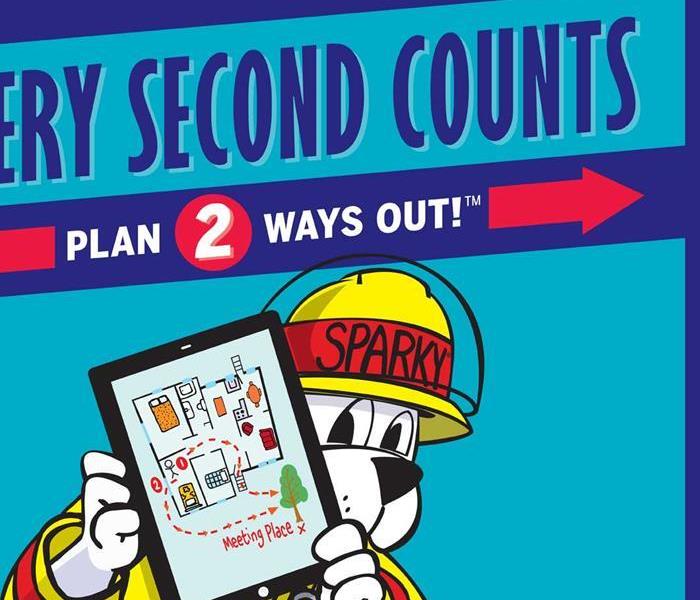 National Fire Prevention Week (Oct 8 -14)
National Fire Prevention Week (Oct 8 -14)
Don’t Wait – Check the Date! Replace Smoke Alarms Every 10 Years
FIRE PREVENTION WEEK has established to commemorate the Great Chicago Fire, the tragic 1871 conflagration that killed more than 250 people, left 100,000 homeless, destroyed more than 17,400 structures and burned more than 2,000 acres. The fire began on October 8, but continued into and did most of its damage on October 9, 1871.
According to popular legend, the fire broke out after a cow - belonging to Mrs. Catherine O'Leary - kicked over a lamp, setting first the barn, then the whole city on fire. Chances are you've heard some version of this story yourself; people have been blaming the Great Chicago Fire on the cow and Mrs. O'Leary, for more than 130 years. But recent research by Chicago historian Robert Cromie has helped to debunk this version of events.
While the Great Chicago Fire was the best-known blaze to start during this fiery two-day stretch, it wasn't the biggest. That distinction goes to the Peshtigo Fire, the most devastating forest fire in American history. The fire, which also occurred on October 8th, 1871, and roared through Northeast Wisconsin, burning down 16 towns, killing 1,152 people, and scorching 1.2 million acres before it ended.
Historical accounts of the fire say that the blaze began when several railroad workers clearing land for tracks unintentionally started a brush fire. Before long, the fast-moving flames were whipping through the area 'like a tornado,' some survivors said. It was the small town of Peshtigo, Wisconsin that suffered the worst damage. Within an hour, the entire town had been destroyed.
Those who survived the Chicago and Peshtigo fires never forgot what they'd been through; both blazes produced countless tales of bravery and heroism. But the fires also changed the way that firefighters and public officials thought about fire safety. On the 40th anniversary of the Great Chicago Fire, the Fire Marshals Association of North America (today known as the International Fire Marshals Association), decided that the anniversary of the Great Chicago Fire should henceforth be observed not with festivities, but in a way that would keep the public informed about the importance of fire prevention. The commemoration grew incrementally official over the years.
In 1920, President Woodrow Wilson issued the first National Fire Prevention Day proclamation, and since 1922, Fire Prevention Week has been observed on the Sunday through Saturday period in which October 9 falls. According to the National Archives and Records Administration's Library Information Center, Fire Prevention Week is the longest running public health and safety observance on record. The President of the United States has signed a proclamation proclaiming a national observance during that week every year since 1925.
Fireworks: Light Up The Sky And Make Sure Nothing Else!
7/13/2017 (Permalink)
Fireworks is part of our Independence Day tradition painting the sky on the evening of the 4th of July and all through the summer.
Unfortunately as they shoot upward so do injuries, fires and the resulting home insurance claims. Although your basic homeowners' insurance covers fires, your policy is not likely to cover fires caused by fireworks your family sets off, particularly in states where they are deemed illegal which includes our great state of Massachusetts.
July 4th is the one day of the year with the highest number of fires reported according to the National Fire Protection Association. More than half of these fires are caused by people shooting off rockets in their own backyard. On average, fireworks cause over 18,500 fires a year, including 1300 structure fires, 300 vehicle fires, and 16,900 outside fires with an average of $43 million in direct property damage according to the Consumer Product Safety Commissions Fireworks Annual Report (2015).
Even if your state permits the use of fireworks, you may want to rethink whether that would be a wise decision. Instead of a 'do-it-yourself' fireworks show, your family could sit back, relax and enjoy the display so many local towns host. And you have the added benefit of knowing your family is not in harm's way.
Summer Barbecue Safety Tips Keep it Fun Not Frantic!
7/13/2017 (Permalink)
Summertime is synonymous with grilling and barbecues. There is no better way to spend the day with family and friends in the comfort of your backyard on a hot summer night than a tasty barbecue made up of good food, good cooks and good company in a great atmosphere. However it is important we take precautions when dealing with open flames and propane gas. Here are some simple Dos & Don'ts to ensure a safe and enjoyable time. Here is What You Should Do: 1. Keep you grill at least 10 feet away from your home, the further the better. Also ensure grills are not underneath wooden overhangs.2. Make sure you clean your grill on a regular basis. Grease and fat buildup will provide more fuel to the fire.3. Always check for gas leaks. By simply rubbing soapy water on the gas hose and connections, you will be able to determine if there is a gas leak. If the soap begins to form large bubbles there is a leak.4. Keep decorations away from your grill. Summer décor like hanging baskets and banners look nice but they are flammable items and should be kept at a good distance.5. Keep a spray bottle of water handy for minor flare ups.6. Keep a fire extinguisher within a couple of steps from the grill and make sure you know how to use it in the event of a larger fire. And Now For What You Should Never Do: 1. Never turn on the gas while the grill lid is closed. This is a huge No-No as a closed lid filled with gas will cause an explosion when the lid is opened and the gas is exposed to oxygen.2. Never leave a grill unattended to avoid unintended consequences.3. Never overload your grill with fatty meats that drip on the flames and cause a flare-up. 4. Never use a grill indoors, its design as an outdoor kitchen!
How To Prevent Attic Fires
5/18/2017 (Permalink)
Did you know that more than 40% of attic fires are the result of electrical malfunctions?
So how do we help prevent an attic fire? Here are three things firefighters suggest you hire have a professional to do:
- Have your chimney inspected by a professional who will check the interior and exterior of the chimney, including the part running through the attic
- Check the wiring in your attic, preferably by an electrician, looking for signs of damage, cracked insulation (wire sheathing), and exposed or disconnected wires
- Look for signs of burning and charring in the insulation and wood
A common mistake is that everybody typically plugs in their space heaters to help supplement their heat. And then, they'll put them on a long extension cord so that they are able to reach areas with less heat. So, the longer the extension cord is, the more ampage it will draw on the circuit.
Another common fire hazard is that homeowners choose voltage incandescent light bulbs in ceiling fixtures that is a higher voltage than required is also a fire hazard. That heat that is trapped within the light fixture goes straight up into the attic and in the wires and essentially cook the wires, starting a fire.
The Unexpected Dangers of a Hoverboard
5/18/2017 (Permalink)
This popular high tech toy have proven to be deadly. Federal officials urge consumers to use caution when buying or using self-propelled hoverboards after one of the devices is blamed for causing a deadly house fire in Pennsylvania.
The Consumer Product Safety Commission (CPSC) recalled more than 500,000 hoverboards made by 10 retailers warning that the products did not meet federal fire safety standards. Additionally, the CPSC has investigated more than 60 hoverboard fires since the fall of 2015.
In their initial recall announcement, the CPSC said that the affected hoverboards used lithium-ion battery packs that which can overheat thus creating a risk of the hooverboard smoking, catching on fire or even causing an explosion.
Consumers are urged to check hoverboards to see if they comply with federal standards. They need to look for a sign or confirmation that the products are certified by UL, a safety consulting firm formerly known as Underwriters Laboratories.
With this UL safety seal, it helps reduce the potential fire and hazards and will greatly decrease the probability of an incident. The UL standard has many tests that focus on lithium ion battery safety. While hundreds of models have undergone and passed the strict safety requirements, more the 250,000 hoverboards have been recalled to replace faulty battery packs.
How to Safely Dispose Oily Rags
4/3/2017 (Permalink)
With warmer weather approaching, home improvement projects will be on the rise. In an effort to make everything look new again for another summer, we re-stain outdoor furniture and prime the deck for a nice appearance at our summer barbecues. “Do-it-yourselvers” take heed! There is a grave danger inherent in using oil based products that you may not be aware of. If you do not properly dispose of the oily rages after use, you are rolling the dice for a potential disaster. Discarded rags left unattended and not contained have the potential to cause spontaneous combustion which leads to fire.
You are done with your project; you toss oil soaked rags without giving it a second thought. What most people who use these products do not know, is that when a substance like linseed oil is left on a cotton rag and left in the open air, a chemical reaction takes place. The rag actually heats up to almost 400 degrees as it is in the process of drying. And believe it or not, there is no spark needed to cause this devastating fire. It is so important to be aware of these products and to always carefully read all the instructions, no matter how small the print, before you even open the container to use the product. You need to know the instructions on proper disposal of the rags, as well as how to secure the container after the job is done. Besides linseed oil, other culprits include flaxseed, sunflower and soybean oil, coal, charcoal, hay, compost piles, piles of manure, paint thinners, oil-based paints are all susceptible to spontaneously combusting.
So the next time you’re ready to tackle a do-it-yourself project or to hire a contractor to do a job with an oil based product, make sure the rags are properly stored in a metal can filled with water and an oil breakdown detergent with a secure lid. Then you will be able to dispose of the closed can of rags when your town sponsors a hazardous waste collection day. This one simple act can save you from the despair of a preventable fire. If you research fires caused by oil-based products online you will be amazed at how easily these fires get started and rage out of control. One example online described a handyman who had an oily rag in the back pocket of his work overalls when the rag dried out by the sun caught fire and burned him.
The 24-hour emergency services provided by SERVPRO Framingham and SERVPRO Newton / Wellesley comes to your rescue when you need them, ready to help using their water and fire damage training as well as their wide range of knowledgeable expertise. They will get you through a difficult experience. Once the fire department leaves the scene, you may be left with a non-functioning business or residence because of water damage caused by firefighting efforts. We have the specialized fire and water damage restoration training, personnel, and equipment to handle fire and water damage and the ability to efficiently restore your business or residence to pre-fire condition.
Common Causes of Wildfires
3/28/2017 (Permalink)
A wildfire is the potentially deadly catalyst that starts as an uncontrolled fire in a large undeveloped and un-populated area. If the response to these fires is not timely they can quickly get out of control and end up destroying homes and agriculture and killing animals and human life in their path. As many as 90 percent of wildland fires in the United States are caused by human carelessness or criminal intent. An unattended campfire, the burning of debris, negligently discarded cigarettes as well as intentional acts of arson are some of the ways that people cause tragedy. Wildfires can also be caused by an accumulation of dead matter (leaves, twigs, and trees) that create enough heat in some instances to spontaneously combust and ignite the surrounding area. Man-made combustion from arson, carelessness and lack of fire safety cause wildfire disasters every year. However, weather conditions contribute to the occurrence of wildfires as well. Lightning strikes or extended dry spells causing drought are weather related agitators. Lightning strikes the earth over 100,000 times a day and 10 to 20% of these lightning strikes can cause fire. An average of 1.2 million acres of US woodland burn every year. And sadly a large wildfire is even capable of modifying the local weather conditions and producing its own weather.
Summer is coming and many of us will be camping in the woods. We have known Smokey the Bear all our lives and have the responsibility to share his critical message with the next generation of campers. I love the commercial where Smokey comes out of the woods and gives a young camper a hug for carefully putting out his campfire. You can't help but smile. The message is stated subtly but is a good reminder of the detailed instructions Smokey has provided for years on how together we can prevent foret fires. As Smokey advises, keep campfires at a managemable size, allow wood to burn to ash completely, and pour a substantial amount of water on all embers until hissing sound stops. If you do not have water, stir up the dirt or sand into the embers with a shovel and bury the fire making absolutely sure no embers are exposed and still smoldering. One last word of caution from the Bear who knows, “If it’s too hot to touch, it’s too hot to leave.”
Common Causes of House Fires
2/22/2017 (Permalink)
During the winter holidays we tend to be more vigilant about fire safety but homeowners must be aware of obstacles to fire safety all year and particularly in the cold weather months. In the winter months, people spend more time indoors and more time inside increases the risk of house fires. According to the National Fire Protection Association (NFPA) more than 360,000 home structure fires each year which is equivalent to $6-8 billion dollars in damage. Those figures are astounding and you don’t want to be a part of those statistics when these tragedies are preventable. With foresight and good judgement, homeowners can minimize these risks. Take a look at these common fire hazards in your home defined by the National Fire Protection Association and ask yourself, guilty or not guilty?
- Candles: Do you light candles and walk away?
While the glow and aroma creates the perfect ambience, candles are best enjoyed outside or used with precaution. Never leave a candle unattended or less than 12 feet from an object. Better yet a battery operated candle is extremely safe, never burns out and gives off that soft glow.
- Smoking: Do you allow smoking in the house?
Another reason why smoking is not such a great idea, it is the second leading cause of house fires. The good news, smoking is on a downward trend and with the help of recent regulations of nonflammable household items such as couches, mattress, pajamas, that has also decreased house fires caused by cigarettes. Though ironically the older you are the likelihood you will experience a house fire related to cigarettes increase. Individuals killed in a house fire were 65 and older. Try smoking outside instead.
- Electrical & Lighting: Are you confident the electricity in your house is safe?
There are numerous causes for electrical fires; an overloaded circuit and extension cords, an overheated light bulb, space heaters, faulty wiring and appliances. To minimize risk, don’t overload outlets, make sure you use inside cords for inside and heavy duty/outside cords for outdoors. Never leave Christmas lights or halogen lights overnight or on when not at home and consider hiring an electrician to make sure wiring is in place.
- Dryers & Washing Machines: Have you checked the lint tray in the dryer lately?
Clothes dryer and washing machine fires are more common than one might realize. The most common cause for dryers are lint trays and cable insulation for washing machines. Make sure you clean the lent screen before and after every use. Double check lines for gas and propane dryers. Vent the dryer to the outside and ensure nothing is blocking the vent. Clean the vent pipe on a regular basis and keep area around the dryer free of combustible materials.
- Lightning: Do you know the inside dangers of lightning?
Fires caused by lightning are most likely to occur in June, July and August in the late afternoon. Lightning can also be the cause of wildfires. Stay away from doors and windows during an electrical form. Do not use electrical equipment during storms. Avoid using faucets and baths during a thunderstorm.
- Children playing with fire: Do you keep fire hazards out of reach ?
Children the age of six and under are most likely to start a fire using matches or a lighter. Make sure to keep matches and lighters out of the reach of children, teach them fire safety at a young age and make sure children are always supervised.
- Christmas Trees: Do you know the dangers associated with decorations?
Christmas tree fires cause an average of $18.3 million in property damage each year. Keep live Christmas trees well watered and dispose them before they become too brittle and dry. Turn Christmas tree lights off before leaving the house or going to bed. Make sure they are a safe distance from any heat source.
- Cooking: Do you make a habit to check the stove while cooking and before leaving the house?
Another leading cause of house fires is cooking and easy to get distracted when something is simmering on the stove. Always be vigilant when cooking and never leave items on a stove unattended. Never put a grease fire out with water, instead place a lid on the pan to smother the fire. If fire occurs in the oven, keep oven door shut until fire extinguishes itself. Keep flammable items away from oven and always have a fire extinguisher in kitchen.
SERVPRO of Framingham To The Scene
12/14/2015 (Permalink)
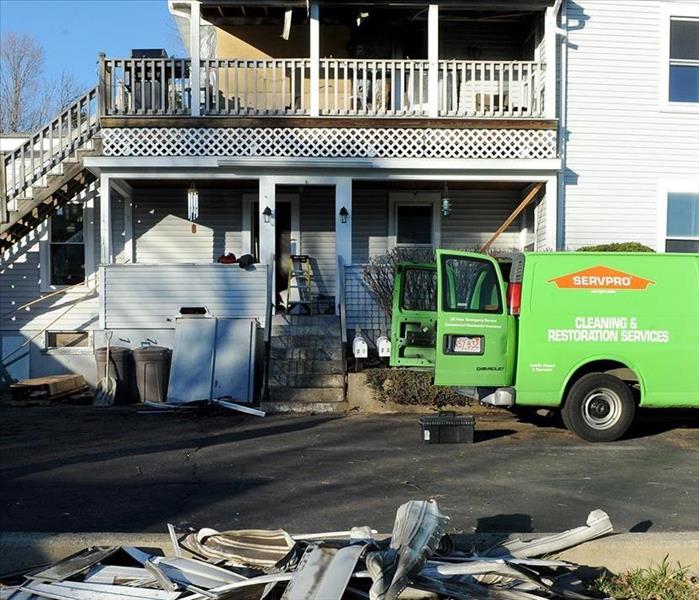 SERVPRO on site to assist with the cleanup and restoration process.
SERVPRO on site to assist with the cleanup and restoration process.
SERVPRO of FRAMINGHAM was called to the scene of a fire that was spotted in the early morning hours by a neighbor. No one was injured. The original newspaper article is below.
ASHLAND — Fire officials say they are grateful for a man walking his dog early Monday morning who spotted flames on a second-floor porch of a Tilton Avenue home, then banged on the building to wake up residents in two apartments.
Doug Duval said he was walking his miniature pinscher Ruby around 5 a.m. when he saw the fire at 25-27 Tilton Ave. It was dark outside and the Christmas lights looked strange, he said.
"When I got a little closer I could see it was fire," he said. "There were 10-foot flames shooting up the wall."
He tied Ruby to a fence on the property and jumped into action.
"I started banging on the side of the house yelling, 'fire, fire, fire!'" he said. "I woke the whole neighborhood."
A neighbor called 911 as the two apartments were quickly evacuated. The first floor homeowner and a neighbor got a fire extinguisher out of the garage to fight the flames, Duval said.
The Ashland Fire Department arrived to finish the job. Nobody was injured in the home and the fire was contained to the porch, according to fire Lt. David Iarussi. The neighbor who helped douse the flames was taken to MetroWest Medical Center in Framingham for a smoke-related evaluation.
Iarussi said the state fire marshal's office determined the cause to be careless disposal of a cigarette.
"The fire would have been much worse if it spread inside the house and the fire alarm went off," he said. "We wouldn't have known until the fire alarm went off."
Fire Chief Scott Boothby said it was a "good catch" by Duval, and the fire was mostly out within 15 minutes.
"Luckily, someone was walking by at the time," he said. "It wouldn't have taken too much more. A few more minutes it would have extended into the house and attic. It was just starting to burn the roof of the porch."
He said a Hopkinton engine and Framingham ambulance responded to the scene for mutual aid. Sherborn firefighters covered the Cedar Street Station.
The first-floor homeowners were allowed to return, while the second-floor tenants were temporarily displaced until a company could clean up, Boothby said.
He said a similar situation happened on Trailside Way a couple of months ago when a person walking by reported a fire. That fire also was determined to be caused by a cigarette, he said.
He encouraged residents to make sure smoking materials are put out properly.
 We understand the devastating impact of fires and are committed to helping you take proactive steps to prevent them.
We understand the devastating impact of fires and are committed to helping you take proactive steps to prevent them.





 24/7 Emergency Service
24/7 Emergency Service









































